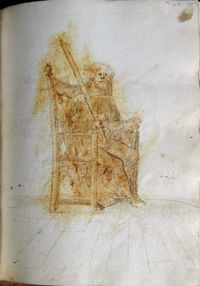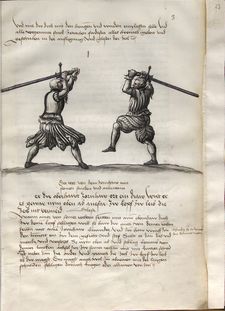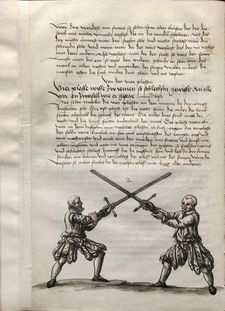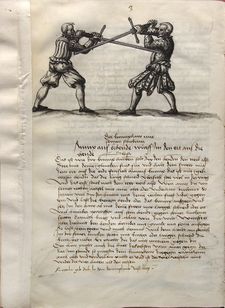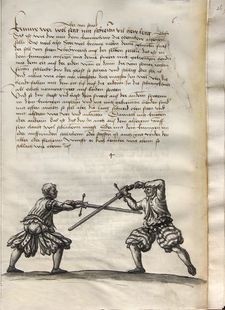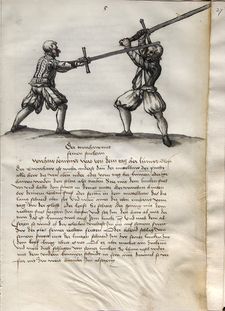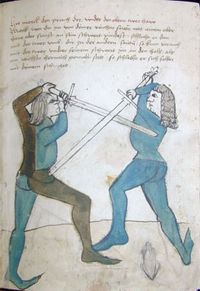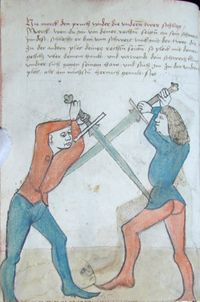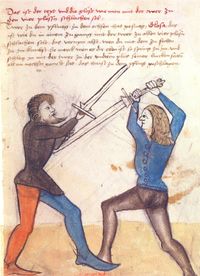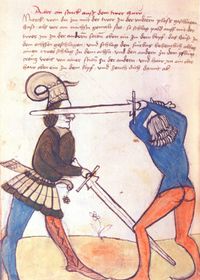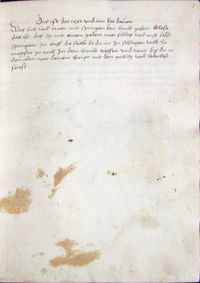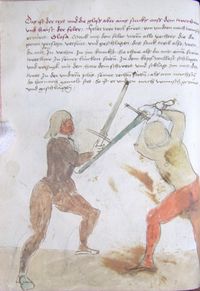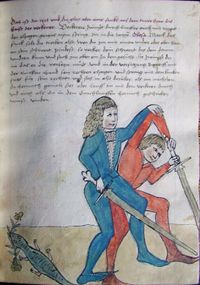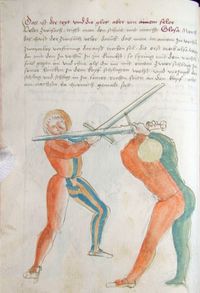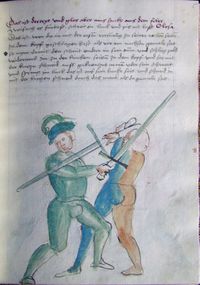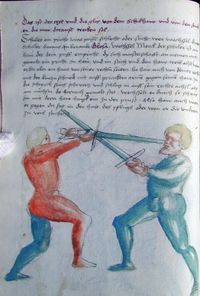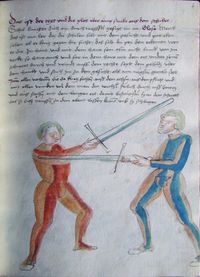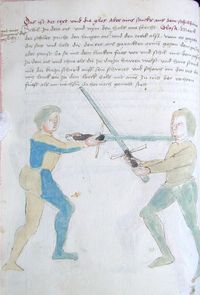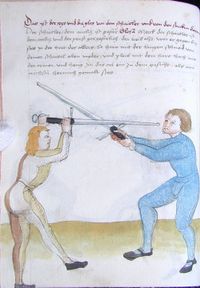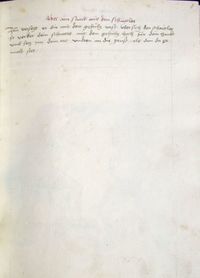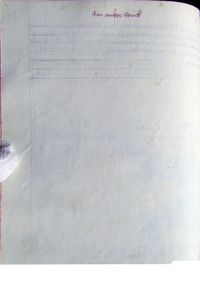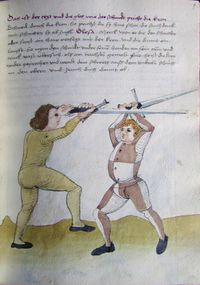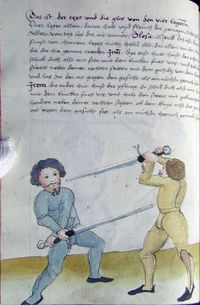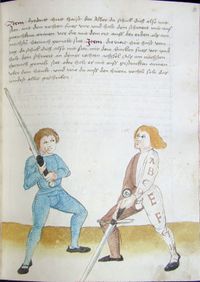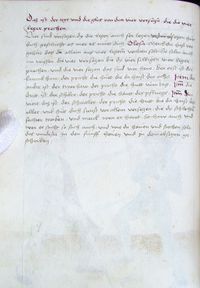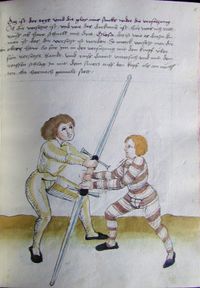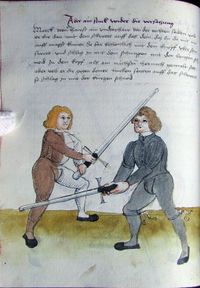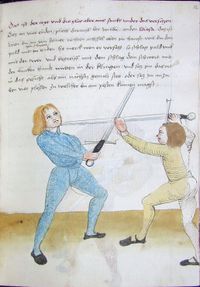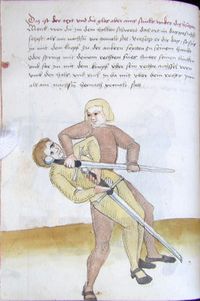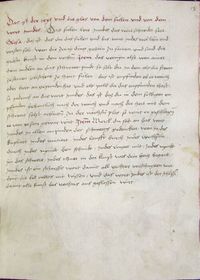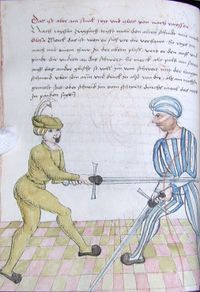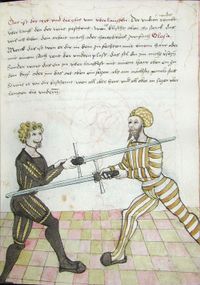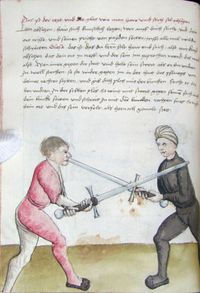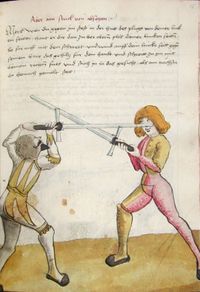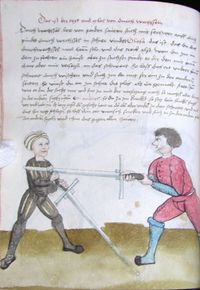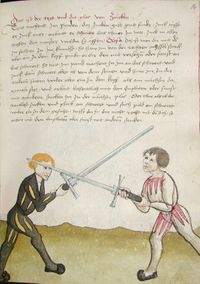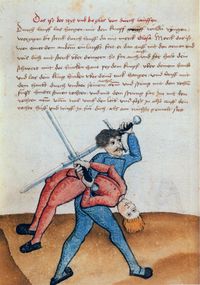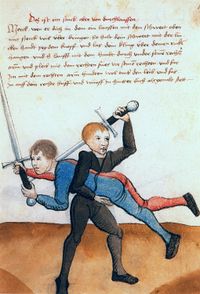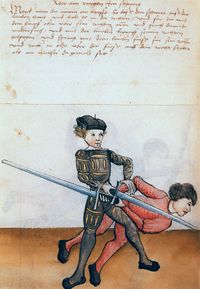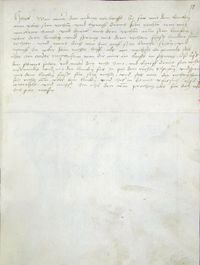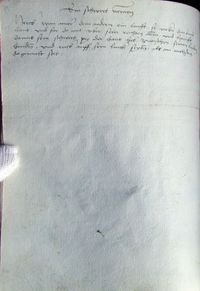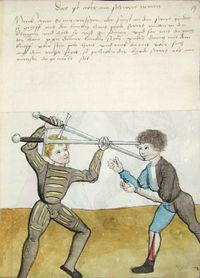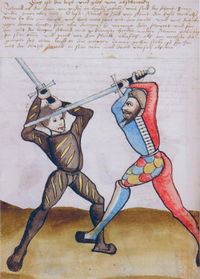|
|
You are not currently logged in. Are you accessing the unsecure (http) portal? Click here to switch to the secure portal. |
Difference between revisions of "Sigmund ain Ringeck"
| Line 1: | Line 1: | ||
| − | {{ | + | {{ambox | text=The [[Universitätsbibliothek Augsburg]] has rejiggered their online image gallery system, and all links to their manuscript scans are currently broken. While we address this problem, you can navigate to the scans through this portal: [http://digital.bib-bvb.de/R/UR7TVGY1T24FRJFGNT8ABRL9KUJKCDLMALY9E3LIUANI3XSIXL-00666?func=collections-result&collection_id=2649 Universitätsbibliothek Augsburg Digitale Sammlungen]. }} |
| + | {{infobox writer | ||
| name = [[name::Sigmund Schining ein Ringeck]] | | name = [[name::Sigmund Schining ein Ringeck]] | ||
| image = File:Sigmund Ringeck.png | | image = File:Sigmund Ringeck.png | ||
Revision as of 16:51, 19 November 2014
|
|
The Universitätsbibliothek Augsburg has rejiggered their online image gallery system, and all links to their manuscript scans are currently broken. While we address this problem, you can navigate to the scans through this portal: Universitätsbibliothek Augsburg Digitale Sammlungen. |
| Sigmund Schining ein Ringeck | |
|---|---|
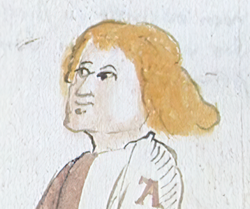 | |
| Born | date of birth unknown |
| Died | before 1470 |
| Occupation | Fencing master |
| Nationality | German |
| Patron | Albrecht, Duke of Bavaria |
| Movement | Society of Liechtenauer |
| Influences | Johannes Liechtenauer |
| Influenced | |
| Genres | Fencing manual |
| Language | Early New High German |
| Manuscript(s) |
Codex I.6.2º.5 (1539)
|
| First printed english edition |
Tobler, 2001 |
| Concordance by | Michael Chidester |
| Translations | |
Sigmund Schining ein Ringeck (Sigmund ain Ringeck, Sigmund Amring, Sigmund Einring, Sigmund Schining) was a 14th or 15th century German fencing master. While the meaning of the surname "Schining" is uncertain, the suffix "ain Ringeck" may indicate that he came from the Rhineland region of south-eastern Germany. He is named in the text as Schirmaister to Albrecht, Count Palatine of Rhine and Duke of Bavaria. Other than this, the only thing that can be determined about his life is that his renown as a master was sufficient for Paulus Kal to include him on his memorial to the deceased masters of the Society of Liechtenauer in 1470.[1]
The identity of Ringeck's patron remains unclear, as four men named Albrecht held the title during the fifteenth century. If it is Albrecht I, who reigned from 1353 to 1404, this would signify that Ringeck was likely a direct associate or student of the grand master Johannes Liechtenauer. However, it may just as easily have been Albrecht III, who carried the title from 1438 to 1460, making Ringeck a second- or third-generation master carrying on the tradition.[2] Albrecht IV claimed the title in 1460 and thus also could have been Ringeck's patron; this seems less likely in light of Ringeck's apparent death within that same decade, meaning the master would have had to have penned his treatise in the final few years of his life. In its favor, however, is the fact that Albrecht IV reigned until 1508 and so both the Dresden and Glasgow versions of the text were likely created during his reign.
Ringeck is often erroneously credited as the author of the MS Dresden C487. While Ringeck seems to be the author of one of the core texts, complete glosses of Liechtenauer's epitome on longsword fencing and armored fencing as well as a partial gloss of his mounted fencing, the manuscript is an anthology of treatises by several different masters including Andre Liegniczer and Ott Jud, and it is currently thought to have been composed in the early 16th century[3] (well after the master's lifetime). Regardless, the fact that he authored one of the few complete glosses of Liechtenauer's text makes Ringeck one of the most important masters of the 15th century.
While it was not duplicated nearly as often as the more famous gloss of Pseudo-Peter von Danzig, Ringeck's work nevertheless seems to have had a lasting influence. Not only was it reproduced by Joachim Meÿer in 1570 in his final manuscript, but in 1539 Hans Medel von Salzburg took it upon himself to create an update and revision of Ringeck's Bloßfechten gloss, integrating his own commentary in many places.
Contents
Treatise
| Images | English Translation (from the Dresden) |
Dresden Version | Glasgow Version
by Dierk Hagedorn |
Rostock Version
by Anonymous |
Hans Medel Fechtbuch | |||||
|---|---|---|---|---|---|---|---|---|---|---|
| [1] Here begins the explanation of the epitome.
In which lies recorded the knightly art of the longsword, composed and formed by Johannes Liechtenauer, who was a great master in the art, may God be merciful to him. He wrote the markverses with deep and hidden words, so that the art would not be widely known. And these deep and hidden words have been by Master Sigmund ain Ringeck, fencing master to the highborn prince and noble Lord Albrecht, Count Palatine of Rhine and Duke of Bavaria, recorded and explained in this little book which now follows, so that every fighter who otherwise can fight, shall be able to take these and understand them. |
[10v] Hie hept sich an die vßlegu~g der zedel
in der geschriben stett die Ritterlich kunst des langes schwerts Die gedicht vnd gemacht hat Johannes lichtenawer der ain grosser maiste~ in der kunst gewesen ist dem gott genedig sÿ der hatt die zedel laußen schrÿbe~ mitt verborgen vñ verdeckte~ worten Daru~b dz die kunst nitt gemain solt werde~ Vnd die selbige~ v°borgneñ vñ verdeckte wort hatt maister [11r] Sigmund ain ringeck der zÿt des hochgeborne~ fürsten vñ herreñ herñ aulbrecht pfalczgrauen bÿ Rin vñ herczog in baÿern schirmaiste~ Glosieret vñ außgelegt alß hie in disem biechlin her nach geschrÿben stät dz sÿ ain ÿede~ fechter wol verömen vnd vestan mag der da ande~st fechten kan ~ |
[22r] Merck die zettl /
dar in geschribñ stett / die kunst des langen schwerch die Johannes liechtñawen hat lassen schreiben mit verporgen vnd verdachtñ wortñ / die |
[6r] Hie hebe[t] sich an die Zedttel
In den geschrieben stedt die Ritterlich kunst, des langen schwerts die gedicht und gemacht hat Johannes Liechtennauer der ein großer meister In der Kunst gewesen ist. Dem gott gnedig sey, der hatt die Zedel laßen schreiben mitt verborgen unnd verdackten wortten, darumb das die kunst nicht gemeyns soll werden, und die selbigen verborgen und verdackten worten der Zedel, Die hat meißter Sigmundt Einring zu der selbigenn zeit der hochgeborren fürsten und herren herrn Albrechts Pfalzgraff bey Rein und herzog in Bayer{n} sein schiermeißter gewesen ist, also glossirt unnd ausgelegtt, als sie den in diesem büchlein hernach geschrieben und gemalt sthan, das sie ein jeder fechter wol vernomen und verstehen mag, der da anderß recht fechten kann. |
[21r] Hie hebt sich an die zetl
in der geschribenn stet die ritterliche kunst des langen schwertes die geticht und gemacht hat Iohannes Liechtenawer der ain grosser maister in der kunst ist gewesen dem got genad Der hat die zetl gechriben und geticht mit verporgen verdeckten worten darumb das die kunst nit gemain soll werden und die selben verporgen und verdeckten wort der zetl hat maister Sigmund Schining der diser zeit des hochgeboren fürsten und herren Herrn Albrechtz pfaltzgraue bey Rein und hertzog in Baiern schirmmaister gewesen ist Also glosirt und ausgelegt Als dann in disem buch hernach geschriben steet das ain ieder vechter wol vernemen und versteen mag der anderst recht vechtenn kan Und darnach auch von andern maistern gemert und gebessert und besunder durch maister Hansen Medel von Saltzburg wie dann hye nachvolget | ||||||
[2] Foreword to the epitome.
|
Die vor red der zedel ~
Jungk ritter lere |
Das ist die vorredt
Junckh Ritter lerne |
Das ist Die vorrede
Iunckritter lere / | |||||||
[3] Many good general lessons about the longsword.
Glosa This is the longsword's first lesson; that you shall learn to cut properly from both sides, so that you can fight strongly and correctly. When you want to cut from the right side, stand with your left foot forwards; and when you want to cut from the left side, stand with your right foot forwards. If you cut with an Oberhau from the right side, follow after the cut with your right foot. If you do not do this then the cut is poor and insincere, because your right side lingers behind. Then the cut becomes too short and cannot follow the correct arc down towards the other side, in front of the left foot. |
Das ist der text von vil gu°tter gemainer lere des langen schwerts
Willtu kunst schowen Glosa Merck dz ist die erst lere des [12r] langes schwercz dz du die hew võ baÿden sÿtten recht solt lernen hawen Ist dz du annders starck vñ gerecht fechten wilt Dz ver nÿm allso Wenn du wilt howe~ von der rechten sÿtten So sich dz dein |
[6v] Das ist der Textt [top of word cut off] von viel gutten gemeinen lere des lang[en] schwerrdts.
Glosa. Merck das ist die erste lere des langen schwerdts das du die Heue von beyden seitten recht solst lernen hauen. Ist das du anderst starck und gerecht fechten wilt, das vernym also wen du wilt hauen, von der rechten seitten, so sieh das dein lingker fuß for stee, hastu dan den oberhauw von der rechten seiten, so volge dem haw nach, mit dem rechten fuß, thustu das nicht so ist der haw falsch und unrecht, wenn dein rechte seiten bleibet da hindern, darumb ist der haw zu kurtz und mag seinen rechten ganng under sich zu der anderenn seiten vor dem lincken fusß nicht gehaben, |
Das ist der text von vil guter gemainer lere des langen swertz
Glosa Merck das ist die erst lere des langen schwertz das dw die hew von baiden seitten recht solt lernen hawen ist das dw anderst starck und recht vechten wilt das vernym also Wann dw wilt hawen von der rechten seitten So sich das dein lincker fueβ vor stee Hawstu dann den oberhaw von der rechten seitten so volg dem haw nach mit dem rechten fueβ Thustu das nit [21v] So ist der haw falsch und ungerecht Wann dein rechte seitten pleibt da hinden so ist der haw zekurtz und mag sein rechten gang undersich zw der andern seitten vor dem lincken fueβ nit gehaben | |||||||
| Similarly the cut is incorrect if you strike from the left side and do not follow after the cut with the left foot. So mark well, from which side you strike, that the foot follows after the cut. In this manner you can perform all of your techniques correctly and with strength. And in the same way should all the other cuts be performed. | Des glÿchen wenn du haw°st von der lyncken sÿtten vnd dem haw nicht nachfolgest mitt dem lincken fu°ß so ist der haw° och falsch Daru~ so merck von welcher sÿtten du haust / dz du mitt dem selbige~n fu°ß haw° nachfolgest so magstu mitt sterck alle dein stuck gerecht trÿbeñ Vnnd also süllen alle andere hew° [13r] och gehawen werden ~:• | deßgleichen wen du haußt von der lincken seiten, und dem haw nicht nachvolgest mit dem lincken fusß, So Ist der haw auch falsch. Darumb so merck von welcher seitten du hawest, das du mit dem selbig fusß, dem haw nachvolgest, so magstu mit stercke alle deine stucke gerecht treiben, und also sollen all ander hew auch gehauen werdenn. | Desgleichen wan dw hawst von der glincken seitten und dein haw nit nachvolget mit dem glincken fueβ so ist der haw auch falcsh Darumb merck von welcher seitten dw hawest das dw mit dem selben fueβ dem haw nachvolgest so magstu mit sterck alle deine stuck gerecht treiben und also sollen auch all ander hew gehawen werdenn | |||||||
[4] A further lesson.
Glosa When you come against him in Zufechten you shall not await his attack, and neither shall you wait to see what he is thinking about doing to you. All fencers who are hesitant and wait for the incoming attack, and do nothing other than to ward it away, they gain very little joy from this sort of practice because they are often beaten. |
Der text aber võ aine~ lere
Glosa Wenn du mitt dem zu°fechten zu° im kumpst so solt du vff sein hew nicht sechen noch warten wie er die gegen dir trÿbt wann alle fechte~ die do sechen vñ warten vff aines anderen hew Vnnd wellend anderß |
Der Text aber von einer Lehre
[7r] Glosa. Mercke das ist wen du mit dem Zufechten zu im kumbst, so soltu auff sein hew nicht sehen auch nicht wartten, wie ehr die gegen dir treybet wann alle fechter, die da sehen und wartten, off einer anderen hew, unnd wöllen anderst nicht thun, wen versetzeen die bedurffen sich solcher kunst wenig freuen wann sie werden dabey offtt geschlagen. |
Aber Ain text von ainer lere
Glosa Wann dw mit dem zuvechten zw ainem kumbst so soltu auff seinen haw nit sehen noch warten wie er die gegen dir treibt Wann all vechter die da sehen und warten auff aines andern haw und wöllent anderst nicht thun dann versetzen die sollen sich solcher kunst wenig freyen wann die werden da bey offt geschlagen | |||||||
| [5]
Always fight with the strength of the whole body! Cut close into him, to the head and to the body, so he cannot change-through in front of your point. And when the cut ends up in the bind you shall not hesitate but shall quickly and fluently make attacks against the nearest opening, using the five strikes and other techniques that will be described later. |
Item du solt mercken alles dz du fechten wilt dz trüb mitt ganczer störck deines lÿbs Vnnd haw im do mitt nahent ein zu° kopff vñ zu° lÿb so mag er vor dinem ort nicht durch wechslen Vñ mitt dem haw° solt du im den anbinden des schwerts der |
Item merck allso was du fechten willt, das treib mit gantzer sterk deines leybes, unnd haw im damit nahe[n]t zu dem kopf, und zu dem leyb, so mag ehr von deinem ort nicht durch wech seln und mit dem haw soltu in denn anbinden der schwerdts der Zweck rur nicht vermeyd denn zu der negsten blöße die dir hernach in denn funff hewenn und In anderen stucken ausgericht wordenn. |
Darumb schlah und stich die plösse
Item auch merck Alles das dw vechten wilt das treib mit gantzer sterck deines leibs und haw damit nahent ein zw kopf und zw leib So mag er vor deinem ort nit durchwechseln Und mit dem haw solt in dem anpinden des swertz der zeck nit vermeiden zw der nechsten plösse Die hernach in den fünf hewen und andern stucken aufgericht werden | |||||||
[6] Another lesson.
Glosa This lesson applies to two types of people: those who are left-handed and those who are right-handed. When you come against him in Zufechten, if you are right-handed and want to strike him, you must not throw your first cut from your left side. That is because this is weak and cannot bring strength to bear if he binds the strong of his blade against you. Therefore, cut from your right side, so you can be strong and skillful in the bind and can do as you will. Similarly, if you are left handed, do not cut from the right, because the art is pointless when a left-hander tries to fence from the right side. Likewise this statement applies to a right-hander fencing from the left side. |
aber ain lere
Glosa Mörck die lere trifft an zwu° personen aine~ lincken vnd ain grechten / |
Aber ein lehre.
Glosa. Merk die lehre trifft on zwo p{er} son einen lingken und einen rechten, und das vernym also wan du mit zufechten zu im kumbst, bistu den gerecht, und meinst, den man zu schlagen, so haw den rechten haw nicht, von der lincken seyten, wan ehr ist schwach und magst damit nit weyderhalten wan man dir starck darauffbindt darumb so haw von der rechten seiten so magstu starck am schwerd mit kunst arbeiten was du wilt, desßgleichen bistu lingck so haw auch nicht von der rechten seitten, wann die kunst ist gar wildt einem lincken zu treyben, von der rechten seiten desgleichen ist sie auch einen rechten von der lincken hanndt. |
Aber ain text ainer lere
Glosa Die lere trifft an zwo person ainen lincken und ainen rechten das vernym also wann dw mit ainem zuvechten kummest bistu gerecht und vermainst den man zeschlagen so haw den ersten haw nit von der lincken seitten wann der ist schwach und magst domit nit widerhalten wann man dir starck darauff [22r] pindet Darumb haw von der rechten seitten So magstu starck an dem swert mit kunst arbeitten was dw wilt Desgleichen bistu linck so haw auch nit von der rechten seitten Wann die kunst ist gar wild ainem lincken zetreiben von der rechten seitten desgleich ist auch ainem rechten von der lincken seitten | |||||||
[7] A lesson about "Before" and "After".
Glosa Mark well that more than anything else you must understand "Before" and "After", because these two concepts are the grounding from which all fencing comes. |
Daß ist der text vñ lere ain lere von vor und nach
Glosa Merck dz ist dz du vor allen sachen wol solt verston daß vor und daß nach / wann die zwaÿ ding sind ain vrspru~g do alle kunst des fechtenß außgät |
Ain text ainer lere von dem vor und nach
Glosa Das ist das dw vor allen sachen solt recht versteen und vernemen die zwai ding das ist das vor und das nach Darnach swech und sterck des swertz und des wortz indeβ darauβ kumpt der gantz grundt und ursprung aller kunst des vechtens Wann dw die ding recht vernimbst und vorauβ das wort indeβ nit vergist in allen stucken die dw treibt bistu wol ain guter maister | ||||||||
| [8]
Mark also: "Before" means that you shall always perform a strike or thrust against his openings, before he does the same to you. Then he must defend against you! And work deftly both in the defence and in moving your sword from one opening to another, so he cannot have the chance to perform his own techniques between yours. But if he rushes in close to you, deal with him through wrestling. |
Daß vernÿm also Daß |
Das vor
Das vor ist das dw albeg vor kummen solt ob du wolt mit ainem haw oder mit ainem stich im zw der plösse ee wann er dir zw deiner plösse So muβ er dir versetzen So arbait in der versatzung behentlich für dich mit dem swert von ainer plössen zw der anderen So mag er vor deiner arbait zw seiner nicht kummen Aber laufft er dir ein so khum vor mit dem ringen oder ort lauffen | ||||||||
| [9] Mark, that which is called "After".
Mark, that if you cannot come in the "Before", wait for the "After". This will defeat all techniques that he does against you. When he comes at you so that you must defend yourself against him, so work deftly "in the Instant" with your defence against his nearest opening, so strike him before he can finish his technique. Thus you win the "Before" and he is left in the "After". You shall also know how you can use "the Instant" against his "weak" and "strong" parts of the sword. |
Hie mörck was da haÿsst daß nach
Mörck magstu zu° dem vor nitt kom~en So wart uff dz nach dz sÿnd die brüch uff allen stu°ck die er vff dich trÿbt |
Das Nach
Das nach ist so dw dem vor nit kummen magst oder sunst nit dem nemen wöllest so wart auf das nach das send die prüch auff alle stuck die er auf dich treibt das vernim also wann er vor kumbt das dw im versetzen must So arbait mit der versatzung indeβ behentlich für dich zw der nächsten plösse So triffstu in ee wann er sein stuck verbringt Also gewinstu aber das vor und er pleibt nach Auch soltu in dem nach und in dem vor mercken wie dw mit dem wort indeβ arbaiten solt nach swech und nach | ||||||||
| [10]
From the hilt of the sword to the blade's centre the sword is "strong", and with this you can meet against his blade when you bind against it. And further, from the middle to the point the sword is "weak", which should not be brought against his blade. And when you really understand these things you can work skillfully and defend yourself well, and later teach princes and lords, so that they with these same skills can protect themselves well in play and earnest. But if you become frightened easily you should not learn fighting arts, because a weak and frightened heart—it does not help you—it defeats all of your skills. |
der störck seines schwertß
Vnd das vernÿm Also Von dem gehulcze des schwerts |
sterck seines swertes
und das vernym also Von dem gehiltz des swertz biβ in die mitte der klingen hat das swert sein stercke damit dw wol magst widerhalten wann man dir darein pindet und fürbaβ von der mitten biβ an das ort hat es sein schwech da magstu [22v] nicht widergehalten und wann dw die ding recht versteest So magstu mit kunst wol arbaiten und dich damit weren und fürbaβ lerenn fursten und herren das sy mit diser kunst wol mügen besteen in schimpf und in ernst Aber erschrickstu gern so soltu die kunst vom vechten nymmer leren wann dw wurdest bey aller kunst geschlagen darumb soltu sy nicht leren wann ain plöd vertzagt hertz thut kain gut in dem vechtenn | ||||||||
[11] The Five cuts.
Glosa Mark well, the teaching verses present five secret cuts, which many swordmasters do not know to speak about. You will learn not to strike any other cuts when you come from the right side against one who stands against you in defence. And try if you can to hit an opponent with the first strike using one of these five cuts. The one who can counter with these against an opponent without being hurt will be praised by the master of the markverses, and his skill shall reward him more than another fencer who cannot fence with the five cuts. And how you shall throw the five cuts you will find hereafter recorded in the verses that talk about these same five cuts. |
Der text võ den fünf hewen
Merck die zedel seczt fünff verborgne hew° Da von vil maiste~ des schwerts nicht wissen |
Der text von den funff hewenn
Glosa Merck die zetl setzt fünff verporgen hew da von vil die sich maister nennent nit wissen zesagen Die soltu anderst nit leren hawen wann von der rechten seitten gegen dem der sich gegen dir stelt zw der were und versuch ob dw mit ainem haw auβ den fünfen den man mit dem ersten schlag magst treffen und wer dir die hew prechen kan an sein schaden und besunder was darauf geet mit ietlicher arbait der wirt gelobet von den maistern der zetl das im sein kunst pas gelonet soll werden wann ainem anderen vechter der wider die funff hew nit vechten kan Und wie dw die funff hew hawen solt das findstu in den selben hewen in der zetl hye nachgeschriben und gelert | ||||||||
[12] The techniques of the markverses.
Glosa Here are listed the correct and most important techniques in fighting with the longsword, they are named specifically so that you may understand them better. |
Das ist der [text] võ den stucken de~ zedeln
Glosa [18r] Mörck hie werden genampt die rechten haüptstucke der kunst deß langen schwerts wie ÿettlichs besunde~ haist mit dem namen / daß du die dester baß ver sten kündest |
Der text von den hawbt stucken der zetl
Glosa Merck hye werden genant die rechten haubtstuck der zetl und kunst des langen swertz wie ietlichs haisset besunder mit seinem namen | ||||||||
| They are seventeen in number and begin with the five cuts.
|
Der ist sibenzechen an der zal Vnd heben sich an den funff hewen an /
Item |
und send sibentzehen an der zal und hebent sich an an den fünff hewen Der erst haw haist der zornhaw | ||||||||
| And how you will perform the hanging and windings, and how you shall perform all these named techniques, all this you will find written hereafter. | Vnnd wie du dich mitt den heng~ und winden enplösen solt Vnd wie du alle vorgenampte stuck trÿben solt daß vindestu alles her nach geschriben ~~ ~~:• | [23r] Und wie dw dich mit den hengen und winden emplossen sollt und alle vorgenante stuck zetreiben findestu alles hyenach gelert und geschriben in der auslegung und glosen der zetl etc | ||||||||
[13] Do the Zornhau (wrath strike) with these techniques.
Glosa When someone cuts ahainst you from above from their right side, so cut with a strong Zornhau with the long edge from your right shoulder. If he is weak in the bind, thrust in with the point along his blade to his face, and threaten to stab him. |
[19r] Das ist der zorn haw° mitt sinen stucken ~
Glosa Daß vernÿm also Wann dir ainer von siner rechten sÿtten oben oben [!] ein hawet so haw ainen zorn haw mitt der langen schnide~ och von diner rechte~ achslen mitt im starck ein Ist der dann waich am schwert / so schüß Im den ort für sich lang ein zu° dem gesicht Vnnd träw im zu° stechen ~:~ |
Der text von dem zornhaw mit seinen stucken und arbaitenn
Glosa Wann ainer von seiner rechten seitten mit ainem obernhaw dich zw deinen kopf schlagen will so haw dw auch von deiner rechten seitten mit ainem zornhaw hinwider und im haw würff im besunder so er waich am Schwert were den zornort ein zw dem gesicht und stoβ Sicht er dann das und mercktz und versetzts So nym oben ab und schlag herumb von deiner lincken achsel im zw seiner rechten mit mit(sic) kurtzer schneid gatist neher dann die ander / Und prauch die zeck zw kopf zw leib ob dw magst Dw magst auch wol im abnemen mit der langen schneiden schlagen darnach kriegen oder abhawen von im etc | ||||||||
| [23v] Item der Zornhaw ist nichtz anderst dann ain starcker Zornichlicher oberhaw und wirt in der zetl verporgenlichen für den oberhaw genennet mit sampt den andern vier hewen die hye nachvolgen werden auch mit iren besondern namen Damit sy mit irem innhalt und stucken nit yederman gemain seyen | ||||||||||
[14] Another technique from the Zornhau.
Glosa When you thrust after a Zornhau and he becomes aware of the point and strongly defends against the thrust, twitch your sword up, over and away from his sword and cut him on the other side of his sword up into his head. |
Aber ain stuck vß dem zorn haw°
Glosa Wann du mitt dem zorn haw den ort ein schüst wirt er dann deß orts gewar vñ verseczt den stich mit störcke So ruck dein schwert übersich oben ab von dem sinen Vñ haw im zu° der andren sÿtten an sine~ schwert wider oben ein zuo dem kopffe ~~ |
Das abnemen
ist nichtz anderst dann so dw mit ainem anpunden hast auβ oberhewen und an seinen swert aufgeest und zeuchst dein swert oben umb sein swert oder ort auf die andern seitten oder achsel zw ainem anderen haw im zw der anderen seitten oder plössen | ||||||||
[15] Another technique from the Zornhau.
Glosa When you cut in against him with a Zornhau and he defends himself and holds backs, strong against you in the bind, so become strong again against him in the bind and push up with the "strong" of the sword against the "weak" of his sword, and wind your hilt high in front of your head, and thrust down from above into his face. |
Aber ein stuck vß de~ zornhaw°
Glosa Wenn du im mitt dem zornhaw° Inhaw°st verseczt er dir daß vñ pleibt dir damitt [20r] starck am schwert So bÿß gen im wider starck am schwert Vñ far uff mit der störck dines schwerts in die schwöchi sines schwerts vnd wind am schwert |
Aber ain text
Glosa So ir baid wie oben mit oberhaw und zornhaw angebunden habt und doch nit mit dem ort verworffen Ist er dann starck am swert so piβ hinwider starck und winde auf an dem swert zw dem stoss oder stich Sicht ers dann und will dir das weren und abweisen und auffert in die höch mit der versatzung so setz im wo es fueg hat den ort undten zwischen sein armen an die prust Oder nym aber ab wie oben mit kurtzer oder langer schneid als etlich mainent Oder aber wann dw mit ainem vichtest bindt er waich an dem swert so var starck fürbaβ mit deinem swert und leg als ain schlecht pawrn schlag ym an an den hals und ruck yn auff die seitten Bindt er aber harrt an und starck so pis wider starck und wendt die kurtzen schneid an sein swert und stos und schnappe schnell wider herumb und schlag zw seiner rechten seitten mit kurtzer schneid gatist neher Oder aber so dw an seinen swert die kurtz schneid gewendst so schlag im auf der selben seitten wider nider auf den kopf | ||||||||
| [16] | Biβ starck herwider
Als maister hans medl sagt So dw mit zornhaw ainen und ort anpinden wilt so pis starck im anpinden mit der twir gegen ym sicht er dann das / so nym aber ab mit krump oder kurtzer schneid zw seiner rechten wie oben mit seiner arbait etc Dw magst auch wol nach deinem kurtzen schlag pleiben und im nachgeen | |||||||||
| [17] Another technique from the Zornhau.
When you use the winding against him and thrust down from above—as mentioned already—and he pushes up high with the hands and uses the hilt to defend against your upper thrust, so stand in the winding and thrust your point downwards between his arms and chest. |
Aber ain stuck vß dem zornhaw°
Wann du Im mitt dem winden oben ein stichst / alß vor stett / fört er den hoch vff mitt den henden vñ versetzt mitt dem gehülcze den obern |
|||||||||
| [18] A counter to the taking-away.
When you bind strongly against him and he twitches away his sword up and over your sword and in the bind cuts against you on the other side of your sword to your head, so bind (strike) strongly with the long edge in against his head. |
Ain bruch wide~ daß abneme~
Mörck wenn du mitt ainem starck am schwert bindest Ruckt er dan sein schwert übersich oben abe von dine~ schwert vñ haw~t dir zu° der andere~ sÿtten am schwert wider eÿn zuo dem kopffe So bind starck mitt der langen schnÿden Im oben eÿn zu° dem kopffe ~~ |
Bruch wider das abnemen
So ainer abnympt und schlecht dir zw der anderen seitten So verpind im oder leg im zw Das ist wind im starck ein mit kurtzer schneid zw den orenn Und geet auff baiden seitten Haist auch duplirt und mutirt | ||||||||
| [19] | Anderst abgenommen
Als maister hans medel auslegt und besser So dw abnemen wilt Wenn dw im mit deinen ort hast gedräwt so nym ab mit der kurtzen schneid und nit mit oberhaw schlecht zw seiner rechten So er dann liüd anfligt so wind im krump hinwider auff die erden schier Wolt er dann wider aufgeen und schlagen dir zw deiner lincken so schlag indeβ herwider aber mit kurtzer schneid zw seiner rechten under seim(sic) swert Oder aber pleib an im in dem nach und wind im krump ein zw seiner rechten zw dem hawbt Merck die zeck mit der kurtzen schneid auf sein hawbt | |||||||||
| [20] A good lesson.
Note to train this: Glosa When one binds against your sword with a cut or thrust or anything else, you must find out whether he is soft or hard in the bind. And when you find this, you will "Instantly" know what is best to do, to attack him with "Before" or "After". But in the attack you shall not be too hasty to go into close combat, because close combat is nothing other than the windings in the bind. |
Hie mörck ain gu°tte lere
Das öben mörck / Glosa Daß ist dz du gar eben mörcken solt wann du dir aine~ mitt ainem haw~ oder mit aine~ stich oder sunst an din schwert |
Ain text ainer guten gemainer lere
Das eben mercke Glosa Das ist das dw eben mercken sollt wann dir ainer mit ainem haw oder stich oder sunst an dein swert pindt ob er am swert waich oder herrt sey So dw das empfindest oder fülst soan soltu Indes* wissen welches dir am pesten zimpt ob dw mit dem vor oder mit dem nach arbaiten solt Aber dw sollt mit dem anhurten des kriegs nit zegach sein Wann der krieg ist nichtz anderst dann die winden in dem swert die sindt mislich zetreibenn wer die nit wol kan oder versteet | ||||||||
| Perform close combat like this: when you cut against him with a Zornhau, when he defends himself quickly, you shall go up in an orderly fashion with the arms and wind against his sword with your point in against the upper opening. If he defends against this thrust, stand in the winding and thrust with the point into the lower openings. If he follows further after the sword in self defence, go under his sword with the point through to the other side and hang your point over in against the other opening on his right side. In this way he will be cut down in close combat both above and below, because you (unlike he) can perform the movements correctly. | Item den krieg trÿb also Wam [!] du Im mitt dem zorn haw~ In haw~est Alß bald er dann verseczt so far wol vff mitt den armen vñ wind im den ort am schwert ein zu° der obern blöß verseczt er denn den stich So blÿb sten in de~ winden vñ stich mitt dem ort die vnder blöß folgt er dann fürbaß mitt der versaczu~ge dem ss schwert nach so far mitt dem ort vnde~ sÿn schwert durch vñ heng im den ort oben ein zu° de~ andere~ blöß sine~ rechten sÿtten Also wirt er mitt dem krieg oben vñ vnden beschämpt Ist daß du die ge[22r]fört andrest recht kanst trÿben ~ | |||||||||
| [21] How one in all windings shall find correct cuts and thrusts.
In all windings Glosa That is to say that you should in all windings find the correct cut, thrust or slice in this manner: when you wind, you shall become immediately aware of which the three will work best for you to use. This is so that you do not cut when you should thrust, and that you do not slice when you should cut, and so that you do not thrust when you should slice. And mark: when your opponent defends against the one, you should strike with the other. Also: if one defends against your thrust then use the cut. If he rushes in towards you, use the lower slice against his arm. Remember this in all fights and binds with the sword, if you want to defeat the masters who set themselves against you. |
Wie man In allen winden hew° stich recht vinden sol ~
In allen winden Glosa Daß ist daß du in allen winden hew stich vñ schnitt recht finden solt Also wenn du windest dz du da mitt zu° handt solt brüffen weches dir vnder den |
Ain text wie man in den winden hew stich gerecht soll findenn ain lere
In allen winden / Glosa Das ist das dw in allen winden hew stich und schnit recht finden solt also das dw mit allen winden am swert gantz fertig sollt sein Wann ain ietlichs winden hat drew besunder stuck Das ist ain haw ain stich und ain schnit Und nachraisen und auch mit den winden am swerte und sunst mit allen geferten und acht nit wie er gegen dir gepar. so sichstu gewiβ und schlechst schleg darauff die da trefflich sein und lest in zw seinen stucken nit kummen und rem albeg der ploss und nit des swertz Wirt dir versetzt so arbait fürbas zu der nechsten plöss mit krieg oder anderen [24v] wenn dw windest am swert so soltu gar eben brüfen das dw die stuck mit nichte unrecht treffest die in die winden gehören Also das dw nicht hawest wenn dw stechen solt und nicht stechest wenn dw schneiden solt und wann man dir der ains versetzt das dw yn treffest mit dem anderen Also versetzt man dir den stich so treib den haw Laufft man dir ein so treib den undern schnidt in sein arm das merck in allen treffen und anpinden der swert Wiltu anderst die maister effen die sich wider dich setzen und nit versteen | ||||||||
| [22] The four openings.
Learn four openings, Glosa Here you will learn about people's four openings, against which you will always fence. The first opening is on the right sight, the second on the left side, above the man's belt. The other two are likewise on the right and left sides under the belt. Always pay attention to the openings in Zufechten. His openings you shall skillfully seek without danger: with thrusts with the the outstretched point, with travelling after and with all other techniques. And do not pay heed to what he tries to do with his techniques against you, but fence with belief and throw strikes that are excellent and that do not allow him to come at you with his own techniques. |
Von den vier blossen
Vier bloß wisse / Glosa Hie soltu morcken die vier blossen an dem man da du all wegen zu° fechten [23r] solt Die erst bloß ist die recht sÿtt seÿtt die ander ist die link seÿtt oberhalben der girtel deß manß Die ander zwuo sind och die recht vnd die linck seÿtten vnderhalben der girtel Der blossen nÿm eben war in dem zu°fechten mitt welcher er sich gege~ dir enblösse der selbigen reme künstlichen on far mitt einschiessen des langen orts mit nachraisen vñ sunst mit allen geförten vñ acht nitt wie er mit sÿne~ geförten gegen dir |
Von den vier plössen
Vier plosse wise / Glosa Hye soltu mercken die vier plössen an dem manne da dw alweg zufechten solt Die erst plösse ist die recht seitten die ander die linck seitten oberhalb der gürtl des mans Die ander zwo sind auch die recht und die linck seitten underhalb der gürtl Der plösse nym ebn war in dem zufechten mit welcher plössen er sich gegen dir emplösse der selben reme künlich an far mit einschiessen des langen orts vnd mit nachraisen und auch mit den winden am swerte und sunst mit allen geferten und acht nit wie er gegen dir gepar. so sichstu gewiβ und schlechst schleg darauff die da trefflich sein und lest in zw seinen stucken nit kummen und rem albeg der ploss und nit des swertz Wirt dir versetzt so arbait fürbas zu der nechsten plöss mit krieg oder anderen | ||||||||
| [23] Explanation of doubling and mutating: how these break the four openings.
If you would like to find revenge, Glosa When you would like to skillfully break up the four openings for him, use the doubling against the upper openings and the mutating against the other openings. Certainly I say to you that he cannot defend himself against this, and can succeed with neither cut nor thrust. |
Der text vnd die gloß von de~ dupliern vnd von dem mutierñ Wie die brechen die vier blossen ~
Wilt du rechen Glosa Daß ist Wann du dich an eine~ rechen wilt also / dz du im die vier blossen mitt kunst wilt brechen |
[25r] Wie man die vier plössen prechen soll
Glosa Als maister hans medl sagt ist So dw mit ainem auβ oberen ernstlichen hewen oder sunst angepunden hast und dich rechen wilt und die plöss darzwe er dir schlagen wolt versetzt hast und gebrochenn schlecht er dann widerumb dir zw der anderen seitten zw der anderen plösse deines haubtz mit abnemen oder sunst So soltu im die plöss aber prechen das ist mit dem duplieren und mutieren schlagen So prichstu die plössen von ainer seitten zu der anderen und wirt geschlagen und dw versetzst und schlechst ains mals on schadenn | ||||||||
| [24] Doubling.
When you cut in with a Zornhau or another Oberhau and he defends himself strongly, so "Instantly" thrust your pommel in under your right arm with your left hand, and cut him in the bind over the face with crossed hands, between the sword and the man. Or cut him with the sword in the head. |
Daß dupliern
Item wann du in mitt dem zorn haw° / oder sunst oben eÿn haw~st verseczt er dir mit stöck So stos / In des / deines schwerts knopff vnder deine~ rechte~ arm mitt der lincken hand vñ schlach in mitt gecruczten henden am schwert hinder sines schwerts |
Hie merck wie du Das duplieren
treiben solt zu beyde seyten Das duplieren soltu also machen wann er dir von seiner rechten seitten mit ainem oberhaw oder sunst dir anpunden hat dir zw deiner lincken etc Und schlecht dir herumb wider zw deiner rechten seitten So thue nit mer als pald dw das empfindest die weil er schlecht so wind under seinen swert dein swert mit kurtzer schneid im neben ein zw dem kopf auf sein lincke seitten so wirt er geschlagen und ist dem verpinden oder zulegen gleich Das haist dan oben duplirt und domit die plossen prochen Auch magstu das duplieren gegen seiner rechten seitten auch machen doch mustu krump einwinden etc Ob er nach deinen duplieren wolte widerumb schlahen dir zw deiner linken seitten zw deinem haubt so mutier im zw seiner rechten | ||||||||
| [25] Mutating.
When you bind against his sword with an Oberhau or something similar, so wind the short edge against his sword and go up in an orderly fashion with the arms; and hang your sword blade over his sword on the outside and thrust into him through the lower openings. This can be done on both sides. |
Mörck daß mutiern
[24v] Daß mutiern treÿb also Wenn du im mitt dem obern haw° ode~ sunst an daß schwert bindest So winde die |
Hie merck wie du Das mutieren
treiben solt zu beyden seyten Das mutieren mach also So dw im oben ein duplirt hast und die ploss gebrochen wie oben gelert ist Wolt er dann herwiderumb schlahen dir zw deiner lincken seitten etc Ob aber er nit herwider schlahen wolt so magstu nichtz minder zwischen durchlassen geen wie oben etc So lass resch dein ort zwischen ewr baider herdurch geen Unnd schlag im zw der anderen ploss des kopfs seiner rechten seitten Schlecht er dan dir aus dem selben zw den undern plössen So wind dw alweg mit deinem swert oder ort unden herwider So brichstu ym also alle plosse das er nit wais fürbar wo er ist anefar und nit wol zu schlegen kummen mag das haist niden recht mutirt und die plossen künstlichen prochenn und gerochen Also sagt maister hanns medl von Saltzpurg | ||||||||
| [26] Do the Krumphau (crooked strike) with these techniques.
Strike the Krumphau deftly, Glosa This is how you shall strike the Krumphau against the hands. When he cuts from his right side against an opening with an Oberhau or Underhau, take a spring away from the strike with your right foot, far out to his left side; and cut with crossed arms with the point to the hands. And even try this technique against him when he stands against you in the Ox guard. |
Der krumphaw° mitt sine~
Glosa Daß ist wie du krump solt haw°en zu° den henden vñ daß stuck trÿb also wenn er dir von deine~ recht~ sÿtten mitt aine~ obern ode~ vndern haw~ zu° der blöss haw~et So [25r] spring vsß dem haw° mitt dinem recht~ fu°ß gege~ im wol vff sin Lincke sÿtten vñ schlach in mit gecrücz |
[25v] Der krumphaw mit seinen stuckenn
Glosa Das ist wie dw krump hawen solt zw den henden den treib also Stee mit deinem glincken fues für und halt dein swert mit dem ort auf die erde fürsich hinauβ krump das ist mit gekreutzten henden das die lang schneid ubersich stee wol in der wag Und das erst stuck nach dem text treib also Wenn ainer dir von seiner rechten achsel mit ainem ober oder underhaw zwhawt So schreit wol zw im hinein mit deinem rechten fueβ indes gegen ym Und lass die kreutzten hendt oder das krump aufgeen vnd setz im den haw ab mit deinem swert mit langer schneid oder ort wol hinüber geworffen auf sein hendt gegen seiner linckenn seitten darnach krieg und arbait wie dw wilt Wurfft er aber dichmit den henden heruber mit gwalt mit seinem aufgeen So lass gern geen und mach herumb umb dem haubt ain straich im zw seiner lincken seitten mit kurtzer oder langer schneid die kurtz get neher Er pricht dir das mit mutieren gegen dir Der haw pricht auch die huet des ochsen Wann ainer gegen dir dar inn stündt so magstu dein krumphaw dargegen prauchenn auch ober und underhaw pricht er Und ist der vier versetzen ainβ wider die vier huten als den ochsen Regula gib dich in dem krumphaw vast bloβ etc | ||||||||
| [27] Another technique from the Krumphau.
He who uses the Krumphau well Glosa This is how you shall set aside all Oberhau attacks with the Krumphau. When he cuts in from above against your openings from his right side, step with your right foot out to his left side and throw your blade across his sword with the point to the ground in the Barrier guard. Test this on both sides. And from this setting aside you can cut him in the head. |
Aber ain stuck vß dem krumphaw°
Krump wer wol seczet Glosa Daß ist wie du mitt dem |
[26r] Aber ain stuck
Krump wer wol setzt Glosa Das ist wie dw mit dem krumphaw die obernhew absetzen sollt Das treib also Stee wol krump neben deinem glincken fueβ der soll vor steen überzwerch auf der selben seiten seitten das ist in dem krumpen ansetzen mit deinem swert mit gekreutzten henden mit dem ort auf der erden Wann er dann dir von seiner rechten seitten schlecht zw der ploss so schreit und schlag oder setz ab Und arbait wie oben am nechsten doch magstu im wol über die hendt fallen mit dem ort biβ auf die erdenn in die schranckhuet als etlich nennent geet auf baiden seitten Und so dw steest und hast dein swert auf der anderen seittenn in dem krumpen ansetzen und nit mit gekreutzten henden sunder mit offen armen so soll aber die lang schneid oben steen und mit absetzen wie vor und arbeiten Darnach mit kriegen oder anderem das ist das dw in auch aus dem absetzenn auff sein haubt wol schlahenn magst Oder mit dem krumpen ein oder auffwinden schlahenn oder stossen ist auch gut wider den alber oder flechenn Würfft er dich herüber wie obenn so schlach wie obenn etc | ||||||||
| [28] Another technique from the Krumphau.
Cut crookedly against the flat side Glosa When you want to weak a master, use this technique: when he cuts in against you from above from his right side, strike crookedly with crossed hands against his cut above the sword. |
Aber ain stuck vsß dem krumhaw°
Haw krump zu° den flechen / Glosa Daß ist Wenn du aine~ maiste~ schwechen wilt So trÿb dz stuck also weñ er dir oben einhawt võ sine~ rechten sÿtten So haw~ kru~ mit |
[26v] Aber ain stuck
Haw krump zw den flechen Das ist wann dw die maister swechen wilt so merck wann ainer vor dir stat an der flech oder alber mit rechtem fueβ vor verhengt So haw von deiner rechten seitten aus dein krumpen ansetzen und setz im ab mit gekreutzten henden krump auf sein swert und trit zw Und als pald dein swert klitzt auf das sein so stand vest und wart auf das nach etc Oder aber wiltu nit warten so schlag resch vom swert wider auf mit der kurtzen oder langen schneid im zw dem kopf zw seiner lincken seitten oder wind mit dem krumphaw die kurtz schneid an sein swert und stich in zw der brust oder mach was dich gut dunckt | ||||||||
| [29] Another technique from the Krumphau.
When it comes from above Glosa When you cut a Krumphau onto his sword, so cut immediately back up from the sword with the short edge, in and down from above onto his head. Or wind the Krumphau with the short edge against his sword and thrust into his breast. |
Aber ain stuck vß dem krumhaw°
Wenn es kluczt oben / Glosa Dast ist wenn du im mitt dem krumphaw~ vff sin schwert hawst So schlache vom schwert mitt de~ kurczen schnide~ [26r] bald wider vff / im oben ein zu° dem kopff Oder windt Im mitt dem krumphaw° die kurczen schnÿden an sin schwert vñ stich im zu° der brust ~~ |
|||||||||
| [30] Another technique from the Krumphau.
Do not Krump, cut short, Glosa When he wants to cut in from his right shoulder, pretend that you want to bind against his sword with a Krumphau. Cut short; and go through with the point under his sword and wind your hilt to your right side over your head, and stab him in the face. |
Aber ain stuck vß dem krumphaw°
Krum nicht kurcz haw° / Glosa Das ist wenn er dir von siner rechten achseln oben ein will howen So tu° alß ob du mitt dem krumphaw° an sin schwert wöllest binden Vnnd kurcz vnd far mitt dem ort vnde~ |
Aber ain stuck
Krump nicht kurtzhaw Glosa Das ist wann er hawt oder steet gegen dir in der fleche oder alber wie oben am nechsten etc So thue als dw im mit dem krumphaw oder ansetzen an sein swert binden wollest So haw kurtz und var mit dem ort under sein swert durch und wind oder zeuch auff dein rechte seitten mit dem ort zwischen ewer baider durch in ain stoss im auf sein rechte seitten und stich im zw dem gesicht gleich als so dw in den flech standt kummest und stoss scharpf hinein | ||||||||
| [31] How one should counter the Krumphau.
Krumps that foil you; Glosa When you cut against him from above or from below, from your right side; if he also cuts crookedly from him right side with crossed arms to your sword and thus foils your strike, so bind strongly with your sword. And shoot your point against his breast under the long edge of his sword. |
Mörck wie man den krumphaw° brechen sol ~
[26v] Krump wer dich Irret / Glosa Daß ist Wann du im von diner rechten sÿtten ober ode~ vnden zu° haw~est Hawt er dann och von sÿner rechten sÿtten mit gekreutzen armen krump vff din schwert Vñ verir°et dir do mitt dein hew~ So blÿb mitt dine~ schwert starck an dem sine~ Vnnd schüß im vnde~ dem schwert den ort lang ein zu° der brust ~ |
Aber ain stuck
Krump wer dich irret Glosa Das ist wenn dw den krumphaw treiben wilt so mustu dich albeg domit plos geben Und das vernym also Wann dw im mit dem krumphaw von deiner rechten seitten oder lincken einhawest oder an sein swert pindest von welcher seitten dw hawest so bistu auf der anderen plos Ist er dann also gescheid und will dir von dem swert nach der plos hawen und will dich mit behendikeit irr machen so pleib mit deinem swert an seinem swert | ||||||||
| Oder haw nach und wind im ein krump oder den ort zw dem gesicht und arbait fürbas mit dem krieg oder schlag zw den plössen so wirt er verirret das er fürbar nit wissen wirt wo er sich vor hawen oder stechen vor dir hüten soll Auch ob er dich also irren wolt das er dir aufsess mit seinem swert und nit auflassen etc so pleib an seinem swert wie oben und volge im nach wie obenn | ||||||||||
| [32] Another counter against the Krumphau.
When you cut in against him from above from your right side and he also cuts crookedly from his right side with crossed arms onto your sword and thus presses it down towards the ground, wind towards your right side; go with your arms up over your head. And thrust with your point from above against his breast. |
Ain andern brüch über den krumphaw°
Mörck wenn du im von diner rechten sÿtten oben ein hawst Hawt er deñ och võ sine~ recht~ sÿtten mit gekrenczten armen komp [27r] Vff dein schwert vnd drückt dir das da mit vnder sich gen der erden So wind ge deiner rechten syte~ vnd far mit den arme~ wol vff v~ber dein hau°pt vnd secze Im dein ort obe~ an |
|||||||||
| Glosa If he defends himself against this, stand with your hilt in front of your head, and work deftly with the point from one opening to the other, this is called "the NobleWar." With this you will confuse him so totally that truthfully he will not know where he will find himself. | Glosa Versetzt er dir das so plÿb also sten mit dem gehu~lcz vo° dem hau~pt vnd arbait behendtlich mit dem ort von aine~ bloß zu° der andere~ Das hayset der edel krig Da mit verwirstü In so gar Das er nit waysst wo er vor dir blibe~ sol fur war | |||||||||
| [33] Do the Zwerchau (crosswise strike) with these techniques.
The Zwerchau takes away Glosa The Zwerchau counters all strikes that cut down from above. When he cuts in from above against your head, spring with the right foot against him away from the cut, out to his left side. And as you spring turn your sword—with the hilt high in front of your head, so that your thumb comes under—and cut him with the short edge against his left side. So you catch his strike with your hilt and strike him in the head. |
Der zwerhaw° mit sine~ stucken
Glosa Merck de~ zwerhaw bricht alle hew die võ oben nÿder gehawe~ werde~ vnd den haw trÿb also We~ er dir oben In hawet zu° dem kopf So spring mit dem rechte~ fu°ß [27v] gen Im vß dem hawe Vff Sin lincken sytten vnd im springen verwent din schwert mit de~ gehu~ltz houch vor deine~ haupt das din dou~m vnnde~ kome vmd [!] schlach In mit der kurtze~ schnide~ zu° siner lincken sytten So vaschdü sine~ haw In din gehu~ltz vnd triffest In zu° dem kopff ~ |
[27r] Der twirhaw mit seinen stuckenn
Glosa Der twirhaw ist nichtz anderst dann der mittelhaw der pricht alle hew die von oben nider oder vom tag her kummen oder gehawen werden den soltu also treiben Stee mit dem lincken fues vor und hallt dein swert in deiner mitte oder waich in hinten bey deinem rechten fueβ oder seitten in dem mittelhaw das die lang schneid oben sey und wann ainer dir oben einhawt vom tag zw der plösse oder kopfe So schreit oder spring mit dem rechten fues gegen im herfür und setz im den haw ab mit der twir das ist krump wol auff sdein lincke etc Und nach dem absetzen so wind ob dw pleiben woltest im ein auf seinem swert zw der plös seiner rechten seitten | ||||||||
| Oder behend schlag von seinem swert mit der kurtzen schneid im zw seiner lincken zw dem kopf krieg thut es not Ob er aber machet ain zuckenn und wolt dich schlagen von seiner lincken So thun resch wider mit dem undern krumpen schnidt in sein arm darumb so verfar nit zw weit hinüber im absetzenn | ||||||||||
| [34] A technique from the Zwerchau.
Zwerch with the "strong"; Glosa This is how you shall work with the "strong" from the Zwerchau. When you cut against him with the Zwerchau, think that you shall strike powerfully with the sword's "strong" against his. Hold him thus strongly in the bind then cut with crossed arms behind his sword blade, from above against the head, or cut him with the sword to the face. |
Ain stuck vß dem zwerhaw°
Zwer mit der stoerck Glosa Das ist wie dü mit der stoerck auss der zwer arbaite~ solt vnd dem thu°n also / we~ dü Im mit der zwer zu° hauest So gedenck das dü Im mit der zwer sterck deines schwerts starck In das Sin Helt den er starck wyder So schlach In am schwert mit |
[27v] Ain ander stuck
Twir mit der stercke Glosa Das ist das dw mit ainem ietlichen Twir schlag solt stercke prauchen und starck arbaiten und besunder also wann er dir von oben herab zwschlagen will als vom tag So lauff starck mit der twir gleich als mit dem schnit also das dein dawme unden sey hinein gegen sein haw und schlag in damit auf sein lincke seitten oder haubt Darnach ob er starck wider dir darauf viel so heng wol und schlag in aus dem hengen zw seiner rechten seitten und trit mit dem lincken fueβ wol auf sein rechte etc vz 4 haw ab oder krieg etc. | ||||||||
| Item empfindestu aber wann dw mit sterck ym anbindest und er waich am swerte ist so leg im die kurtz schneid zw seiner rechten seitten hinuber an den hals Bruch für das anlegen Wann dir ainer mit der oberen arbait also an den hals legt so laβ dein swert aus der lincken handt und mit der rechten stoss sein swert von dem hals und schreit mit dem lincken fues gegen seiner lincken seitten für sein baid fües und var mit dem lincken arm uber sein baid armen nahent bey seinem gehiltze und für in zw dem dantze | ||||||||||
| Oder und pesser Schreit hinder in in die wag und mit dem lincken arm vornen oder hindenherumb an den hals und über den fues geworffen | ||||||||||
| Oder aber lass dem swert aus der lincken handt und mit der rechten schlag im mit dem swert über sein swert durch das maul und begreif dein swert mit der lincken handt mitten in der klingen und stoss in mit dem ort von dir etc ist nit gut pesser stoss oder nym im das gewicht bei dem elenbog von dir | ||||||||||
| [35] Another technique from the Zwerchau.
When you bind against his sword from the Zwerchau with your sword's "Strong"; hold him strongly, then push his sword away from you with your hilt, down and out to your right side, and strike immediately round with the Zwerchau against his right side, against the head. |
aber ain stuck vß dem zwerhaw°
Merck we~ du Im vß der zwer mit der stoerck deines schwerts an sin Schwert bindest helt den er starck wÿder So stoss mit deine~ gehülcz sin schwert võ dir vnderisch vff dein rechte~ sytte~ vnd schlach bald mit der zwer wyderu~ gen siner rechte~ syten Im zu° dem kopffe ~ |
|||||||||
| [36] Another technique from the Zwerchau.
When you bind against his sword with the Zwerchau, if he is weak in the bind, so lay the short edge against the right side of his neck and spring with the right foot behind his left; and pull him over it with the sword. |
Aber/ain stuck vß dem zwerhaw°
Itm~ wan dü Im mit der zwer an sin schwert bindest Ist da er waich am schwert So leg Im die kurtze~ schnÿde~ zu° seine~ rechte~ sytten an den halß vnd spring mit dem rechte~ fu°ß hinder seine~ lincke~ vnd ru~cke In mit dem schwert daru~ber |
|||||||||
| [37] Another technique.
When you bind against his sword with the Zwerchau, if he is weak in the bind, so press down on his sword with the Zwerchau; and lay the short edge behind his arms in front of his neck. |
Ain ander stuck
[28v] Itm~ wen dü Im mit der zwer an sin schwert bindest Ist er dan waich am schwert So truck mit der zwer sin schwert nÿde° vnd leg Im die kurtze~ schnÿde~ hinde~ sinen arme~ vorne~ an den halß |
|||||||||
| [38] A counter against the upper Zwerchau.
|
ain bruch wider den obern zwerhaw°
|
[1r] Hie merck den pruch der wider den õbern twer haw
Merck wen du im von deiner reichtn seittñ mit ainem ober haw oder sunst an sein schwert pindest / schlecht er dan mit der twer vmb / dir zu der andern seittñ / so kum vor auch mit der twer vndter seinem schwert im an den hals / als am nãchstn hernach gemalt stett / so schlecht er sich selber mit deinem schwert / |
||||||||
| [39] Here mark the breaking of the lower Cross Strikes
Mark if you bind at his sword from your right side and he strikes out of the binding across to the other opening of your right side, so stay with your hilt-guard over your head and reverse your sword's blade downwards at his strike, and thrust at his lower opening, as painted here next. (Translated from the Glasgow version by Anonymous) |
[1v] Hie merck den pruch wider die vnderñ twer schleg /
Merck / wen du im von deiner rechtñ seittñ an sein schwert pindest / schlecht er dan vom schwert vmb mit der twer dir zu der andern plõs deiner rechtñ seittñ / so pleib mit deinem gehiltz vber deinem haubt / vnd verwendt dein schwertz kling vndter sich gegen seinem haw / vnd stich im zu der vndtern plõs / als am nachstñ hernach gemalt stet / |
|||||||||
| [40] How one shall strike against the four openings with the Zwerchau.
Zwerch against the plough, Glosa This is how you shall strike against the four openings with the Zwerchau when you go against someone. When you come against him in Zufechten; when it becomes suitable for you, spring against him and cut with the Zwerchau against the lower opening on his left side. This is called "to strike against the plough". |
Wie man zu° den vier blossen mitt der zwer schlache~ soll
Zwer zu° dem pflu°g / Glosa das ist wie dü In aine~ zu° gang [29r] mit der zwer zu° den vier blossen schlagen solt
|
[2r] Das ist der text vnd die glõß wie man mit der twer zu den vier plõssn schlachen sol /
Twer zu dem pflueg / Glosa / das ist wie du in ainem zu gang mit der twer zu allen vier plõsn schlachen solt /
|
Aber ain stuck
Glosa Das ist wann ainer vor dir ligt in dem pflueg oder ochsen in seinem standt das ist wann er mit dem rechten fues vor stet und mit seinem swert fursich hinauβ mit dem ort auf der erden ligt So vall im mit der twier oben darauff darnach arbait in yn zw den plössen wie es sich gibt oder krieg Ob er aber auf wer gangen zw dem kopf in den alber so magstu ym aber mit der twir darauf sitzen und arbaiten krieg Also auch linck Setz dir aber ainer also aus der twir auf oder krumphaw so pleib an seinem swert und arbait im nach wie in dem letzten standt des pfluegs mit dem nach | |||||||
| [41] Another technique from the Zwerchau.
When you have cut against the lower opening with the Zwerchau, so strike immediately with the Zwerchau against the other side upwards into the head. This is called "to strike against the ox". And continue to strike quickly a Zwerchau against the ochs and another against the plough, crosswise from one side to the other. And cut him after with an Oberhau in against the head and thus draw yourself back from him. |
Aber ain stuck vß dem zwerhaw°
Wen dü Im mit der zwer zu° der vndere~ bloß geschlagen hast so schlag bald vff mit der zwer Im zu° der andere~ sytten oben In zu° dem kopff das haisst zu de~ ochse~ geschlage~ vnd schlach denn fürbas behendtlich ainen zwerch schlag zu° dem ochse~ vnd den andere~ zu° dem pflug cru~czwÿß võ ainer sytte~ zu der andere~ vnd haw Im do mit aine~ obere~ haw obe~ ein zu° dem kopffe vnd zu~ch dich damit ab |
[2v] Aber ein stuck auß dem twer haw /
Merck / wen du im mit der twer zu der vndterñ plõss geschlagen hast / als vor am nãchstn gemalt stet / so schlag pald auff mit der twer im zu der anderñ seittñ oben ein zu dem kopf / das haist zu dem ochssen geschlagen / vnd schlag den fu~rbas behentlich albeg ainen twer schlag zu dem ochsn / vnd den andern zu dem pflu~eg / creu~tz weis von ainer seittñ zu der andern / vnd haw im ein ober haw oben ein zu dem kopf / vnd zeuch dich damit ab / |
||||||||
| [42]
He who Zwerches well That is to say, that in all of your Zwerchau strikes you shall take a proper spring out to the side where you want to strike him. So you can strike him well in the head. And see to it in the spring that you are properly protected from above with your hilt above and in front of your head. |
[29v] Waß sich wol zwerch Glosa das ist das dü mit ainem yden zwerschlage wol vß solt springe~ Im vff die sytte~ / do dü Im zu° schlage~ wylt so mag stü In wol treffe~ zu° siene~ haupt vnd wart das dü In dem spru~ng oben vor dine~ haupt mit diene~ gehu~ltze~ vol bedeck sÿest |
[3r] Das ist der text vnd ein ler dau~on
Was sich wol twer / Glosa das ist / das du mit einem yeden twer schlag wol auß solst springen / Im auff die seittñ do du im zu schlagen wild / So magstu in wol zu dem haubt treffen / vnd wart das du in dem oben / vor deinem haupt mit dem gehiltz wol bedeckest seiest / |
[28r] Ain ander stuck
Was sich wol twieret Das ist wann dw stest in der twir und wilt seinen handt geferen mit schlagen So laβ in deim(sic) twirhaw gegen deiner lincken seitten durchgeen den ort und im durchgen so spring oder schreit im wol auf sein lincke seitten mit deinem rechten fues und schlag ym mit der twir gefarlich zw seinem haubt seiner lincken seitten mit kurtzer schneid doch das dw in dem mit dem swert oder gehiltz wol bedeckt seiest krieg Gleich also get es auch auf der lincken seitten mit durchgen und schlagen zw seiner rechten seitten mit langer schneid etc | |||||||
| [43] A further technique from the Zwerchau, and it is called the feint (Feler).
He who does a good feint, Glosa With the feint all fencers who quickly leap to the defence are mislead and defeated. When you come against him in Zufechten, pretend that you want to cut him with perhaps an Oberhau to his left side. In this manner you can strike him underneath however you want and defeat him. |
Hie nach mörck aber ain stuck vß der zwer vñ das haÿsset der feler
Fler wer wol furet Glosa Das ist mit dem feler werde~ alle fechter die da gern fersetze~ ver fyrt vnd geschlache~ das stuck trib also Wã du mit dem zu° fechte~ zu° Im kompst So thu° alß ob dü In mit aine~ fryen ober haw zu° siner lincke~ sÿtte~ [schlachen wilt] So ist er vnnde~ nach [30r] wu°nsch geru~ret vnd geschlage~ |
[3v] Das ist der text vnd die gloß aber ains stucks auß dem twerhaw vnd haist der feler /
Feler wer wol fu~ret / Glosa Merck mit dem feler werñ alle vechter die da geren versetzn verfu~rt vnd geschlagen / das stuck treib also / wen du mit dem zu vechtn zu im kumbst / So thue als du mit eine~ freien twerhaw zu seiner lincken seittñ zu dem kopf wellest schlagen vnd verzugk mit dem haw dein schwert vnd schlag im mit der twer zu der vndterñ plõs / seiner rechtñ seittñ / als am nachstñ da hernach gemalt stet / So ist er vndten nach wunsch geru~rt vnd geschlagen / |
Ain ander stuck aus dem Twirhaw haist der feler
Glosa Merck mit dem feler werden alle vechter die da gern versetzen geplendt und verfürt und gern geschlagen Den treib also So dw steest in der twir So thue als ob dw im aus der twir oder aus oberhewen schlagen wölst zw seiner lincken seitten zw dem kopf und im haw so verwende oder vertzuck den haw und schlag yn mit der twir zw der underen plössen under seinen swert hinein zw dem haubt seiner rechten seitten oder wo dir die werden mag und haist unden gerürt so es under dem swert geschicht und nit von der under plös under der gürtl So ist er nach wunsch gerürt und geschlagen krieg | |||||||
| [44] Another technique from the Zwerchau, and it is called the turner (Verkehrer).
The turner subdues, Glosa When you bind against his sword with an Oberhau or Underhau, turn your sword so that your thumb comes underneath, and thrust him down from above into the face. In this way you force him to defend himself. And in the defence, grip his right elbow with your left hand and spring with your left foot in front of his right, and stab him over it. Or use the turner to rush through and grapple, in the same way that you will be told for running through. |
aber ain stuck vsß dem zwerhaw° vnd daß haÿsst der verkerer ~
Verkerer zwinget Glosa Merck das stu~ck soltü also trÿb |
[4r] Das ist der text vnd die glos aber ains stucks aus dem twerhaw das haist der verkerer /
Verkerer Glosa / Merck das stuck solt du treiben also / Wen du im mit ainem vndter oder ober haw an sein schwert pindest / so verker dein schwert das dein dawm vndten kum vnd stich im oben ein zu dem gesicht / So zwingst du in das er dir versetzn mu°ß / vnd in der versatzung Begreiff mit der lincken hand sein rechten elpogen / vnd spring mit dem lincken / fues fu~r sein rechten / vnd stos in also daru~ber / als am nãchsten da hernach gemalt stet / oder lauff im mit dem verkerer durch vnd ring / als du in dem durchlauffen hernach geschriben wirst vinden / |
Ain ander stuck der twir verkerer
Glosa Das ist so dw mit dem feler wie oben gelert ist gehawen hast so schlag widerherumb ym zw der lincken seitten mit der twir fellt er dann dir auf dein swert so heng resch und lauff im durch in dem hengen und nym ym die wag bey dem elenbogen und schreit in für mit deinem lincken fuess und stos yn darüber Auch magstu in dem durchlauffen ain ringen machen also Trit hinder yn mit deinem lincken fues und mit dem lincken arm var im vornen umb den hals und würff yn hindersich über den fues dw magst auch wol [28v] hinder seinem rucken umb sein hals und werffen Etlich sagen also so dw mit ainem angepunden hast So verkere dein swert also das dein dawme unden khumme das ist in die twir und stich in mit dem ort zw dem gesicht so zwingstu yn das er dir versetzen muβ und in der versatzung so lauff ym ein und stos ym den elenbogen oder ring wie oben etc Item wie dw durchlauffen sollt das findestu hernach in dem stuck das da spricht Durchlauff las hangenn | |||||||
| [45] Another technique from the feint.
Feint twofold, Glosa This is called the double feint, because in the Zufechten you shall be misleading two times. Do the first like this: when you come against him in Zufechten, take a spring with the foot against him and pretend that you will cut with a Zwerchau against the left side of his head. And change the direction of the cut, to the right side of his head. |
[30v] Aber ain stuck von aine~ feler
Feler zwÿfach Glosa Merck das haysst der zwÿfach feler darümbe das mã In aine~ zu° fechte~ zwaÿerlaÿ ferfÿrung daru~ß trÿbe~ sol die erste~ tryb also we~ dü mit dem zu° fechte~ zu° Im kompst So spring mit dem fu°ß ge~ Im vnd thu°n alß dü Im mit aine~ zwer schlage~ zu° siner lincken sÿtten zu° dem kopff schlage~ welest vnd ferzu~ck den schlag Im zu° siner rechte~ sÿtten an de~ kopff |
[4v] Das ist der text vnd die glos aber von ainem feler
Veler zwifach / Glosa Merck das haist der zwifach veler / daru~b das man in ainem zu vechtñ zwayerlay verfu~rung darauß treiben sol / die erst treib also / wen du mit dem zu vechtñ zu im kumbst / so spring mit dem rechtñ fu~es gegen im vnd thue als du im mit einem zwerschlag zu seiner lincken zu dem kopf schlagen welst / vnd verzuck den schlag vnd schlag in zu seiner rechtn seittn an den kopf / als am nãchstn da hernach gemalt stett / |
Aber ain stuck
Fäler zwifach Nach maister hansen sag Das ist wie dw in mit dein ersten feler verfürt hast und yn geschlagen zw seiner rechten seitten etc wie oben So schlach resch noch ain mal herwiderumb im zw der anderen seiner rechten seitten das haist zwifach etc Dw magst halt dreistund also machen herwiderumb zw der plös kumbstu dann auf sein swert das er versetzt so krieg oder wind mit im etc Will er dann auch schlagen so gang ym indes nach mit dem schnit oben das haist der zwifach feler darumb das man in ainem zwvechten zwaierlai verfurung darauβ treiben sol Die ersten treib also wann dw mit dem zufechten zw ym kumbst so schreit oder spring mit dem rechten fues So dir der linck fues vornen stet gegen ym und thue als dw in mit ainer twir zw seiner lincken seitten zw dem kopf schlagen wöllest und vertzuck den schlag und mit dem lincken fues hinfur auf sein rechte gesprungen und schlag ym zw seiner rechten seitten an den kopf ist schier wie in dem ersten stuck krieg | |||||||
| [46] Another technique from the feint.
Glosa That is to say, when you have struck to the right side of his head with the first misleading—about which has just been written—so strike immediately round to the other side of the head, and go with the short edge with outstretched crossed arms over his sword: and "Imlincke", that is to say on the left side, and cut in with the long edge over the face. |
Aber ain stuck vß dem feler
Glosa Das ist wã dü Im mit der erste~ verfÿrunge zu° siner rechten sytte~ zu° dem kepff geschlage~ [31r] hau~st / alß am neste~ gemelt ist So schlach bald wyderu~mb Im zu° der rechte~ sytte~ zu° dem kopff vnd far mit der kurtze~ schnÿde~ mit auß gecru~tzten arme~ v~ber sin schwert vnd spring Imlincke das ist auff dein lincke~ sÿtte~ vnd schnyd In mit der lange~ schnÿde~ durch das maul ~ |
[5r] Das ist der text vnd glos aber ains stucks aus dem feler
Zwifach es fu~rbaß / Glosa / Das ist wen du in mit der erstñ verfu~ru~g zu seiner rechtñ seittñ zu dem kopf geschlagen hast / als vor am nachstn gemalt stet so nym damit den schnit vndten in sein arm~ / vnd schlag pald widerumb im zu der lincken seittñ zu dem kopf / vnd far mit der kurtzn schneid auß gekreutznt arme~ vber sein schwert vnd spring im linck das ist auf sein lincke seitt / vnd schneid in mit der langen schneid durch das maul / als da gemalt stet / |
Aber ain stuck
Das ist oben am nechsten stuck wie maister Hans sagt ausglegt mit dem schnit Etlich aber sagen das sey wenn dw yn mit der ersten verfürung zw seiner rechten seitten zw dem kopf geschlagen hast So schlach pald widerumb im zw der rechten seitten ym zw dem kopf und var mit der kurtzen schneid aus gekreutzten armen über sein swert und spring ym linck das ist auf dein lincke seitten und schneid yn mit der langen [29r] schneid durch das maul und heb dich resch ne[crease]uβ | |||||||
| Item dw magst den feler aus den oberhewen gleich [tr]eiben als aus dem twirhaw wann dw wilt und die tw[ir] get zw baiden seitten doch statlicher wann dein lincker fu[e]s vor steet von der rechten seitten | ||||||||||
| [47] Do the Schielhau (squinting strike) with these techniques.
The Schielhau counters Glosa The Schielhau is a strike which counters cuts and thrusts from the buffalos—those who take their mastery through violent strength. Do the strike like this: when he cuts in against you from his right side, you should also cut from your right side with the short edge with the arms outstretched against his cut, against the "weak" of his sword and cut him on his right shoulder. If he changes through, shoot in with the cut, long edge against the breast. And you can also strike this, when he stands against you in the Plough guard [Pflug] or when he wants to thrust into you from below. |
Der schilhaw° mitt sine~ stucken
Glosa Hie merck Der schiller ist ain haw der dem |
[5v] Das ist der text vnd die glõs von dem Schilhaw vnd von den stucken die man darauß treiben sol /
Schiler ein pricht Glosa / |
Das ist der schilhaw mit seinen stuckenn
Glosa Schilhaw ist nichtz anders dan der wechselhaw nach der zetl schilhaw genent der ist ain solcher treffenlicher haw der den püffeln oder püben die sich maisterschafft annemen mit gewalt einpricht in hewen und in stichen Den haw treib also So dw stest mit dem gerechten fues vor und ligst in dem schilhaw so müβ er dawin oben sein an dem swert hawt er dann zw dir von seiner rechten [29v] seitten (t)rit resch indes zw ym mit deinem lincken fues und setz ym den (h)aw ab starck mit deiner kurtzen schneid und mach darauβ ai(n) behenden straich von deiner lincken achsell zw dem kopf se(in)er rechten seitten krump mit der langen schneid kumbt er aber herwider so pald und versetzt dir den haw also das dw auf sei(n) swert kumbst So wind ym mit krafft oben ein und leg y(m) dein swert an den hals wolt er dann ie mit gwalt herauβ so volg ym nur gütlich nach so mag er nit wol herauβ Wiltu (y)m aber gern herauβ lassen So wind im nach mit dem krieg und zwischen sein arme wie es fuegt etc So dw aber mit dem lincken fues vor steest so ligt dein dawme unden so magst aber domit der kurtzen schneid sein oberhew absetzen und schlagen zw seiner lincken seitten zw dem kopf mit der kurtzen schneid und mit dem rechten fues zugeschriten Oder ym absetzen über sein swert ym eingewunden zw seiner rechten seitten zw dem kopf oder hals angelegt etc krieg Ob aber er in seinem haw dir wolt durchwechseln so wind ym krump ein auf seinen swert und verbring dein arbait fursich hin und leg ym an | |||||||
| [48] Another technique from the Schielhau.
Glosa This is a lesson: you shall search with the look and notice carefully, if he fights close to you. This you shall mark when he cuts against you and his arm does not stretch out in the cut, so you will strike too. And in the strike go with the point under his blade to the other side, and thrust in against the face. |
Aber ain stuck vß dem schill~
Glosa Merck das ist ain lerre Das schillern solt mit dem gesichte vnd gar ebe~ seche~ ober kurtz gen dir vicht Das solt bÿ de~ erkene~ wã er dir zu° hawet vnd sin arm mit dem haw nicht lanck streckt So haw [32r] och Vnd far In dem haw mit dem ort vnder seine~ schwert du~rch vnd stiche In zu° de~ gesicht |
[6r] Das ist der text vnd die glos aber ains stucks aus dem schiler /
Schil kurtzt er dich an / Glosa Merck das ist ain ler daz du schilen solt mit dem gesicht / vnd gar eben sehen ob er kurtz gegen dir ficht / das solt du pey dem erkennen / wen er dir zu haut vnd mit dem haw sein arm~ nicht lanck von im reckt / so haw auch vnd far in dem haw mit dem ort vndter seine~ schwert durch vnd windt auff dein rechte seytt dein gehiltz vber dein hau~bt vnd stich im zu dem gesicht / als am nãgstñ gemalt stett / |
Ain ander stuck
Glos Das ist ain lere wann dw mit dem zufechten zw ym khumbst so soltu schilhen ob er kurtz gegen dir stet oder schlecht Das soltu bey dem erkennen wann er dir zwhawt reckt er dann den armen mit dem haw nit lang von im so ist das swert verkürtzt Ligstu dann vor ym in dem schilher oder ligt vor dir im alber bey dem haubt so ist es aber verkürtzt dann alle winden oder krump steen in dem swert vor dem man sind kurtz und verkurtzen das swert Den allen die sich also halten den soltu frölich durchwechseln aus hawen und aus stichen mit dem langen ort zw dem gesicht damit zwingstu sy das sy müssen versetzen oder sich schlagen oder stossen lassen krieg Maister Hans wechselt gern durch so ym der gerecht fues vor ist und ym wechsel oder schilher steet wann ainer kurtz gegen ym ist besunder im alber stet (Margin: So dw steest in der verhangenden versatzung krump oder offen wie Seydenfaden gelert hat ist auch kurtz und dir gut durchwechseln) | |||||||
| Itm~ allen vechterñ die da kurtz fechtñ / auß dem ochsn / aus dem pflueg / vnd mit allen winden vor dem man / den wechsl frõlich durch / auß hawen vnd aüs stechñ mit dem langen ort / damit bestengistu~ (?) sy an dem schwert das sy dich mu~essñ zu dem abent lassen kume~ / vnd sy schlagen | ||||||||||
| [49] Another technique from the Schielhau.
Glosa Mark well; to strike the Schielhau breaks the long point; and then do this: when he stands against you and holds the point with outstretched arms towards the face or chest, so stand with the left foot forward and search with the gaze against the point, and pretend as if you want to strike against the point; and strike powerfully with the short edge above his sword, and thrust with the point along with the blade against the neck with a step towards him with the right foot. |
Abe~ ain stuck uß dem schillhaw°
Glosa Merck der schiller bricht den lange~ ort vnd den tryb also we~ er ge dir stat vnd helt dir den ort usß gerachte~ arme~ ge~ dem gesÿchte oder der bru~st So stand mit de~ lincke~ fu°sß fu~r / Vnd schill mit de~ gesicht zu° dem ort vnd thu°n alß dü Im zu° dem ort hawe~ welest Vnd haw starck mit der kurtze~ schnÿde~ vff sin schwert vnd schu~ß Im den ort / darmit lang In zu° dem halß mit aine~ zu°trytt des rechte~ fu°ß ~:~ |
[6v] Das ist der text vnd die glos / Aber ains stucks aus dem schilhaw
Schil zu dem ort / Glosa / Merck der schiler pricht den langen ort vnd den treib also / wen er gegen dir stett vnd helt dir den ort aus gerackten arme~ gegen dem gesicht oder prust / So ste mit dem lincken fu~es vor vnd schil mit dem gesicht zu dem ort / vnd thue als du~ Im darzu hawen welst / vnd haw starck mit der kurtzn schneid auff sein schwert vnd schews im den ort da mit lanck ein zu dem |
Aber ain stuck
Glosa [30r] Das ist das der schilher pricht den langen ort mit ainem betriegen des gesichtz das treib also Nach maister Hansen lere So dw stest in dein schilher und dein rechter fus vor stet und er gegen dir auch mit seinem rechten fues vor stet in dem alber mit fläch neben seinem haubt der lincken seitten und rech gegen dir den ort so schilhe ym darzue und thue als dw ym dar zw hawen wollest und lauf ym mit deinem lincken fues hinfür under sein swert hinein krump zw seinem hals und nym ym den hals on alle vorcht Darnach arbait mit krieg oder was dw wilt Also thue auch als etlich sagen So dw mit deinem lincken fuβ vor steest in dem schilher und er dir den ort gegen deinem gesicht oder prust helt lanck oder kurtz so schilhe ym zw dem ort und thue als wöllest dw ym dar zw schlagen und schlag mit der kurtzen schneid ym auf sein swert und schewβ ym den ort damit lanck ein zw dem hals ane vorcht seiner rechten seitten doch schreit auch mit deinem rechten fus hinfür krieg Wiltu aber das vor nemen so dw ym krump auf sitzst So schlag pald wider vom swert ym zw seiner lincken seitten mit kurtzer schneid krieg | |||||||
| [50] Another technique from the Schielhau.
Glosa When he wants to cut in against you from above, so search with the gaze as if you want to hit him above the head. And strike with the short edge against his cut, and strike along his blade with the point onto the hands. |
[32v] Aber ain stuck vß de~ schillhaw°
Glosa Merck we~ er dir oben will In hawe~ So schill mit de~ gesicht alß dü In vff das haupt wylt schlage~ Vnd |
[7r] Das ist der text vnd die glos aber ains stucks aus dem schiler /
Schil zu dem obern / Glosa Merck Wen er dir oben ein wil hawen / So schil mit dem gesicht / als du in auff das haubt wellest schlagen / vnd haw mit der kurtzen schneid gegen seinem haw / vnd schlag in an seiner schwertzs klingen mit dem ort auff die hendt / als am nãchsten da hernach gemalt stett / |
Ain ander stuck
Glosa Maister Hans Das ist so dw steest in dem schilher und mit dem rechten fues vor Und er auch mit seinem rechten fues vor und auch in dem schilher oder halt sunst wie er wöll so schnapp ym mit deinem swert oder flechm zw seiner rechten seitten zw dem kopf Übersicht ers so wirt er gar liederlich geschlagen und zuck darnach resch und mach dar auf auf sein lincke seitten ain haw auf sein swert zw dem haubt mit kurtzer schneid krieg Etlich sagen also wann er dir oben einhawen will oder in dem langen ort gegen dir steet So schilh mit dem gesicht als dw yn auff das hawbt schlahenn wöllest haw mit der kurtzen schneid gegen seinem haw und schlag yn an seines schwertz klingenn mit dem ort auf die hende | |||||||
| [51] Do the Scheitelhau (the parting strike) with these techniques.
The parter The parter is dangerous for the face and the breast. When he stands against you in the fool's guard [Alber], cut with the long edge from the "long parting" from above and down; and keep the arms high in the cut, and hang with the point in against the face. |
Der schayteler mitt sine~ stucken Der schaytler Hie merck der schaÿtler ist dem antlÿtz vnd der bru~st gefaerlich den tryb also We~ er gen dir stat In der hu°t aulber So haw mit der langen schnÿde võ der lange schaÿttlen obe~ nÿder vnd belÿb [33r] mit dem haw hoch mit de~ arme~ vnd heng Im mit de~ ort ein zu° dem gesÿchte |
[7v] Das ist der text vnd die glos von dem schaittler / vnd von den stucken daraus
Der schaittler / Glosa Merck der schaittler ist dem antlitz vnd der prust gar gefãrlich / den treib also / wen er gegen dir stett in der huet des albers / So haw mit der langen schneid von deiner schaittel oben nyder / vnd pleib mit dem haw hoch mit den armen / vnd heng im das ort ein zu dem gesicht / als am nãchstñ hernach gemalt stett / |
Schilher mit schaitler mit seinen stuckenn
Glosa Das ist so dw steest in dem schilher mit rechtem fues vor und ainer hawt dir zw mit oberhewen etc So verwirff resch dem swert hindenherumb die weil er schlecht in den sturtzhaw das ist der schaitler in der zetl und den ort gegen ym wol hinein in der wag under seinen haw oder swert zw dem angsicht oder prust darnach arbait was dw wildt das ist ym gar gevarlich Maister hans seydenfaden leret auch also den schaitler gerichtz oben von der schaittel zuschlagen mit langer schneid und resch darauf ain underhaw ym zw der rechten seitten zw dem haubt Darnach noch zway stuck in seinen schulrecht mit etlichen schlegen triten und verfurung | |||||||
| [52] A technique from the parter.
With his turning, Glosa When you cut from above with the Scheitelhau and hang your point in his face, if he defends himself against your point by pushing it up and away with the hilt, then turn your sword with the hilt high in front of your head and stab him downwards into the chest. |
Ain stuck vß dem schaiteler
Mit siner ker / Glosa das ist wen dü Im den ort mit dem schaitler oben ein hengst zu° dem gesicht Stost er |
[8r] Aber ain stuck aüs dem schaittler
Itm~ versetzt er dir mit dem gehu~ltz vast vbersich den schaittler / so verker dein schwert mit dem gehu~ltz hoch fu~r dein haubt vnd setz im dein ort vndten an die prüst / als dan da gemalt stet / |
||||||||
| [53] How the Crown counters the parter.
That which comes from him, Glosa When you cut in against him from above with the Scheitelhau, if he defends himself with the hilt over his head: this defence is called the Crown. And with that he can rush in close to you. |
Wie die kron den schaÿtler bricht
Waß võ Im komp / Glosa Merck wan dü Im mit dem schaittler oben ein hawest / versetzt er mit de~ gehulcze hoch [33v] ob ob sine~ haupt Die versatzu~ng hayst die kron vnd laufft dir do mit eÿm |
[8v] Ain ander Stück | Ain ander stuck wie die kron bricht den schaitler
Was von ym kümbt Glosa Maister hans Das ist so dir ainer mit dem schaitler den ort eingeworffen hat wie am ersten gelert ist so prauch [31r] die kron darwider dann sy pricht den schaitler Also so er also steet so vall ym in dem haw mit deinem gehiltz über sein klingen oder über das gefes zwischen baiden henden und ruck ab so wirt er geschlagen auf den kopf etc Das haist er die kron Etlich anderst also wenn dw ym mit dem schaitler oben ein hawst versetzt er dann hoch mit dem swert gefast mit gewapneter handt oder dem haubt über zwerchs das haist die kron wider seidenfadens schaitler und lauff darmit ein mit stossen etc Die nymbt also den schaitler ab Die pricht man auch also wider wie oben mit dem gehiltz darüber geworffen und nider gerissen | |||||||
| [54] How the slice counters the Crown.
Glosa When he defends against the Scheitelhau or some other cut with the Crown and tries to rush in against you, pull the slice under his hands in his arm and press hard upwards, to break the Crown. And turn your sword from the under slice to the over slice, and thus draw back. |
Wie der schnitt die kron bricht
Glosa Merck we~ er dir den schailtler order su~nst aine~ haw vesetzt mit der kron / vnd dir da mit ein lau~fft / So nÿm de~ schnit vnder sin hende~ In sin arm Vnd tru~ck vast v~ber sich so ist die kron wyder gebroche~ Vnd wende din schwert vß de~ vndere~ schnit In den obere~ vnd zu~ch dich da mit abe |
[9r] Das ist der text vnd die glos wie der schnidt pricht die kron
Schneid durch die kron / Glosa / Merck Wen er dir den schaittler oder sunst ain haw versetzt mit der kron / vnd dir damit einlaufft So nym den schnidt vnder seine~ henden an sein arm~ vnd truck vast vbersich / als am nachstñ gemalt statt / So ist die kron wider geprochen vnd wendt dein schwert auß dem vndterñ schnitt in den obern vnd zeuch dich damit ab / |
Ain ander stuck wie der schnit pricht die krone
Glosa Maister hans das ist wann ainer dir mit der krone also wie oben mit seinem gehiltz den schaitlhaw abruckt So volg ym nach und ym rucken so schneidstu yn an sein haubt etc So dw beseitz abweisest [31v] Etlich anderst also wann er dir den schaitler oder sunst ain haw versetzt mit der gewapneten krone und dir domit einlaufft So nym den schnit under sein henden in sein arme und trucke vast übersich vnd mit dem straich rucke dich damit ab | |||||||
| [55] The four guards.
Only four guards Glosa This means that you shall not assume any other guards other than these four that are now to be described. |
Das sind die Vier leger allain Glosa Ist das dü võ kaine~ leger nicht halte~ solt / denn alain võ den viere~ die hie genãt worden sind |
[9v] Daz ist der text vnd die glos von den vier legerñ /
Vier leger allein / Glosa / Merck daz ist / das [du] sunst von chainem leger nichtz haltñ solt / dan allein von den firen (?) die dir hie genant werden |
Von den vier legern
Vier leger allain Sagt Maister hanβ medl Glosa Das ist das dw sunst von kainen leger halten solt dann allain von den vier legern die hye genant sein Sy werden offt genennt die vier huten das ist ochs pflueg alber vom tag | |||||||
| [56] The first guard. The Ox.
Hold it like this: stand with the left foot forwards, and hold your sword beside and slightly in front of the right side of your head, and let the point hang towards his face. |
Die erst hu°tt
Der ochß / do schick dich also mit stand mit dem lincke~ fu°ß vor vnd halt din schwert neben diner rechte~ sytte~ vir din haupt Vnd laß Im den ort gege~ de~ gesicht hange~ |
Itm~ / Dye erst huet
haist der ochs / da schick dich also mit sten mit dem lincken fues vor / vnd halt d[ein] swert neben deiner rechten seitten mit dem gehiltz vor dem ha[ubt] vnd las im den ort gegen dem gesicht als am nãchstn gemalt stett |
Das erst leger
das ist der ochs das mach also nach maister hansen Ste mit dem rechten fues vor und hallt dein swert auf deiner lincken seitten underhalb der knye den ort gegen dem anann ain wenig übersich das dein dawme gegen dir stand an dem swert und die lang schneid übersich Also stand auch so dein lincker fues vor stet doch krump oder mit kreutzten armen und aber der dawme gegen dir und die kurtz schneid übersich | |||||||
| [57] The second guard. The Plough.
Hold it like this: stand with the left foot forward, and hold your sword with crossed hands beside and slightly above your right knee, in such a way that the point is towards his face. |
Die ander hu°tt
Der pflu°g do schick dich also mit stand mit dem lincken fu°ß vor vnd halt din schwert gecru~tzten hende~ nebe~ diner rechte~ sytte~ / ober dine~ knÿe Also das Im der ort gegen dem gesicht ste |
Item / die ander hu~t
haist der pflueg / da schick dich also mit sten mit dem lincken fues vor / vnd halt dein swert mit gekreutzten hendten neben deiner rechten seÿtten ob dem knye also das ym d[er] ort gegen dem gesicht stet / als am nãchstn hernach gemalt ste |
Das ander
ist der pflueg das mach also Stand mit dem gerechten fues vor und leg dem swert mit gestrackten armen fürsich hinauβ mit dem ort auf die erden und die langen schneid undersich nit krump So dw den lincken fues vor hast so magstu das auch also machen ab es ist etwas kürtzer gegen dem mann | |||||||
| [58] The third guard. The Fool.
Hold it like this: stand with your right foot forwards, and hold your sword with outstretched arms in front of you with the point towards the ground. |
Die dritt hu°tt
[34v] Der alber do schick dich also mit stand mit deine~ rechten fu°ß vor vnd halt din schwert mit vßgerechte~ arme~ võ dir mit de~ ort vff die erde~ |
[10r] Item / dye dritt hutt
haist der Alber / da schick dich also mit sten / mit dem rechten fues vor / vnd halt dein schwert mit ausgerachkten armen vor dir mit dem ort auff der erden / als am nãchstñ hernach gemalt stett / |
Das dritt
ist der Alber das mach also Stand mit dem rechten fues vor und hallt dein swert mit dem gehiltz neben deinem haubt auf der gelincken seitten nit krump oder kreutzweis den ort gegen dem mann oder in der flech der dawme bey dir So aber der linck fues vor stet so hallt aber dein swert auf der rechten seitten neben dem haubt krump oder kreutzweis den ort gegen dem man aber den dawmen gegen dir | |||||||
| [59] The fourth guard. From the Roof.
Hold it like this: stand with the left foot forwards, and hold your sword at your right shoulder. Or hold it with outstretched arms above your head. And how you shall fence from these guards, you will find described in this book. |
Die vierd hu°tt
Võ tag do schick dich also / mit stand mit lincke~ fu°ß vor vnd halt din schwert an diner rechten achseln Oder halt es mit vßgerechte~ arme~ v~be~ din haup vnd wie dü vß der hu°tte~ fechte~ solt / das findest dü In dissem bu°ch geschrÿbe~ ~~ |
Item / die viert hu~t
haist vom tag / da schick dich also mit sten / mit dem lincken fues vor / vnd halt dein schwert an deiner rechten achssel Als am nachsten hernach gemalt stet / oder halt es mit auß gestrackten armen vber dein hãubt / vnd wie du auß den hu~tten vechtñ solt das vindest alles geschriben / |
Das vierdt
leger ist das vom tag das mach also Stand mit dem gerechten fues vor und halt dein swert auf der rechten seitten übersich mit gestreckten armen gleich als in dem Sprechfenster Maister hans macht aus dem alber vomtag ain ding Also wann er stet mit dem rechten fues vor so hawt er vom tag alberlich nider und haut vor ym auf der lincken seitten durch in den alber das haist er albervomtag Und macht nit mer dann drew leger und wie dw auβ den huten oder legern vechten solt das findstu vor und hernach Auch besunder magstu dein arbait daraus machen wie hernach volgt in den siben stenden dar ynn etlich leger begriffen sindt Ob man dir die prechen wolt etc maister hansen kunst Auch legent die vier leger oder huten etlich anderst auβ als dw gewonlich findst in allen andern glosen das mir nit als gefelt | |||||||
| [60] These are the four displacements, which obstruct or break the four guards.
The displacements are four, Glosa You have earlier heard that you shall only fight from the four guards. So you shall now also know the four displacements. These are four strikes. |
Das sind die vier verseczen die die vier leger leczen oder brechen ~
Vier sind versetze~ Glosa Merck dü hast vor gehort das dü alain vß viern legern vechte~ solt So solt dü och nu~n wyssen die vier versetzu~ng Das sind vier hew |
[10v] Daz ist der text vnd die glos von den vier versetzñ / die die vier leger prechen /
Vier sind versetzen / Glosa / Merck du hast vor gehõrt das dü allain aus vier legerñ vechten solt / So soltu auch nu wissen die vier versetzen die dy vier selbigen vier leger prechen / vnd die vier setzen das sind vier hew / |
Von den vier versetzenn
Glosa Dw hast vor gehört das dw allain aus vier legern oder huten vechten solt So soltu auch wissen die vier versetzen dargegen die die selben vier leger sere letzen oder brechen das sindt die [32v] vier hew Krump Twier Schilher und Schaitler und das ist nicht anderst dann das man mit yn daraus pringt zw der arbait wann er in ainem leger vor dir ligt / Dann wann swert an swert kumpt so ist alle kunst beyainander das ist stuck und brüch von yn baiden / So mustu der vier hew ain dargegen prauchen Also ligt er in dem ochsen so vall im darauf mit dem krumphaw oder mit twir Ligt er dann vor dir in dem pflueg So prauch darwider den twirhaw Ligt er dann ym alber so prauch den schaitler oder zornhaw darwider Wenn der schaittelhaw von der schaittl genomen wirt als etlich sagen Ligt er dann ym leger vom tage so prauch den schilher darwider Also gut ist oder pesser der twirhaw dann er allain pricht drew leger oder huten das leger vom tag auch den pflueg und den ochsen Nach dem text oben gesagt Twir benymb etc Auch den pflueg und ochsen Nach dem text oben Twir zw dem pflueg dem ochsen etc Des gleichen der krump bricht nit allain den ochsen auch den pflueg und alber Auch der schilher bricht nit allain das vom(sic) vom tag auch den alber so er ym aus dem schilher krump unden einlaufft von seiner lincken seitten Also magstu auch den schaitler nit allain wider den alber prauchen sunder auch wider den ochsen und pflueg Darumb was dich am besten beduncket also magstu es verkeren und prauchen mit den vier hewen wider die vier leger oder huten So letzestu sy und pringest sy daraus zw der arbait Darnach arbait wie es sich begibt mit einwinden kriegen oder hewen und stichen das findst dw da vornen in den funf hewen und stenden und in den absetzen geschriben und gelert Darumb wiss das kain versetzen darzue nit gehört wann es sind vier hew die darzue gehören die sy prechen Darumb versetz nit und merck wann er haw so haw auch Sticht er so stich auch und huet dich das dw nit zevil versetzest wiltu anderst nit geschlagen werden als die taben vechter thund und treibent die nichtz kunnent dann versetzen | |||||||
| The first strike is the crooked strike. This breaks the Ox guard. | Der erst/haw° Ist der krump |
der erst ist der krumbhaw / der pricht die hu~et die da haist der ochs / / | ||||||||
| The second strike is the crosswise strike. This breaks the Roof guard. | der ander ist der zwerhaw der bricht die hu~tt vom tage | Item der ander ist der twerhaw / der pricht die hutt vom tag / | ||||||||
| The third strike is the squinting strike. This breaks the Plough guard. | der dritt |
Itm~ die dritt ist der schiler / der pricht die hautt des pfluegs / | ||||||||
| The fourth strike is the parting strike. This breaks the Fool's guard. | der vierdt ist der schaittler der bricht die hu°t alber / | Itm~ der viert daz ist der schaittler / der pricht die hutt die da haist der alber / | ||||||||
| And beware of all displacements, when they are used by poor fencers. When he cuts, strike also, and when he thrusts, you thrust too. And how you shall strike and thrust, that you will find described for the five cuts and in this section. | Vnd hÿt dich võ alle~ versetze~ die die schlechte~ vechter trÿbe~ vnd merck we~ er hawt / So haw och / vnd we~ er sticht so stych och / Vnd wie dü hawe~ vnd stechen solt / das findest dü In de~ fünff hewe~ vnd In den absetze~ geschrybe~ ~ | vnd hu~tt dich sunst vor allem versetzen / die dy schlechte~ fechter treiben / vnd merck wen er hawt / So haw auch vnd wen er sticht so stich auch / vnd wie du hau~en vnd stechen solt das vindestu in den fu~nff heu~en vnd in dem absetzen geschriben / | ||||||||
| [61] A technique against the displacements.
Glosa If it has happened that you have been displaced, mark this well: if one of your Oberhau attacks becomes displaced, so go into the displacement with the pommel over his forward hand and tear downwards with that; and cut in the tearing in with the sword from above against the head. |
[35v] Ain stuck wide~ die versäczu~g
Glosa das ist wie es dar zu° kome~ ist / das dir versetzt ist worde~ So mercke versetzt mã dir aine~ ober haw So var Im in der versaczu~g mit dem knopff vir sin vor gesetzte hand vnd rayse da mit vnder sich vnd mit dem raysse schlage In mit dem schwert vff den kopff ~ |
[11r] Daz ist der text vnd die glos ains stucks wider die versatzung
Ob dir versetzet ist / Glosa / daz ist wie es darzu kumen ist / das dir versetzt ist worden / So merck / versetzt man dir ain ober haw / So far im in der versatzung mit dem knopf vber sein versetzte handt / vnd raiss damit vntersich / vnd mit dem reissen schlag in mit dem swert auff den kopf / als am nãchsten da hernach gemalt stett / |
Wider die versatzung
Glosa Das ist wies dar zw kumen ist das dir versetzt worden ist [33r] So merck versetzt er dir ainen oberhaw so var im in der versatzung mit dem knöpf über sein versetzte handt und reiβ damit undersich ab und mit dem reissen schlag in mit dem swert auf den kopf Dw magst darnach mit der lincken handt wol in die klingen vallen und hinter yn treten mit dem lincken fues und mit dem lincken arm vorn an den hals und yn über den fues wegen und werffen und haist ain ober empruch | |||||||
| [62] A technique against the displacements.
When you strike an Underhau from the right side, if he drops with his sword on top of yours do that you cannot come up with it, so go swiftly with the pommel over his sword and cut with powerful movement with the long edge against the head. Or if he drops onto your sword towards your left side, so cut him with the short edge. |
Abe~ ain stuck wider die versäczung
Merck we~ dü hawest aine~ vnder haw võ der rechte~ sytte~ fellet er dir dan da mit dem schwert vff das dine / das dü do mit nicht vff kome~ magst So far behendlich [36r] mit dem knopff v~ber sin schwe°t vnd schlag jn mit dem schnappe~ mit der lange~ schnÿde~ zu° dem kopffe Oder velt er dir gen diner lincke~ sytte~ vff das schwert so schlach In mit der ku~rtze~ schnÿde~ |
[11v] Aber ain stuck wider die versatzung
Merck / wen du hawst ain vndterhaw von der rechten seitten / velt er dir dan mit dem schwert auff das dein / daz du da mit nit auff magst kumen / So far behentlich mit dem knopf vber sein swert / vnd schlag in mit dem schnappen mit der langen schneid zu dem kopf / als am nãchstñ hernach gemalt stet / oder velt er die gegen deiner lincken seitten auff das schwert so schlag in mit der kürtzen schneid / |
Ain ander stuck wider die versatzung
Wenn dw hawst ainen underhaw von der rechten seitten felt er dir dann mit dem swert darauf das dw damit nit aufkummen magst und dringet dich nider in die seitten so var behentlich mit dem knopf über sein swert und schlag yn mit dem schnappen mit der langen schneid zw dem kopf geschicht es aber auf der lincken seitten so var aber mit dem knopf über sein swert und trit mit dem rechten fues für und schlag yn mit der kurtzen schneid kumbt er aber indes herwider mit dem nach als mit dem stos oder schieben So denck wenn dw mit dem knopf wilt überwinden So trit wol in yn und wind wol über sein armen oder hendt so mag er nit wol schiebenn und halt dich die wag | |||||||
| [63] A technique against the displacements.
Glosa When you strike in against him from above from your right shoulder and want to end him quickly, mark this: when he displaces, immediately strike round with the Zwerchau. And grip your sword with your left hand in the middle of the blade, and thrust with the point into his face. Or attack him against the four openings, whichever you can come at best. |
aber ain stuck wide~ die versaczu~g
Glosa We~ dü Im võ dene° rechte~ achselm oben ein hauwst / wilt dü denn bald mit Im ende~ So moerck we~ er versetzt So schlach bald vmb mit der zwer Vnd begru~ff mit dem schwert mit der lincke~ hand mite~ In der klinge~ vnd setz Im den ort in das gesycht Ode~ setz Im an / zu° den vier blösse~ zu° |
[12r] Das ist der text vnd die glos aber ains stucks wider das versetzen /
Setz an vier eñden / Glosa / daz ist wen du im von deiner rechten achssel oben ein hawst / wil du dan pald mit |
Ain ander stuck wider die versatzung text
Glosa Maister hansen Das ist wenn dw auβ den vier ansetzen das sind die zwai krumpen ansetzen nach baiden seitten der pflueg mit dem ort fursich hinauβ auf der erden nit krump und vom tag ains welches dw wilt fur dich nymbst dar ym oder auf dem soltu pleiben und dein arbait verpringen und volenden fursich mit dem nach Etlich nach gemainer glos sagen also wenn dw ym von deiner rechten achsel oben einhawest wiltu dann pald domit enden so merck wann er versetzt so schlag pald umb mit der twir und begreiff mit dem schlag dem swert mit der lincken handt mitten in der klingen und setz ym den ort in das gesicht oder setz ym an die vier plössen zw welcher dw am pasten kummen magst | |||||||
| [64] A technique against the displacements.
|
[36v] Abe~ ain stuck wider die versaczung ~
|
[12v] Daz ist der text vnd die glos aber ains stucks wider daz v°setzen
Merck / wen du im dem halben schwert das ort in das gesichst setzest / als am nãchstñ vor gemalt stet / versetzt er dir das / so stõs in mit dem knopf zu der andern seytten zu seinem haubt / Oder spring mit deinem rechten fües hinter seinen lincken vnd far im mit dem knopf vber sein rechte achssel vorn vmb den hals / vnd ruck in da mit vber dein rechts pain als am nãchstñ hernach gemalt stett / |
oder kanst [33v] Und so er dir der ansetzen ains versetzt so schlag in mit dem knopf zw der anderen seiner lincken seitten Oder var ym mit dem knopf über sein rechte achsel vornen an den hals doch spring ym mit deinem rechten fues hinder seinen lincken und darüber geruckt und geworffen | |||||||
| [65] | Bruch nym den elenpogen
Item dw magst auch auβ dem standt des zornortz neben deinem lincken knye wie hernach in den siben stenden gelert wirt an vier enden ansetzen oben nach baiden seitten darnach er dir mit oberhewen kumpt darnach setz ym den ort an den hals kumpt er aber mit underhewen setz ym aber an nach dem und er dir nach der seitten kumbt und vollende dein arbait | |||||||||
| [66] About following-after.
Learn to follow after Glosa You shall learn well to follow after, and they are two in number. The first you do like this, when he tries to cut you from above. Wait until he draws the sword back and up for the strike, and follow after him with a cut or with a thrust and aim for the upper openings, before he can do his strike. Or fall with the long edge from above onto his arm and press him away from you with this. |
Von Nachraÿßen
Nach raÿsse lere Glosa Das ist das dü die nach raysen wol lerne~ solt / wan sÿ sind zwayerlay Die erste~ trÿb / we~ er dir obe~ In will hawe~ So merck [37r] die wil er dz schwert vff zücht zu° dem schlag so raÿse im nach mitt dem hawe oder mitt aine~ stich vñ triff in zu° den obern blöß ee er mit de~ haw° wide~ kump ode~ fall im mitt de~ lange~ schnide~ oben in sin arm vñ truck in domitt von dir |
Von dem nachraisenn ain lere
Nachraisen lere / Glosa Am ersten soltu mercken ain gemaine lere das der nachraisen vil sindt und mancherlai und gehören zetreiben mit grosser fürsichtikeit gegen den vechtern die aus freyen und aus langen hewen vechtend und sunst mit rechter kunst des swertes nit hawen etc Und nach dem text ist das dw die nachraisen wol lernen sollt Wann sy sindt zwaierlai Die ersten treib also So er dir oben ein will hawen So merck weil er das swert auff zeucht zw dem schlag so raiβ ym nach mit dem haw oder mit ainem stich Und triff yn zw der oberen plös ee er mit dem haw nider kumpt Und ob er dir anpünde und darnach von dem swert arbaiten wolt so volg nach und nym indeβ / hinach den schnit mit der langen schneiden oben ein zw dem armen und druck starck yn domit von dir etc So hat er kain macht Also raise ym alltzeit starck nach oben zw dem kopf | ||||||||
| [67] Another following-after.
When he cuts against you from above and he continues downwards towards the ground with his sword, follow after him with an Oberhau to the head, before he comes up with the sword. Or if he wants to thrust at you, pay attention for when he positions his sword against you for the thrust, and follow after him and thrust in, before can perform his thrust. |
Aber ain nachraisen
It~ wann er dir võ oben zu° hawst laß er dam [!] sein schwert mitt dem haw nider gen zu° der erden So raÿß im nach mitt aine~ haw oben ein zu° dem kopfe ee er mitt de~ schwert vff ku~pt Ode~ will er dich stechen so mörck die wil er dz schwert zu° im zücht zu° dem stich so raÿß im nach vñ stich in ee wan er sinen stich valbringt ~~ |
Ain ander stuck
Das ander nachraisen ist Wann er dir von oben zuhawt lest er dann sein swert mit dem haw zw der erden So raiβ ym nach mit ainem haw oben ein zw dem kopf Ee er mit dem swert aufkumbt Oder will er dich stechen So merck weil er das swert zw ym zeucht zw dem stich so raiβ ym nach und stich ee dann er sein stich verbringt etc | ||||||||
| Vichstu aber gegen ainen aus underhewen oder aus den streichen oder ligst gegen ym im alber oder pflueg velt er dir dann mit dem swert auf [34r] das dein ee wann dw mit auf kumbst so pleib also unden an dem swert und heb übersich will er dir dann auf der versatzung einhawen oder am swert ein winden so lass yn vom swert nit ab nemen Sunder volge ym daran nach und arbait zw der nechsten plösse mit krieg und anderem | ||||||||||
| Item merck dw solt ym auβ und mit allen hewen nachraisen als pald dw erkenst das er sich vor dir verhawet oder emplösset mit dem swert | ||||||||||
| [68] | Ain gute lere von dem nachraisen
Wann dw mit ainem vichtest so pind ym starck an sein swert und pleib also starck ligen und druck yn starck auf den kopf will er umbschlagen so pleib an dem swert und druck starck nider so hat er kain macht Also raise ym altzeit starck nach oben zw dem kopf | |||||||||
| Im nach ist es ain anders so fleucht er nit sunder stet still und kumbt in die arbait oder krieg mit dir | ||||||||||
| Es ist ain underschaid under dem nachraisen und in dem nach Nachraisen ist in fliehen Nach ist in still stan nach arbaitenn | ||||||||||
| [69] About the outer takings.
Two outer takings. Glosa The two outer takings are two followings-after with the sword. When he cuts in front of you, travel after him. If he defends himself against this, and you are left with your sword against his, feel to see if he is weak or strong in the bind. If he then strongly lifts your sword up and away with it, reach your sword to the outside over his and thrust in against the lower openings. |
[37v] Von der eu~ßern nÿm
Zwai eußren nÿnn Glosa Merck die zwi eu~ssere mÿm das sind zwai nachraise~ am schwert das trib also wã er sich vor dir verhawet So rayß Im nach Versetz er dir den das So plÿb mit dem schwert an de~ sine~ vnd brieff / ob er mit denn gefoert waich oder hort ist Hept dan er mit dem schwert das dim mit sterck v~bersich sicht So lang din schwert vssen yber das sin vnd stich In zu° dem vndere~ blöß ~ |
Von den zwai ausseren myn und zwo inneren mynn
Zwo ausser mynn und zwo inner mynn / Glosa Das ist das dw mercken solt das die mynen auch nachraisen gehaissen werden und wann dw mit ir ainer an sein swert kumbst so soltu brüfen ob er dem geferte waich oder hert sey darnach soltu dem arbait beginnen Dem ist also wenn ainer gegen dir stat in der ausseren myn dan der selben sind zwo nach yeder seitten aine und stet mit seinem rechten fues vor und verhengt mit flachem swert aus dem schaitler alber oder sturtzhaw mit dem ort undersich als mit dem dache so stat er in der ausser myn auf seiner rechten seitten so khum ym auch mit der selben ausser myn von deiner rechten seitten engegen an sein swert und ym anklitzen der swert so wind im resch under dem swert ein zw dem kopf zw der plöss oder gar herüber auf sein lincke achsel das dein swert oben khum oder lige und dein dawm unden stand wo er dann hin wil so var ym indes nach Oder würfft er dich mit gwalt herüber so were dich mit schlagen oder kriegen dann in dem winden kumment ir baid krump wiltu | ||||||||
| [70] The other outer taking.
When you fence against him with Underhau or with other techniques that come against him from below, if he overpowers you and winds from above against your sword before you can come up with, you are left with your sword under his and so hold strongly against it. If he winds and threatens your upper opening, so follow after with the sword and catch the weak of his sword with the long edge and push downwards, and thrust into his face. |
Die ander eu~ßer nÿm
Itm~ wen du geim fichtest~ vß vnder hawe~ oder su~nst vß [38r] den vndere~ geferte~ v~berylet er dich den vnd windt dir vff da schwert / ee / wã dü do mit vff komest So blieb mit dem schwert starck vnde~ an dem sine~ we~der den vnd arbait dir zu° dem obern blöß So volg mit dem schwert nach vnd mit der lange~ schnÿden nÿm Im die |
Die ander ausser myn ist so er stet mit seinem lincken fues vor und stet krump mit den armen als ob er mit dem underhaw wer etwas aufgangen und verhengt über den lincken arm So khum ym auch also engegen von deiner lincken seitten krump an sein swert Wind ym wie vor under seinem swert ein zw der plösse oder bis auf sein rechte achsel oben zw dem kopfe Darnach arbait oder krieg wie vor | ||||||||
| [71] | Die erst inner myn ist also so er stet aber mit dem rechten fues vor vnd helt sein swert niden bey dem pain oder knyen zw dem stich wie in dem ochsen So khum ym [35r] auch hergegen also von deiner lincken mit dem rechten vor und ym stoβ trit zw ym mit linckem fues und die swert anainander klitzen So mögent ir baid gegenainander winden so kummet ir baid krump in die arbait darnach krieg und arbait wie dw wilt ir mügent auch baid ain verzucken daraus machen mit ainem schlag herumb auf sein rechte achsel im zw seiner lincken seitten zw dem haubt oder ainen underschnidt nemen etc Welcher will dupliren oder mutiren | |||||||||
| [72] | Die ander inner myn ist so er stet mit dem lincken fues vor und helt sein swert wie vor doch auf der seittn muβ es krump sein so treib die arbait gen ym wie vor am nechsten Wann das es verkert ist nach der seitten So dw ym aber die zucken prechen wilt so mutier oder duplier wie es füeg am besten nach der arbait oder seitten so wirt er tawb geschlagen etc oder schneid Dw magst auch wie vor ob dw nit die gegen myn prauchen wilt die stendt oder myn mit anderen dingen dargegen arbaiten als mit der twir oder zornhaw oder anderen absetzen oder aufsitzen und arbaiten wie dw wilt etc Also hastu die vier myn ausgelegt mit iren arbaiten wie dw die beginnen solt Die gemainen glosen legen anderst aus aber es gefelt mir nit etc Die arbait mag der ander gegen dir auch treiben | |||||||||
| [73] About the Feeling and about the word "Instantly".
Glosa You will learn this carefully, and understand, Feeling and the word "Instantly", because these two things go together and are the highest arts in the fencing. |
Von dem fülen vnd von dem wort Indes
Glosa das ist das dü das füle~ / vnd das wort In das wol lerne~ / vnd verstan solt wan die zwÿ ding gehoeren zu° same~ vnd sind die groeßte ku~nste zu° de~ fechte~ |
[13r] Das ist der text vnd die glos von dem fu~len vnd von dem wort Inndes /
Das fu~len lere / Glosa / daz ist / das du das fu~len vnd das wort indes wol lerñ vnd versten solt / wen die zway ding gehõrn zu samen / vnd sind die grõstn kunst in dem vechtñ |
Von dem fülen und dem wort indes ain lere
Glosa Das ist das dw das wort indes wol lernen und versteen solt wann die zway ding gehören zesamen und mag ains an das andert nit gsein und send die grosse kunst zw dem vechten | |||||||
| When one binds the other with the sword, so you will, in the same moment that the swords strike together, already feel if he has bound soft or hard. And as soon as you have felt this, think of the word "Instantly": that is to say, that you in the same instant that you feel this, quickly work against the soft and against the hard with the sword towards the nearest opening. Thus he will be cut down before he understands what is happening. | Vnd das vernÿm also [38v] we~ ainer dem andere~ an das schwert bindt / So soltü In dem alß de schweet zu° same~ glütz schon zu° hand fulle~ / eber waych oder hort angebunde~ hab / Vnd alß bald dü das empfindest hau~st So gedenck an das wort / In des / das ist das dü In den selbe~ enpfinde~ behendtliche~ nach der waich vnd nach der hort mit dem |
Item / das vernÿm also / wen ainer dem anderñ an das schwert pindt so solt du in dem als die swert zesamen glischent ze hant fu~len das ist enpfinden ob er waich oder hert angepunden hat / vnd als pald du das enpfunden hast / so gedenck an das wort inndes / das ist daz du in dem selbigen enpfinden behentlich nach der waich vnd nach der hert mit dem schwert solst arbaittñ zu der nãchstñ plõs / so wirt er geschlagñ ee wen er sein gewar wirt | Das vernym also wann ainer dem anderen an das swert pindet So soltu in dem als die swert zw samen klitzen zwhandt fülen oder empfinden ob er waich oder herrt angebunden hab Und als dw das empfunden hast so gedenck an das wort indes das ist das dw in dem selbigen empfinden behentlich nach der waich oder der herte arbaiten solt zw der nechsten plös so wirt er gern geschlagen ee er sein gewar wirt | |||||||
| In all bindings with the sword you shall think of the word "Instantly", because "Instantly" doubles and "Instantly" mutates, "Instantly" runs through and "Instantly" takes the cut, "Instantly" wrestles, "Instantly" takes the sword from him, "Instantly" does in the art all that your heart desires. "Instantly" is a sharp word, which cuts all those fencers who do not know something about the word. And the word "Instantly" is also the key, whereby all fencing art is unlocked. | Itm~ du solt an das wort / Indes / In alle~ an binde~ des schwertz gedencken wann / |
Item Merck / du solt an das wort inndes in allen anpinden des schwertzs gedencken / wen indes dupliert indes mütiert / indes laufft durch / indes wechsselt durch / indes nÿmbt den schnidt / indes ringet mit / indes nymbt im das schwert / indes thuet in der kunst wes dein hertz begert / inndes ist ein scharffs wort damit all vechter verschnytten werdent / die des worts nit wissen / vnd das wort indes ist der schlissl / da mit alle kunst des vechtns aus geslossen wirt / | Item dw solt an das wort indes in allen anbinden des swertes gedenckenn wann indes duplirt indes mutirt indes laufft indes wechselt durch indes nymbt den schnidt indes ringet mit indess [35v] nymt ym das swert indes thut in der kunst was dem hertz begert indes ist ain scharpf wort domit alle vechter verschniten werden die des wortes nit wissen und das wort indes ist der schlüssell damit alle kunst des vechtens aufgeschlossen werden | |||||||
| Auch ist wol darbey das vor und besunder das nach mit sterck und swech die drew ding prechen alle stuck und kunst die man getreiben mag oder erdencken Dann wann swert an swert kumpt so ist alle kunst beyainander | ||||||||||
| [74] Following after.
Glosa When he cuts against you and his point passes you, so follow after him with a strike against the upper openings. If he goes up and winds against you from below with the sword, pay attention to the sword blades against each other, and fall with the long edge from the bind over his arm, and push him away from you. Or slice him from the bind in over the face. Do this to both sides. |
Nachraÿsen ~
Glosa Das ist wann er sich vor dir verhawet So raÿse im nach mitt aine~ hawe zu° der obern blöß fört er dann vff vñ windet dir vnde~ an dz schwert So merck aber so bald ain schwert vff dz ande~ blitzscht So val im vom schwert mitt der langen |
[13v] Das ist aber ain stuck text vnd glos von nach raÿssen
Nach rayssen zwyfach / Glosa Merck / das ist wen er sich vor dir verhawt / So rays im nach mit einem haw zu der obern ploß / vert er den auff vnd pindt dir vndten an das schwert / So merck als pald ain swert auff das ander glischt so vall im vom schwert mit der langen schneid vber sein arm~ vnd druck in also von dir / als am nachstn gemalt stett / oder schneid im vom schwert durchs maul das treib zu paiden seyttñ / |
Ain anders von dem nachraisen
Nachraisen zwifach Glosa Merck das dw die nachraisen solt zwifach treiben das ist zw baiden seitten und den schnit auch daran pringen Das vernym also wann er sich vor dir verhawt es sey von der rechten oder lincken seitten so haw ym frölich nach zw der plös vert er dann auf und pindt dir unden an das swert so merck als pald ain swert an das ander klitzt so schneid ym nach dem hals Oder vall ym indes mit der langen schneid auf sein arm und nym den schnit das treib zw baiden seitten | |||||||
| [75] About reaching-over.
The one who aims underneath, Glosa In Zufechten, when he aims for a lower opening with a cut or a thrust, do not defend yourself against it. Rather, wait until you can reach over him with a strike from above against the head or a thrust from above, so he will be defeated by you, because all Oberhau and all high attacks reach further than lower strikes. |
Von überlauffen ~
Wer vnden remet Glosa Das ist wann er dir in dem zu°fechten mitt ainem haw oder mitt ain stich remet der vndern bloß dz soltu im nicht verseczen Sonder wart dz du in überlauffest mitt aine~ haw° obe ein zu° dem kopffe oder im den ort oben anseczest so wirt er võ dir beschemet wann alle obe~ haw° vñ alle ober anseczen üblerlange~ die vndern ~~ |
[14r] Das ist der text vnd die glos von vberlaüffen /
Der vndten rembt: windet / Glosa / Merck das ist / wen er dir in dem zu fechten mit einem haw oder mit ainem stich rent der vndern plõß / das sol du im nicht v°setzñ Sunder wart das du in vber lauffest mit ainem haw oben ein zu dem kopf oder im das ort oben einsetzen / als am nãchstn gemalt stett So wirt er von dir beschemt / wen all ober hew / vnd all ober an setzen vberlengen die vnderñ / |
Von dem überlauffen
Wer unden remet Glosa Maister hansen das ist wann ainer mit dir anpindt das anpinden soltu stercken und schlecht er pald umb dir nach der underen plösse und darnach remet So überlauff ym indes hinein und druck nach mit dem schieben oder stossen oder mit dem schnit oben ein krieg Etlich sagen also nach gemainer glos wann dir ainer unden zuficht wie dw yn solt überlauffen das vernym also Wann dw mit dem zufechten zw ym kumbst hawt er oder sticht dir unden zwe das versetz ym nit aber merck wann sein underhaw oder stich gegen dir get So haw gegen ym von seiner rechten achsel oben lanck ein vund scheuβ ym den ort oben lanck ein zw dem gesicht oder prust und setz ym an so mag er dich nit erlangen Vert er dann auf von unden und versetzt [36r] so pleib mit der langen schneid starck auff seim swert und arbait pald zw der nechsten plösse oder wart auf das nach mit dem krieg Und alle oberhew Und alle über ansetzen überlangen die underen gfert / also wirt er oben beschemt | |||||||
| [76] How one shall set aside cuts and thrusts.
Glosa You shall learn to skillfully set aside cuts and thrusts, so that your point strikes him and he is countered. When someone stands against you and holds his sword as if he thinks to thrust at you from below, stand against him in the Plough guard on your right side and give yourself an opening on the left side. If he then thrusts from below to this opening, wind with your sword against his thrust, out to your left side, and step towards him with your right foot, so you can hit with your point as he misses. |
[40r] Item wie man hew° und stich abseczen sol ~
Glosa Das ist dz du lerne~ solt hew° vnd stich also mitt kunst abseczen Dz dein ort In treffe vñ im der sin gebrochen werde Vñ Das vernÿm also Wenn aine~ gegen dir |
[14v] Das ist der text vnd die glos wie man haw vnd stich sol absetzen
Lern absetzen / Glosa / das ist / das du lerñ solt hew vnd stich / also mit kunst absetzen das dein ort in treff / vnd der sein im geprochen werd / das merck also / Wen ainer gegen dir stett vnd helt sein swert als er dir vndten zu well stechen / so ste wider gegen im in der hutt des pfluegs von deiner rechten seÿtten / vnd gib dich plos mit der lincken / Sticht er dir den vndten zu der selben plõs / So wint mit swert gegen seine~ stich auff dein lincke seitten / vnd schreitt zu mit de~ |
Von dem absetzen
Glosa Maister hans Das ist dw solt lere absetzen hew stich künstlich letzen auch örter prechen Also so ainer gegen dir hawt oder sticht schleg und örter absetzen und prechen gewonlich aus allen glegern und hewen oder stenden und auf sitzen von allen seitten wie sy dir bekummen und die örter mit deinem ort treffen oder swert und wol absetzen und machen daraus ain straich mit kurtz schneid ym oben ein zw dem kopf auf welche seitten es sich dann begibt darnach arbait indes mit dem nach und krieg | |||||||
| [77] Another technique for setting aside.
When you stand against him in the Plough guard [Pflug] on your left side: if he cuts at you towards the upper opening on your left side then go up and out to the left side with the sword against his cut, with the hilt in front of the head; and step towards him with the right foot and thrust at his face. |
Aber ain stuck von abseczen
It~ wann du gen im stäst In de~ hu°t de pflu°gs võ dine~ lincken sÿtten Hawt er dir dann zu° der obern blöß dine~ lincken sÿtten so far vff mitt dem schwert vnnd vff die lincken sÿtten gege~ sine~ haw / dz gehülcz für din haupt vñ schrÿt zu° im mitt dem rechte~ fu°ß vñ stich im in dz gesicht ~~ ~ |
[15r] Aber ain stuck von absetzen : –
Merck Wen du gegen im stest in der hutt des plugs von deiner lincken seitten / haut er dir dan zu der oberñ plõs deiner lincken seittñ / So far auff mit dem schwert / vnd wind auff dein lincke seitt gege~ seinem haw das gehiltz fu~r dein haubt / vnd schreitt zu im mit deinem rechtñ fues / vnd stich in in das gesicht / als am nãchstn da hernach gemalt stett / |
Oder inaber? aber als etlich glosirent maynent also die absetzen treiben Wann dw mit dem zunechten zw ym kumbst stelt er sich dann gegen dir als in den pflueg als sy das haissent ich hais aber den ochsen unden bey den knyen und thut als wöll er stechen zw dir So setz dein lincken fues für und stee gegen ym auch in dem ochsen mit kreutzten armen oder henden zw deiner rechten seitten und gib dich plos mit der lincken seitten | |||||||
| Sticht er dann dir zw der plösse so wind mit dein swert auf dein lincke seitten gegen seinen stich an sein swert und schreit zw mit dem rechten fues und setz domit ab das dein ort alweg pleib gegn ym steen und stich im indes zw dem gesicht oder prust so trifft dein ort und der sein nit oder mach auch straich und anders was dw wilt magstu arbaiten mit kriegen Ob aber dw gegen ainen wie oben in dem ochsen stündest und yn stechen woltest hawet er dann dir zw der lincken plös oben nider So gee auf mit deinem swert gegen seinen haw und wind ym ein offen oder krump wie es sich gibt nach der seitten und schreitst mit zw und den ort scharpf ein zw dem angesicht oder der prust darnach arbait oder krieg | ||||||||||
| [78] About changing-through.
Glosa You shall learn carefully to change-through. When you strike or thrust in against him in Zufechten and he tries to bind against the sword with a cut or a parry, let the point sweep through under his sword, and hurt him with a thrust to the other side, quickly find one of his openings. |
Von durchwechslen
Glosa Daß ist daß du dz durchwechslen wol lerne~ solt vñ dz trÿb als Wenn du im in dem zu°fechten |
[15v] Das ist der text vnd die glos von durch wechsseln /
Durch wechssel lere / Glosa / das ist / das du das durchwechssel wol lerñ solt / vnd das treib also / Wen du im in dem zu fechten ein haust oder zu stichst / pindt er dir den mit eine~ haw oder mit versetzñ an das schwert / So laß das ort vndter seine~ schwert durch wischen vnd stich im da mit ser ein zu der anderñ seitten / So vinst du an im schier die plõs / als da gemalt stett / |
Von dem durchwechseln
Glosa Das durchwechseln ist mancherlai und vil die magstu treiben aus allen huten oder hewen gegen den vechtern die do gern versetzen und die do hawen zw dem swert und nit zu den plössen des leibs die soltu gar wol lernen treiben mit fursichtikeit das man dir nit ansetz oder sunst einkum die weil dw durchwechselst Das treib also wann dw mit dem zufechten zw ym kumbst so haw ym oben lanck ein zw dem haubt hawt er dann wider gegen dir zw zu dem swert und nit zw den plössen des leibs So lass dein ort mit dem haw unden durchwischen ee wann er dir an das swert pindt und stich ym zw der anderen seitten etc | |||||||
| Itm~ wirt er dan des stichs war vnd fert im mit der versatzung nach / so wechsl aber durch zu der anderñ seÿttñ / | Wirt er des stichs gewar und vert mit dem swert dem stich pald nach und will versetzen so wechsel aber durch zw der anderen seitten und das treib albeg wann er dir mit der versatzung nach dem swert vert das treib zw baiden seitten kreieg etc | |||||||||
| [79] | Itm~ ein anders /
so du zu im kumbst / so setz dein lincke~ fueß vor vnd halt im dz lang gege~ de~ gesicht haut er dã obe~ oder vndte~ zu dem schwert / vnd wil das hin weg schlagñ / so laß dein ort vntersich sincken vnd stich in zu der andern plõs der anderñ seyttñ vnd thue das gegen allen hewen / |
Ain ander stuck
Wann dw mit dem zufechten zw ym kumbst so setz dem lincken fues für und halt ym den langen ort gegen dem gesicht hawt er dann von oben oder von unden nach dem swert und will das hinwegk schlagen oder starck anpinden so lass den ort undersich sincken und wechsel durch und stich ym gen der anderen seitten und das treib gegen allen hewen domit man dir zw dem swert hawet und nicht zw den plössen des leibs | ||||||||
| [80] | Ain ander stuck
Das stuck merck oben wann er dir versetzt und last den ort in der versatzung neben dir beseitz ausgeen So wechsel künlich durch und stich gen der anderen seitten Oder pleibt er dir mit dem ort vor dem gesicht oder sunst gegen anderen plossen des leibs So wechsell nit durch und pleib am swert und arbait in zw der nechsten plös so kan er dir nit nachraisenn noch angesetzenn krieg | |||||||||
| [81] About the twitching.
Step in closer in the bind, Glosa When you come against him in Zufechten, strike powerfully from above from your right shoulder in against his head. If he binds against the sword with a parry or suchlike, step in closer to him in the bind and twitch your sword up and away from his and cut back down against him on the other side of the head. If he defends himself this second him, strike back to the first side from above and work deftly against the upper openings that open to you, with doubling and other techniques. |
Von dem zucken
Tritt nahend In binden Glosa Das ist wenn du mitt dem zu°fechten zu° im kumst so haw võ der rechte~ achslen starck oben ein zu° dem kopff bindt er dir dann mitt verseczen ode~ sunst an dz schwert So tritt im |
[16r] Das ist der text vnd die glos von Zücken :
Tritt nachentt Im pinden / Glosa / daz ist wen du mit de~ zu fechten zu im kumbst / So haw im von der rechten achssel starck oben ein zu dem kopf / pindt er dir den mit versetzñ oder sunst an das schwert / So tritt im pand nachent zu im an das schwert / vnd zuck dein schwert oben ab von dem seinen vnd haw im zu der anderñ seitten wider oben ein zu dem kopf / als am nãchstn da gemalt stet / vnd arbait behentlich mit dem dupliern oder sunst mit anndern stucken im zu der nãchstn plõs / Oder thue als ob du wellest zucken / vnd pleib am schwert vnd stich pald am schwert wider ein zu dem gesicht / triffst du in dan nicht recht mit de~ stich / so arbait mit dem duplierñ oder sunst mit anderñ stucken / |
Von dem zuckenn | |||||||
| [82] About running-through.
Run-through! Let it hang Glosa When one rushes in closer to the other and goes up with the arms and wants to overpower you above with the strong; go up with your own arms and hold your sword by the pommel with the left hand over your head, and let the blade hang behind over your back. And run with your head through under his right arm and spring with the right foot behind his right foot. And as you spring, go with your right arm in front of and around his chest, and catch him around the side with your right hip and cast down him in front of you. |
[42r] Von durchlauffen ~
Durchlauff lauß hangen : Glosa Mörck dz ist Wann aine~ dem andern einlauffe : fört er dann vff mitt den armen vñ will dich oben mitt störck überdringen So far och vff mitt den arme~ / vñ halt din schwert mitt de~ lincken hand bÿ dem knopff ober dine~ |
[16v] Das ist der text vnd die glos von dürch laüffen /
Durch lauff las hangen / Glosa / Merck das ist wen einer dem anderñ einlaufft fert er dan auff mit den armen / vnd wil dich mit sterck vber dringen / So far auch auff vnd |
||||||||
| [83] Another running-through.
When he rushes in towards you and powerfully tries to overpower you above with the sword, hold your sword by the pommel with the left hand and let the blade hang behind over your back, and run with the head through under his right arm and stand med with right foot in front of his right foot, and go with the right arm behind and around his chest, and catch him with the right hip and cast him down behind you. |
Aber ain durchlauffen
It~ wann er dich in dem einlauff~ mitt de~ schwert oben mitt störck über dringen will So halt dein schwert mitt der lincken hannd bÿ dem knopff vñ lauß die clinge~ über deine~ Ruck hang~ vñ lauff mitt dem haüpt durch vnder sine~ rechten arm vñ blib mitt de~ rechten fu°ß vor sine~ rechten / vñ far mitt dem rechte~ arme hinden wol im vmb den lÿb vñ fasß in vff din rechte hüff vnn wirff in hinder dich ~~ ~~ ~~ ~:• |
[17r] Das ist ein stuck aber von durchlauffen /
Merck / wen er dich in dem ein lauffen mit dem schwert oben mit sterck wil vber dringen / So halt dein schwert mit der lincken handt pey dem knopf / vnd las dein kling vber deinen rücke~ hangen / vnd |
||||||||
| [84] A wrestle with the sword.
When one rushes in towards the other, release your sword with the left hand and hold it with the right; and with the hilt thrust his sword out to the right side away from you, and spring with the left foot in front of his right foot, and go with the left arm behind and around his chest, and catch him with the left hip and cast him down in front of you. But watch out so that it does not go wrong for you. |
Ain Ringen im schwert
[43r] It~ wann aine~ dem andern einlaufft so lauß dein schwert vß der |
|||||||||
| [85] Another wrestle with the sword.
When one rushes in towards the other, release your sword with the left hand and hold it with the right; and with the hilt thrust his sword out to the right side away from you, and spring with the left foot behind of his right foot, and go with the left arm in front of and under his chest, and catch him with the left hip and cast him backwards over your foot. |
Aber ain ringen im schwert
It~ wann aine~ dem andern ein laufft so lauß din schwert vsß der lincken hand vñ halt es in der rechten vñ stoß mitt dem ghültz sein schwert vff din rechte sÿtten võ dir / vñ spring mitt dem lincken fu°ß hinder [43v] seine~ rechten vñ far im mitt dem lincken arme vornen vnde~ sin brüste wol vm den lÿb vñ wirff vñ vff dein fu°ß hindersich ~ |
|||||||||
| [86] Another wrestle with the sword.
When you rush in towards another, release your sword with the left hand and hold it with the right. And go with the pommel outside and over his right arm, and thus twitch it downwards. And grip his right elbow with your left hand and spring with the left foot in front of his right foot, and pull him over the foot out to your right side. |
Aber ain ringen im schwert
It~ wann du mitt aine~ eÿnlauffest so lauß dein schwert vß der lincken hannd vñ halt es in der rechten Vñ far im mitt dem knopff vssen über seine~ rechte~ arm vnnd züch domitt vnde~sich vñ mitt der lincken hannd begrÿff sein rechte elnbogen vñ spring mitt de~ lincken fu°ß für seinen rechten vñ ruck in also über den fu°ß vff din rechte sÿtten ~~ ~~ |
[17v] Aber ain ringen Im schwert
Merck / wan du ainem ein lauffst / So laß dein schwert auß der lincken hant / vnd halt es in der rechten / Vnd far Im mit dem knopf oben vber sein rechten arm~ / vnd zeuch damit vndtersich / vnd mit der lincken begreiff seinen rechten Eelpogen / vnd spring mit dem lincken füeß für sein rechtñ / vnd ruck in alzo vber den füeß / auff dein rechte seytten als am nãchstn da gemalt stett / |
||||||||
| [87] Another wrestle with the sword.
When one rushes in towards the other, so go with the reversed left hand over his right arm and grip your right arm; and push his right arm over his left with your right arm, and spring with your right foot behind his right foot, and turn away from him to your left side, and so cast him over your right hip. |
Abe~ ain ringe~ im schwert
Item wenn ainer dem andern [44r] eÿnlaufft So far mitt lincker verkörter hand über sine~ rechten arm Vñ begrÿff da mitt dinem rechten arm vñ |
[18r] Merck / Wan ainer dem andern einlaufft / So far mit dem lincken arm vber sein rechtñ / vnd begreiff damit sein rechtñ arm mit verkerter hant / vnd druck mit dem rechtñ arm~ sein lincken vber dein lincken / vnd spring mit dem rechten füeß hindter sein rechten / vnd went dich von Im auff sein lincke seytñ / vnd würff In vber sein rechte hiff / als am nechstñ da gemalt stet / |
||||||||
| [88] | Aber ain ander ringen
Item wan dir ainer ein laufft im schwert / etc so laß dein schwert fallen / vnd verker dein rechte hant / vnd begreiff damit sein rechte außwendig / vnd mit der lincken fas in peÿ dem rechtn Elpogeñ / vnd sprin[g] mit dem lincken füeß für sein rechtñ / vnd stos mit der rechten han[t] sein rechtn arm~ / vber dein lincken / vnd heb in damit vbersich / also is[t] er uerrieglt / vnd magst Im also den arm~ prechen / oder für dich vbe[r] das pain werffen |
|||||||||
| [89] Another wrestle with the sword.
When one rushes in towards the other, turn your left hand and go with it over his right arm; and grip his sword's handle between his two hands, and pull it out to your left side, and so you will take the sword from him. This will be very bad for him. |
Ain ande~ ringe~ Im schwert
It~ wann aine~ dem andern eÿnlaufft So verkör dein lincke hannd vnnd far domitt übe~ sine~ rechten arm vñ begriffe domitt sÿn schwert bÿ der handhäbe zwischen sine~ baiden henden vñ rucke vff dein lincke sÿtten So nimest du im dz schwert Das wurd in übel kÿen ~ |
[18v] Ein schwert nemen
Merck / wan ainer dem andern ein laufft / so verker dein lincke hant / vnd far da mit vber sein rechten arm~ / vnd begreifft damit sein schwert peÿ der hant heb / zwischen seinen baÿden hendtñ / vnd ruck auff sein lincke seytñ / als am nechsten da gemalt stet |
||||||||
| [90] A sword capture.
When he parries or in another manner binds against your sword, grip with a turned left hand both the swords by the blades. And hold them tightly together and go with the right hand out to your left side with the pommel from below round to the other side over both his hands; and pull upwards out to your right side; you will hold both swords. |
[44v] Ain schwert nemen
It~ wenn er mitt verseczten oder sunst an din schwert bindet So |
[19r] Das ist aber ain schwert nemen
Merck / wan Er mit versetzen / oder sunst an dein swert pindts so greyff mit der linckn hant peyde swert mitten in den klingen / vnd halt sÿ vest zu samen / vnd far mit der rechten hant gegen deiner lincken seytñ / vndtñ durch mit dem knopf / vber sein pede hent / vnd ruck da mit vber sich auff dein rechte seytt / so peleiben dir bayde swert / als am nechstñ da gemalt stet / |
||||||||
| [91] About slicing.
Slice by the obstacles, Glosa There are four slices. Understand this: when he rushes in towards you and goes high up with the arms and wants to overpower you with strength from above against your left side, wind your sword and fall with the long edge with crossed hands under his hilt against his arm; and press upwards with the slice. Or if he rushes in towards your right side, fall with the short edge against his arm and press upwards as before. |
Von abschniden ~
Schÿde ab die hörten / Glosa Mörck [45r] es sind vier schnitt Den ersten trÿb also Wann er dir einlaufft vñ hauch vff fört mitt de~ armen vñ dich oben gege~ dine~ lincken sÿten überdringe~ will mitt störck So verwend din schwert vnd fall im mitt der lange~ schniden mitt ge crützen henden vnnde~ sinem gehülcze In sin arm vnd truck mitt dem schnitt übersich Ode~ laufft er dir ein gege~ dine~ recht~ sÿtten So fall Im mitt de~ kurczen schniden in sirn arm vñ truck übersich alß vor ~~:• |
[19v] Das ist der text vnd glos von abschneidñ
Schneid ab die hartn / Glosa / Merck es sind vier schnit / den Erstñ treib also Wan Er dir ein laufft / vnd hoch auch fart mit den arme~ / vnd wil dich oben gegen deiner lincken seitñ vber dringen / So verwent dein schwert / vnd far Im mit der langen schneid mit gekreutztn hendtñ / vndter seinem gehu~ltz Im sein arm~ / vnd truck mit dem schnidt vbersich / als am nechstn da gemalt stet Oder laufft er dir entgegen deiner rechtñ seÿtñ / so far Im mit der kürtzñ schneid in sein arm~ / vnd druck vbersich als vor |
||||||||
| [92] Another slice.
When with a strike or in some other manner you bind strongly with his sword; let him pull his sword away from you and strike from above to your head. Then wind your sword with the hilt in front of your head and slice his arm from below; and thrust the point in the slice down into his breast. |
Aber ain schnitt
It~ wann du im mitt aine~ haw oder sunst starck vff sin schwert [45v] bindest laust er/dann sein schwert abschnappen võ dem dine~ vmd [!] schlecht dir oben zu° dem kopff So verwende din schwert mitt dem gehültz für dein haupt vñ |
|||||||||
| [93] Another slice.
When someone binds your sword to your left side and strikes round from the sword with the Zwerchau or suchlike to your right side, spring with the left foot out to his right side away from the strike, and fall with the long edge from above over both arms. Do this on both sides. |
Aber ain schnitt
It~ den schnidt trÿb also Wenn dir aine~ an dz schwert bindt gege~ dine~ lincken sÿtten vnd schlecht vmb vom schwert mitt der zwerche oder sunst dir zuo der rechten sÿtten So spring mitt dem lincken fu°ß vß dem haw° vff sin rechte sÿttenn vñ fall im mitt der langen schniden oben uber baÿde arm Das |
|||||||||
| [94] About the transforming of the slice.
Glosa When you can come with an under-slice to his arm when he rushes in, so that your point goes out to his right side; press upwards with the slice. And in the pressing, spring with the left foot out to his right side, and wind your sword with the long edge from above over his arms so that your point goes out to his left side; and press his arms away from you. |
Von der verwandlung der schnitt
Glosa Daß ist wann du im in dein einlauffen kanst mitt dem vndern schnitt vnden in sin arm daß dein ort gege~ sinenr rechten sÿtten außgät So tuck mitt dem schnitt vast übersich / vñ mitt dem trucken spring mitte de~ lincken fu°ß vff sÿn rechte sÿtten vñ wende din schwert mitt der lange~ schniden oben über sein arme dz din ort gege~ siner lincken sÿtten vß gee vñ truck sin arm domitt von dir ~ |
[20r] Das ist der text vnd glos von der verwandlung der schnÿdtt
Dein schneyd wendt / Glosa / Merck daz ist / wen du im in dem ein lauffen kümbst mit dem vnderñ schnit vndten in sein arm~ daz dein ortt gegen deiner rechtñ seyttñ aus gett / So druck damit vast vbersich / vnd mit dem drucken spring mit dem lincken fueß auff sein rechte seittñ / vnd wendt dein schwert mit d~ langen schneid oben ober sein arm~ das dein ort gegen seiner lincke~ seÿttñ ausgee / also hastu~ verwandelt den vndterñ schnid in den oberñ das treib zu paiden seÿttñ |
||||||||
| [95] About the two hangings.
There are two hangings Glosa There are two hangings from each hand and on each side towards the ground. When you bind against his sword with a lower setting-aside to your left side; hang your pommel to the ground and thrust him from below up into the face from the hanging. If he pushes your point upwards with a parry, stay in the bind and go up with him, and hang the point from above downwards towards his face. And in the two hangings you shall deftly use all techniques: strikes, thrusts and slice; in the binding against the sword notice if he is soft or hard. |
Von zwaÿen hengen
Zwaÿ hengen werden / Glosa Mörck eß sind zwaÿ hengen vß ainer hand vñ võ ainer sÿtten von der erden die trÿb also Wann du im mit dem vndern abseczen gege~ dine~ lincken sÿtten an sin schwert bindest So heng dinen schwert knopff gegen der erden vñ stich im von vnde~ auff vß dem henge~ zu° dem gesichte stost er dann mitt verseczeñ dinen ort übersich uff So blÿb also am schwert vñ far mitt im vff vñ heng im den ort võ oben nider zu° dem gesicht Vñ in den zwaÿen henge~ solt du alle gefert behentlich trÿben Hew° stich vñ schnitt Darnach alß du in dem anbinden der schwert enpfindest ober damitt waich oder hört |
Das ist der text vnd dÿ glos von zwaÿen henngen
Zway hengen werden / Glosa / Merck es sind zway hengen aus eyner hendt vnd von ainer seitten von der erden / die treib also / wen du im mit dem vnden absetzñ gegñ deiner lincken seÿttñ an sein schwert pindest / So heng dein knopf gegen der erden / vnd stich im von vnden auff aus dem hengen zu dem gesicht / Stost er denn mit versetzñ dein ortt vber sich auff / So pleib also am schwert vnd far auch auff vnd heng Im dein ort von oben nÿder zu dem gesicht / vnd in den zwaÿen hengen solt du alle gefert behentlich treibñ / hew stich / vnd schnitt darnach / als du in dem an pinden der schwert enpfindest oder pru~effest / ob er damit waich oder hertt ist / die hengen von paidñ seÿttñ das ist der pflu~g von paidñ seÿttñ |
||||||||
| [96] About the speaking window.
Glosa It is called the "speaking window": when he binds against the sword with a strike or parry, hold strongly with the long edge against his sword with outstretched arms, with the point in front of his face, and stand calmly and observe what he tries to do against you. |
[47r] Von dem sprechfenste~
Glosa Mörck dz haisset dz sprechfenster Wenn er dir mitt hewen ode~ verseczenn an dz schwert bindet So belib starck auß gerechtenn armen mitt der lange~ schniden am schwert mitt dem ort im vor dem gesichte vñ stand freÿlich vnd besich sin sach was er gege~ dir trÿben wöll |
[20v] Das ist der text vnd die glos von dem sprechvenster
Sprech venster mache Glosa / das sprech venster mach also / wen er dir mit hawen oder mit versetzñ an das schwert pindt So pleib starck mit ausgestrackten arme~ mit der langen schneid am schwert / mit dem ort Im vor dem gesicht / vnd stee frõlich vnd besich sein sach / was er gegen dir treiben wil / |
||||||||
| If he strikes round with the sword in an Oberhau against you to your other side, follow after and bind powerfully on his cut with the long edge from above in to the head. | It~ schlecht er vom schwert vmb mitt aine~ oberhaw° dir zu° der andere~ sÿtten So bind mitt storck sine~ haw |
Item Schlet er vom schwert vmb mit einem oberhaw dir zu der andern seÿtten / so pindt im gegen seinem haw mit sterck ein oben zu dem kopf / | ||||||||
| Or if he strikes round in a Zwerchau, fall with the upper slice against his arms. | Oder schlecht er vmb mitt de~ zwer So fall im mitt dem obern schnitt in die arme | Oder schlecht er vom schwert vmb mit der twer so vall im mit dem obern schnidt in die arm~ / | ||||||||
| Or if he twitches the sword and thinks to stab you from below, follow after him in the bind, and thrust into him from above. | Oder zuckt er sin schwert an sich vñ will dir vnnden zu° stechen So raise im nach an dem schwerte vñ secz im oben an | Oder zuckt er sein schwert an sich vnd wil dir vndten zu stechñ so raÿß im nach mit dem ort am schwertt / vnd setz im oben an / | ||||||||
| Or if he does not draw back from the sword, nor strikes round, work in the bind with the doubling and with other techniques—all because you mark if he is soft or hard in the bind. | It~ oder will er sich vom schwert nicht abziechen noch umbschlachen So arbait du am schwert mitt dem duplieren vñ sunst mitt andere~ stucken darnach alß du enpfindest die waich vnd die hört am schwert | Merck / wil er sich vom schwert nit abziechñ noch vmb schlagñ so arbeit dw am schwert mit dem dzplierñ vnd sunst mit anderñ gefertñ / darnach als du enpindest die weich vnd die hert am sch[wert] | ||||||||
| [97] That which is called the "long point".
|
Hie nach mörck waß do haÿsset der lang ort
|
Hie merck wie du solst sten in dem langen ort vnd was stuck du daraus treiben solst /
Merck / wen du mit dem |
||||||||
| Or if he cuts from above or from below against your sword and tries to knock the point away, change through and stab him on the other side into the opening. | Oder hawt er võ oben nider ode~ võ vnde~ auff dir zu° dem schwert vñ will dir de~ ort wegk schlachen So wechsel durch vñ stich im zu° der andere~ sÿtten zu° der blöß | oder hawt er von oben nÿder oder von vndten auff dir zu dem schwert vnd wil dir dein ortt weg schlagen / so wechsl durch vnd [21r] stich im zu der anderñ plõs oder seyttñ / | ||||||||
| Or if he meets the sword powerfully with the cut, let your sword snap round. Thus you strike in against the head. | Oder trifft er dir mitt dem haw° dz schwert mit störcke so lauß din schwert vmb schnappen So triffest du in zu° dem kopff | oder trifft er dir mit de~ haw das schwert mit sterck so las vmb schnappen so trifst du in zu dem kopf / | ||||||||
| If he rushes in towards you, grapple or slice him. Watch out so that it does not go wrong for you! | Laufft er dir ein So trÿb die ringen oder den schnitt ~~ ~ ~~ Lu°g dz es dir nitt fel | Oder laufft er dir ein so treib den schnit oder wart der ringen | ||||||||
| [98] The summary of the markverses.
Glosa This is a lesson, which summarises the markverses so that they are comprehensible for you. Learn also: that you shall acquaint yourself well with and train the art by which you fence, so that you know to use your counters against his techniques. Especially that you can work with the three wounders from every counter. |
[124v] Der text von der beschliessung der zedel ~
Glosa Das ist ain lere do die zedel kurcz Inen begriffen ist die lert also Daß du in de~ kunst gar wol |
[22r] Das ist der text von der verschliessüng der gantze~ zettl:
Wer wol fu~ert vnd recht pricht / Glosa / Das ist ain ler / darin die kunst der zetl kuntzlich begriffen ist die lest / also das du in der kunst gar wol geu~bt vnd bericht solst sein / also das du alle gefertt vnd stuck behentlich daraus kundest fu~ren gegen dem da du mit fichst / das du deine pru~ch gegen seinenn stucken also gerecht wist zu treibñ / das du~ aus einem yeden pru~ch besünder mu~gst gearbeittñ mit dreÿe~ wunderñ |
||||||||
| You shall also hang well in the bind, and from the hangings you will use eight windings, and you will study these windings, so that you know to use all of the three methods. | Auch solt du wol henge~ am schwert Vñ auß den hengen solt du bringe~ acht windeñ vñ die windeñ solt du also betrachten daß du der aines selbs dritt wissest zu° treÿben ~ | Item auch solt du woll hengen am schwert / vnd aus dem hengen solt du pringen acht winden / vnd die winden solt du also betrachtñ / vnd recht wegen / das du der ains selb dritt wist zetreibñ / | ||||||||
| [99] How you shall use the hanging and the windings.
There are four bindings with the sword, two over and two under. Now in every binding with the sword you will use two specific windings. |
Hie mörck wie du hengen vnd die winde~ treÿben solt
Das vernÿm also Es sind vier anbinden der schwert Zwaÿ obere vñ zwaÿ vndere Nun solt du vß ÿedem anbinden der schwert |
[21v] Hie merck / wie du die hengen vnd die winden treibñ solst /
Item das vernym also / es sind vier an pinden der schwert zwaÿ obere vnd zwaÿ vndre / nu soltu aus yedem an pinden pesunder treiben zwaÿ winnden / |
||||||||
| If he binds above on your left side, wind the short edge against his sword and go upwards with the arms; and hang the point in from above towards him and stab him in the face. If he defends against the thrust, let the point hang in from above in the bind and wind out to you right side. There are two windings around the side of the sword. | Das vernÿm also [125v] Bindt er dir oben an gegen deiner lincken sÿtten So winde die |
Item / dem thue also / wen du mit dem zu fechtñ zu im kumbst / pindt er dir denn oben an gegen deiner lincken seyttñ / So wint die kurtz schneid an seinem schwert / vnd far wol auff mit den armen / vnd heng im dein ort oben ein / vnd stich im zu dem gesicht / versetzt er den stich mit sterck / So las im dein ort am schwert oben ein hangen / vnd wint auff dein rechte seytt vnd stich das sind zwaÿ winden an einer seÿttñ schwertz / | ||||||||
| Or if he binds above to your right side, wind the long edge against his sword towards your right side. And up with the arms and hang the point in from above and thrust him in the face. If he parries the thrust powerfully, so in the binding let the point hang in towards him from above and wind out to your left side and thrust. There are four windings from the two high bindings on the left and right sides. | Item oder |
Oder pindt er dir oben an gegen deiner rechtñ seyttñ / So wint auch gegñ deiner rechtñ seÿttñ die lang schneid an sein schwert / vnd far wol auff / mit den armen vnd heng Im dein ort obenn ein / vnd stich im zu dem gesicht / versetzt er den stich mit sterck / so las im dein ort am schwert oben ein hangen / vnd windt auff dein lincke seÿtt vnd stich / das sind vier winden aus den obern zwaÿn an pinden von der lincken vnd der rechtñ seÿtten / | ||||||||
| [100] Now you shall know
that from the two low bindings also you shall use four windings with all techniques you use from the over bindings: thus there are eight windings above and below. And think that from every winding you can use a strike, a slice and a thrust. And these are called the \three wounders", which of the twenty four methods one can and should use from the eight windings. And the eight windings you shall learn well on both sides, so that with every wounder you can feel precisely if he is soft or hard in the bind, and no more. And when you have felt these two things, use the correct techniques that are companion to the windings. If you do not do this then you will be beaten despite all windings. |
Ittem nun solt du wissen
dz du vß den vnndern zwaÿen anbind~ auch solt trÿben vier winden mitt allen gefertenn alß vß den obern also worden der winden oben vñ vnden acht Vnd gedenck dz du vß ÿedem winden besonnde~ triben solt aine~ haw oder schnitt vnd ain stich Vnd dz haissen die |
Itm~ Nu solt du wissen /
das du aus den vnderñ zwaÿn an pinden auch solst treiben vier winden mit allen gefertñ als aus den oberñ Also werden der winden oben vnd vndten acht / gedenck das du auß yedem winden besunder solst treibñ ain haw / ein stich / ein schnitt / das haist dreÿ wunder / darumb das man sÿ zu viervndzayntzigk malen aus den acht winden treibñ mag / vnd die acht winden solt du woll lerñ treibñ von paÿden seÿttñ / also das du mit yedem winden zu schreittest / vnd damit pru~eff sein gefert nit mer ob er damit waich oder hert am schwert ist / vnd wen du die zwaÿ ding enpfunden hast so treib die stuck gerecht die zu den winden gehõren ob du |
| Images | English Translation (from the Dresden) |
Dresden Version | Glasgow Version
by Dierk Hagedorn |
Rostock Version |
|---|---|---|---|---|
| [101] How one fences from the lower guards—that is to say with the sweeps. | Hie mörck vß den nebenhu°tten Daß ist auch den streÿchen zu° fechten ~ | [22v] Hie merck wie man fechtñ sol mit dem langen schwert / aus der huet die da haist die Eysenen pfort / vnd wie man die streichn daraus treiben sol / do vil guetter stuck aus kumen die da seltzam sein / do vil maister des schwertz nicht da von wissen zu sagen / | ||
| [102] Know that it is good to fence with sweeps. Even if they are not named in the markverses, one can use the techniques from the markverses to fence from the sweeps. And the sweeps shall be done from the left side, because from the right side they are not as safe as those from the left. | Wiß dz |
Itm~ wiß das man aus der eÿssen pfort die straich treibñ sol von der lincken seyttñ / wan von der rechtñ sin sy nit also gewiß | ||
| [103] When you stand in the the Nebenhut out to the left side and one cuts against you down from above, sweep firmly from below up into his sword with the short edge. If he holds strongly against you and is not too high with the hands, double between the man and his sword with the short edge to the left of his neck. | It~ wann du ligst In der nebenhu°t vff dine~ lincken sÿtten Vnnd ainer hawet vff dich võ oben nider So streÿch Von vnden vff vast in sin schwert mitt der kurczen schnid~ [49v] Helt er starck wider vñ ist nicht ze hoch mit den henden So duplier zwischen dem man vñ sine~ schwert ein mitt der kurczen schniden zuo sine~ lincken halß ~:• | Item das Erst Stuck treib also / Wen du ligst in der eyserñ pforten von der lincken seÿttñ / hawt dan ainer auff dich von oben nÿder / so streich von vndten auff vast an sein schwert mit der kurtzn schneid helt er dan starck wider vnd ist nit zu hoch mit den henden / so duplier zwischñ dem man vnd seinem schwert ein / mit der kurtzn schneid zu seiner lincken seÿttñ zu dem hals / | ||
| [104] | Item Wen du auff straichst als vor an seinem schwert helt er dan starchkt wider / so schlag pald vmb mit der twer zu seiner lincken seÿttñ / vnd duplier zwischñ dem man vnd dem schwert ein / mit der langen schneid zu seiner rechtñ seÿttñ an den hals | |||
| [105] When you sweep upwards—as previously—against his sword and he is weak in the bind and has his hands low, cut him immediately with the long edge from above into the opening. | It~ wann du vff streÿchst alß vor an sine~ schwert Ist er dann waich am schwert vñ nide~ mitt den henden So haw im zu° hand mitt der lange~ schniden oben zu° der blöß | Itm~ Wen du im vndten an streichst an sein schwert / Ist Er dan waich am schwert so haw im zu hant schlecht ein mit der langen schneid oben zu der plõß / | ||
| [106] Or if he falls powerfully with the sword on top of yours, go immediately with the pommel over his sword and remain there with the hands. Then let the point go backwards to your left side; and strike him with the short edge in the head. | Oder fölt er dir starck mitt dem schwert vff daß din So far im bald mitt dem knopf |
Itm~ Wen du im an sein schwert streichst / Velt er dan dir starck mit dem schwert auff das dein / so var im pald mit dem knopf veber sein schwert vnd laß dein ort hintersich von dem schwert ab schnappen vnd schlag in mit der kurtzn schneid zu dem kopf | ||
| [107] When you sweep against his sword, if he goes up high and winds, strike him in the right side with outstretched arms and step backwards. | [50r] Item weñ du Im streÿchst an sin schwert fört er hoch vff vnd windt So schlach In In die recht~ sÿtten mitt gesträchten armen Vñ tritt damitt zu° rucke ~ | Itm~ Wen du im streichst an sein schwert / fert er dan hoch auff vnd windt / so schlag In in die recht seytt mit gestracktñ armen vnd tritt da mit zu rück / | ||
| [108] When you sweep up against his sword, if he goes up and winds, bind strongly with the long edge. If he strikes round with a Zwerchau, strike him in the left side with a step backwards. | It~ wann du jm vff streÿchst an sin schwert ffört er hoch vff vñ windt So sterck mitt der langen schniden Schlecht er dann vmb mit der zwerch So schlach in in die lincken sÿtten mit eine~ abtritt ~~ | [23r] Item Wen du im an streichst an sein schwert / fert er hoch auff vnd wint / so sterck mit der langen schneid / schlecht er den vmb mit der twer so schlach yn in die linck seytt mit aine~ ab tritt | ||
| [109] When you use the weapon against the man, and he holds his sword in the Zwerch in front of him and is high with the arms and tries to fall onto your sword, sweep from below against his sword and cut him onto the arms or thrust into his chest. | It~ wann du tribst die streÿchen zu° dem mann vñ helt er dañ sin schwert zwerchs vor im vnd ist hoc mitt den armen vnd will dir vff din schwert fallen So streÿch im vnden an sÿn schwert [50v] vnd schlach in vff den arm oder stoß in an die bru~st ~~ | Item / so du treibst die streichen zu dem man / vnd er helt er den sein schwert twerchs vor im vnd ist hoch mit den arme~ / vnd will dir auff dein schwert fallen / so streich im vndten an sein schwert / vnd schlach in auff den arm~ oder stos in an die prust | ||
| [110] If he is low with the hands and tries to fall on top of you, sweep through out to the other side and thrust into his chest; this is a changing-through. | It~ ist er nider mitt den henden vnd will dir vff fallen So streÿch durch vff die anderen sÿtten vnd stoß in zu° der brust / daß ist durchgewechslet ~~ | Item ist er nÿder mit den henden vnd wil dir auff fallen so streich durch auff die ander seittñ vnd stos in zu der prust das ist |
||
| [111] When you sweep through, fall with the long edge onto his sword and wind out to the left side, so that your thumb comes under. And go with the strong of the long edge against the right side of his neck, and spring with the right foot behind his left, and push him over it with the step. | Ite~ wann du durch streÿchst So fall im mitt der lange~ schniden vff sin schwert vnnd wind vff din lincke sÿtten das din dau~m vnden kompt vñ far im mitt der langen schniden an sinen rechten halß mit der strörck / vñ spring mitt dem rechten fu°ß hinder sine~ lincken Vnnd ruck in mit dem |
Item wen du durch streichest / so fal im mit der langen schneid auff sein schwert vnd wint auff dein lincke seittñ das dein dawm vndten kum / vnd far im mit der langen schneyd an sein rechten hals mit der sterck vnd spring mit deinem rechten fues hindter seynen lincken vnd ruck in mit dem schwert daru~ber / | ||
| [112] When you change-through from the sweeps and come to the other side onto his sword, you can perform the techniques well—as before from both sides—with fast and easy strikes and all other things. | It~ wann du vß dem streÿchen durchwechselst vnnd kompst [51r] zu° der andern sÿtten oben vff sin schwert So magst du die stuck glÿch alß wol trÿben alß vor vff gener sÿtten mitt zeckrüren / vñ mitt allen dingen ~ | Item wen du aus dem streichen durchwechselst / vnd kumst zu der anderñ seÿttñ oben auff sein schwert / so magstu die stuck gleich also wol treibñ als vor auff der andern seyttñ mit rock ru~ren vnd mit allen dingen / | ||
| [113] A Zufechten from the setting-aside.
When you fence with someone and when you come close to him, you should stand in the Plough [Pflug]; and then use windings deftly from one side to the other so that you are always keeping your point in the one place. And from this you can use the parries, it is the distance; and furthermore you can become stronger with the true edge and from there use all aforementioned techniques. You can also set aside cuts and thrusts and counter them simply with windings and seek the opening with the point. |
Mörck ain zu° fechten vß den absäczen
Item wann du mitt aine~ fichtest vnd wenn du nachend zu° im kompst So kom in dem pflu°g vñ trÿb den behentlich mitt winden võ aine~ sÿtten zu° der andern Vñ dz din ort stets dir belib Vnd vß dem magst du trÿben daß verseczen / daß ist die nech vñ zu° dem magstu stercken mitt der |
Merck ein zu vechtñ auß dem Absetzñ
Wen du mit ainem vichtest / vnd wen du nachent zu im kumbst So kum in den pflug vnd treib den behentlich mit winden von ainer seÿttñ zu der andern / vnd das dein ort stett vor dir pleib vnd auß dem magstu treibñ das versetzen / das ist die |
||
| [114] Do the Schrankhut like this:
When you fence with someone and come close to him, stand with the left foot forwards and put your sword with the point towards the ground on your right side, so that the true edge is upwards; and from the left side the false edge downwards and the right foot forwards. |
[51v] Die schranckhu°tt die mach also
Item wann du mitt aine~ fichtest vñ nahent zu° im |
[23v] Das ist die schranck hu~tt die mach also /
Item wen du mit ainem vichtest vnd nachet zu im kumbst so ste mit dem lincken fues vor / vnd leg das schwert mit dem ort auff die erd zu deiner rechten seÿttñ / vnd das die lang schneid oben sey / vnd von de rlincken seyttñ die kurtz schneid / vnd der recht fu~ß vor / |
||
| [115] Use these techniques from the Schrankhut:
If someone cuts at you from above or up from below, strike at him with the Krumphau to the opening with a step away. |
Die stuck treÿb vß der schrankhu°t also
Item hawet aine~ dir oben zu° oder von vnden vff So haw~ du im krump ein zu der blöß mitt aine~ vßtrÿtt / |
Die stuck auß der schranck huett treib also
Item hawt dir ainer oben zu / oder von vndten auff / so haw du im krumb ein zu der plõs mit ainem auß tritt / |
||
| [116] Or strike a Krumphau at him with the at of the blade and as soon as the swords come together, seek the nearest opening with the false edge. | Item oder haw~ im krump zum flechten vnd alß bald es klüczt So [52r] su°ch die nach mitt der kurczen |
Itm~ oder haw im krumb zu zwm flechñ / vnd als pald es klitz / so suech die nech mit der kurtzñ schneid | ||
| [117] Or use the turner with the point towards his face. And when he binds against you, become strong with the long edge. And you can use all techniques which were earlier named in the sweeps. | It~ |
Itm~ oder treib den verkerer mit dem ort zu seine~ gesicht / vnd wen er dir an pint so sterck mit der langen schneid / vnd magst alle stuck treibñ die vorgenantt sein in den streichen / | ||
| [118] That which is called "the little wheel".
When you fence with someone, stretch out your arms far in front of you so that your thumb is above the sword, and turn the sword deftly in front of you with the point going round precisely like a wheel from below out to your left side; and go in this manner against the man. And from there you can change through out to whichever side you would like or bind with him. And when you have bound you can use whatever technique you want—that which you believe will be best—as before. |
Daß haist dz redel
Item wann du mitt aine~ vechtest so streck din arm lanck von dir |
Das haist der redel
Item wen du mit einem vichtest / so streck dein arm~ Langk võ dir / vnd das dein dawm oben pleib auff dem schwert / vnd went das vor dir mit dem ort vmb gleich als ein rat von vndten auff dein lincke seÿtt behentlich vnd gee da mit zu dem man / vnd daraus magstu durch wechslñ auff welche seit wilst oder an pinden / vnd wen du an gepunden hast / so magstu treibñ waß stuck du wilst |
||
| [119] Counter the Zwerchau like this.
When you stand in the guard Vom Tag and someone cuts against you with the Zwerchau, so immediately strike a Zornhau with the strong on top of his sword, and seek the opening with the point. And if he tries to strike round with the Zwerchau to the other side, come to him with the Zwerchau under his sword to his neck, or slice with the long edge into the arm, when he strikes round. |
Also brich die zwerck
Item wann du staust In vorhu°t vom tag vñ ainer vff dich haw°et mitt der schwerch So haw° den zornhaw° glÿch mit im ein starck vff sin schwert vñ su°ch die blöß mitt dem ort vñ will er denn vm sich schlachen mitt der zwerch zu° der andern sÿtten So kom du vor mitt der zwerch |
Item also prich die twer /
Item wen du stest in der huet vom tag vnd ainer auff dich haut mit der twer / so haw den zorñ haw gleich mit im ein starck auff sein schwert vnd suech die plos mit dem ort / vnd will er dan vmb schlagen mit der twer zu der andern seyttñ [24r] so du kumb vor mit der twer vndter seine~ schwert zu seine~ hals / oder schneid in mit der langen schneid in die arm~ / we~ er vmb schlecht / |
||
| [120] A counter against the counter.
When you Zwerchau and someone wants to come to you with a Zwerchau under your sword to your neck, fall powerfully down onto him with the long edge on top of his sword, and thus you will counter it. Take the nearest opening that you can. |
[53r] Ain bru~ch wide~ den bru~ch
Item wann du zwerchst vñ dir och ainer mitt der zwerch wolt forne~ für komen vnder dine~ schwert an den halß So fall im nider mitt der langen schnÿde~ starck vff sin schwert So ist es gebrochen nÿm die nächsten blöß die dir werden mag ~~ ~~:• |
Ein pruch wider den pruch
Merck / wen du twerest vnd dir ainer auch mit der twer wolt vorn fu~r kumen vnder deinem schwert an den hals / so fall im in des mit der langen schneid starck auff sein schwert / so ist es geprochen / vnd nym die nãchst plos die dir werden mag |
||
| [121] Against the slice from below to the arms.
When you strike against someone and he parries it and goes up with the hilt, and you do likewise, and you both rush in close together, you should do the under-slice. And if he tries to do the under-slice under your hands into the arm, follow after his sword downwards with the long edge and push down, so that you have countered it. And seek the opening. |
Wider den schnitt vnden zu° den armen
Item wann du aine~ von oben eÿn hawst vnd er dz verseczt vnd fört hauch vff mitt dem gehülcz vnnd du och vñ lauffend mitt ainander eÿn So nim den |
Wider den schnit vndten zu den armen
Item / Wen du einem von oben ein haust vnd er das versetzt / vnd fert hoch auff mit dem gehiltz vnd du auch / vnd lauff mit einander ein / so nym den vnderñ schnidt / vnd ob er dir den schnit nemen wolt vnder deinen hendtñ in die arm~ so volg seinem schwert nach vndter sich mit der langen schneid / vnd druck nÿder so hastu es geprochen / vnd suech die plõs / |
||
| [122] But when you come high with the arms, and he does the same,
and you both rush in; and if he tries then to stab you to the chest or under the eyes with the pommel through the arms under your hands, go powerfully downwards with the pommel with the arms, so you have countered that. |
Item wenn du aber hoch mitt den arme~ kümpst / vnd gene~ och
also Vnnd lauff aber eÿn Vnnd wölt er dich dann mitt dem knopff durch den arm vnder dinen henden vnder die |
Item wen du aber hoch mit den armen kümbst vnd gener auch
also / vnd lauff aber ein vnd wolt er dich dan mit dem knopf durch dein arm~ vndter deinen hendten vndter die augen / oder in die prust stossen / so var vndtersich mit dem knopf starck den arm~ so hast du es geprochen |
||
| [123] When you have bound with someone, and he changes
through the pommel and adopts the halfsword; this you counter simply with the upperslice. And in the slice you can come into the halfsword and attack him. |
It~ wann du mitt aine~ angebunden häst vñ wechslet er
|
Itm~ Wen du mit ainem an gepunden hast vnd wechslt er
durch mit dem knopf vnd felt in das halb schwert / das prich schlecht mit dem oberñ schnytt magstu in das halb schwert fallen vnd Im an setzen / |
| Images | English Translation (from the Dresden) Verse by Mike Rasmusson |
Dresden Version | Glasgow Version
by Dierk Hagedorn |
Rostock Version |
|---|---|---|---|---|
| In St George's name here begins the art. | [89r] In sant Jorgen namen höpt an die kunst ~~ ~ | |||
| Here begins the earnest fight on horse and foot.
|
[90r] Hie höpt sich an der ernstlich kampff zu° roß vnd fu°ß
Alhie hept sich ann Maiste~ Johannsen Liechtennawers vechten Im harnash zu° kampff Daß er hät laussen schriben mitt verborgen worten Das stet hie nach in disem biechlin glosiert vnnd vßgelegt Das ain ÿede~ fechte~ vernem~en mag die kunst de~ |
[83r] Alhye hebt sich an Dye glos vnd die auß legung der ritterlichen kunst des kampfs fechtens / Dye gedicht vnd gemacht hat Johannes Liechtenawer der ein grosser maister In der kunst gewessen ist |
||
| Fight with the spear.
He who dismounts When two fight together in coats of mail, then each of them will have three different weapons: A spear, a sword and a dagger. And the begining of the fight will occur with the spear. So you should prepare yourself with two ground positions, just as is now explained. |
Die vor red mitt dem text
Wer absumet / Glosa Mörck daß solt du also versten Weñ zwen zu° fu°ssen in hamasch mitt ain ander fechten wollen So soll ÿeder man haben drÿerlaÿ wär / ain sper ain schwert vnd ain degenn Vnd daß erste anheben soll geschechen mitt dem |
Das ist der text von der vor red
Wer absÿnnet Glosa Merck das ist / das du wissen solt / wen zwen Im harnasch zu fuesss mit ein ander vechtñ sullen / So solt ÿtlicher habñ haben dreÿ wer Ein sper / ein swert / vnd ein tegen / vnd das erst an hebñ in dem kampf das sol geschechñ mit dem sper / daru~b solt du dich mit rechter wer / gegen im mit dem sper wissen zu schicken in zwen stendt / |
||
| The first ground position.
Spear and point then before stabs, When you are both down from the horses, Then stand with your left foot forward and hold the spear ready to throw. And close to him thus; so that the left foot always stays in front. And wait, so that you can throw before him. And follow on at once shooting forward with the sword, then he cannot safely cast against you, and grip the sword. |
Der text von zwaien stend~
Sper vnd ort den vorstich Glosa Daß ist der erst stand mitt dem sper [91r] Wann ir baÿde von den rossen abgetretten sind So stand mitt dem lincken fu°ß vor vnd halt din sper zu° dem schuß / vñ tritt also zu° im daß allweg din lincker fu°ß vor blÿb Vñ wart dz du ee schüsst den er vñ folg bald dem schuss nach zu° im mitt dem schwert So kan er kaine~ gewissen schuß vff dich haben Vñ grÿff zu° dem schwert ~ |
|||
| The second ground position.
When you would not shoot [throw] your spear, then hold it next to your right side in the lower guard and go to him thus. And stab him bravely from underneath at his face, before he does it [to you]. If he jabs at the same time or sets aside, then drive up in the high guard. So that his point remains on your left arm. Stab him at once with the point over his arm into his face. If he then drives up and sets aside with his left arm then jerk down and set the point in the opening of his left arm pit. |
Der ander stand im sper
Mörck ob du din sper nitt verschiessen wilt So halt es nebe~ dine~ rechten sÿtten zu° der vndern hu°tt vñ gee also zu° im Vnnd stich im ku~nlich von vnde~ vff zu° de~ gesicht Ee wann er dir Sticht er a dann mitt dir glich ein oder versectzt [91v] So far vff mitt dem sper in die obern hu°t So blÿpt dir sin ort vff dinem lincken arm Vnd mitt dem so heng im den ort über sine~ arm in sin gesicht / fört er dann vff vnd versetzt mitt dem lincken arm So züch vnd secz im den ort vnde~ sin lincke v~chsen in die blöß ~ |
|||
| The jerk with the spear.
If you will stab ahead When you stab from the lower guard, and he sets [it] aside with his spear, and his point to the side and goes beyond you [pushes out], then jerk through and stab him to the other side. |
Der text wie man zucken soll
Wilt du mitt stechen / Glosa Mörck daß ist / daß du wol lernen solt daß du also zuckest Vnnd vernÿm daß also wann du im vß der vndern hu°t zu° stichst Versectz er mitt dem sper / dz sin ort |
|||
| Or if he stays with the point before his face, then don't jerk. But remain with the spear on his and wind to the next opening, that he opens to you. | Oder pleibt er dir mitt der andern [92r] versaczüng mitt dem ort vor de~ gesicht So zucke nicht / vñ pleÿb mitt de~ sper an dem sÿnen / vñ arbait mitt dem winden zu° der nechsten blöß die dir werden mag ~ | |||
| The traveling after with the spear.
Mark if he will pull back When you stab and he sets aside and loosens himself from the bind, then follow quickly with the point. Strike him with it. Then press [push] him in that way back. If he now wishes to flee backwards before the stab and turns aside close to you. Then run in on this side and grip him with such wrestleing grips and arm breaks, just as you find described in the following. |
Der text
Mörch will er ziechen / Glosa Merck daß ist wie du solt nachraisen mitt dem sper Mörck wañ du vorkumst mitt de~ stich verseczt er vñ will sich am sper abziechen So volg im nach mitt de~ ort / triftest du in do mitt So dring in für dich Will er dañ vß dem ort hindersich fliechen vnd wendt dir zu° ein sÿtten So wart dz du im zu° derselben sÿtten ein lauffest Vnd in wÿsslich begrÿffest mitt ringe~ [92v] vñ mitt armbrüchen alß du hernach geschriben fündest ~ |
|||
| The battle wrestle.
If you would wrestle When you come in to fight him, then you should know, just as you should step in front or behind his leg, you should no longer need to step. |
Der text von ringen zu° kampffe
Ob du wilt ringen / Glosa Daß ist Wenn du mitt im kumst zu° ringe~ So solt du wissen wie du forne~ oder hinden für daß bain springe~ solt Vñ soll gescheche~ nicht mer dañ mit aine~ zu° tritt |
|||
| When you [come to] each other, then be aware which foot he sets forward, then strike him to the left side with your right [foot]. From the beating aside, spring to him with your right foot behind his left, and press behind his knee joint with your right knee, and using both hands tear him backwards over your knee. | Item mörck de~ thu° also Wenn du in angriffest mitt ringen / vnd er dich wide~ / Welche~ fu°ß vor secz / hat er den lincken vor so schlach im sin lincke hand vß mitt diner rechten Vnnd mitt dem vßschlage~ so spring mitt dine~ rechten fu°ß hinden sine~ lincken [93r] vnd truck in mitt dem rechte~ knÿ |
|||
| Or try the following. When you spring with your right foot behind his left, then go with your left foot between his legs. Clamp his left knee between both of your legs and hold it firmly. Push/thrust him in front against his forehead with your left hand, and with your right draw him backwards to behind him. | Item mörck ain anderß wenn du springst mitt de~ rechten fu°ß hinder sine~ lincken So schrÿtt mitt dem lincken hin nach zwischen sine baide bain vñ faß sin linckes knÿ zwischen din baÿde knÿ vñ halt es domitt föst Vnnd stoß in mitt der lincken hand vorne~ an die haw~ben vñ mitt de~ rechtz zeüch in hinden vff die sÿtten ~ | |||
| The Text
From both hands You should control all wrestling techniques on both sides. therefor you'll counter all that he attempts against you. When you have sprung with your right foot behind his left foot and he climbs back with his left foot, then follow him quickly to the other side with your left foot to behind his right foot. And throw him over over your knee with or lock his knee with both of your legs, as described earlier. |
Der text
Von baÿden henden / Glosa Daß ist daß du alle ringen solt wissen zu° tribenn võ baiden sÿtten Ist daß du mitt kunst enden wilt dar nach [93v] alß du an in kumst Vnd dz vernÿm also Wañ du mitt dem rechte~ fu°ß springst hinder sine~ lincken Tritt er dann im spru~g mitt sine~ lincken fu°ß zu° rucke So volg im bald nach zu° der andern sÿtten mitt dine~ lincken fu°ß hinder sine~ recht~ vñ wirff in über dz knÿ Oder verschlaiß im dz sin knÿ mitt dine~ bain alß vor geschriben stät ~ |
|||
| Sword against spear. Parry with the halfsword.
When you have thrown your spear and he has kept his, then place yourself in the following position: Grip your sword in the middle of the blade and place it before your left knee in the guard. Or hold it next to your right side in the lower guard. |
Daß ist der text wie man sich sol schicken mitt dem sper wide~ daß schwert
Ob er sich ver ruckt / Glosa Mörck daß ist wann du din gleffen ver schosse~ hãst Vnd er behelt die sinen So [94r] schick dich also gegen im mitt de~ schwert Griff mitte der lincken hand mitte~ in die clingen vñ leg das schwert für dich mitten vff |
|||
| If he then jabs with the spear, drive high and parry the stab before your left hand with sword the on the left side, and spring to him and set the point on him. If this is not possible, then let your sword fall [drop it] and go over in the wrestle.
(Repetition). |
Item mörck Sticht er dir dann mitt der gleffen oben eÿn zu° So far vff vñ secz im den stich ab vor diner lincken hand mitt de~ schwert vff din lincke sÿtten vñ spring zu° im vnd wart des anseczents Magst du deñ zu° nicht komen So lauß din schwert fallen vnnd wart der ringen | |||
| When he jabs towards you and you stand in the lower guard, then set [aside] his stab from with the sword before your left hand on his right side, and go over in setting aside or the wrestle. | Item sticht er dir zu° mitt der glefen wañ du stäst in der vndern hu°t So secz im den stich ab mitt dem schwert vor [94v] diner lincken hand vff sin rechte sÿtten vnd wart deß anseczents oder der Ringen ~~ ~ | |||
| Parry with the open hand.
Hit long from left hand When you stand in the lower guard, and he jabs above to you, and he holds the spear, so that the point in front broadly juts over the hands. Then strike his spear down to the side with your left hand , and spring to him setting the point on him. |
Der text võ abseczen mitt lerer hand ~
Lincke lanck von hand schlache Glosa Wenn du stau~st in der vndern hu°t Sticht er dir an oben zu° mitt dem sper vñ hat dz gefasst daß im der ort lang für die hand vsß gat vnd sticht dir domitt oben zu° So schlach in mitte der lincken hand sin sper beseÿcz abe / vnd begrÿff din schwert bald wide~ mitt der lincken hand mitten in der clingen vnd spring zu° im vñ secz im an ~ |
|||
| When he stabs underneeth with his spear, to your guts. Then grab his spear with your left hand and hold it firmly. At the same time stab him underneath in the gut. And if he then wants to pull strongly on the spear and jerk it from your hand, then press the spear up over and let him go. So that he gives you an opening. Grab your sword at once with your left hand, follow to him and set the point on him. | [95r] Item sticht er dir mitt dem sper vnden zu° dem gemächt So fahe sin sper in die lincken hand vñ halt es domitt vast vñ stich im mitt der rechte~ vnde~ zu° den gemächt Vnd ruckt er dañ sin sper fast an sich vñ will dir daß vsß der hand rÿssen So lauß daß sper über in vß der hand far So gibt er sich blöß So begriff din schwert bald mitt der lincken hand wide~ mitten in der dingen vñ volg im bald nach vnd secz im an ~~ ~ | |||
| When you set the point to an equipped (armoured) man.
Leather and gloves Then you must quickly recognise his openings. At first try and strike him in the face, but also in the armpits, in the palms of the hands, or in from behind the gloves, or in the knee pits, between the legs and on all the limbs, where the coat of mail joins inside. Because these are the best place in which to strike him. And you should know precisely, how you can strike these openings. Therefore you will not aim at a more remote one, when you could hit a closer one with greater ease. Practice with all the arms, that pertain to the fight. |
Der text von den blossen
Glosa Das ist wañ du aine~ gewapnete~ man an seczen wilt So solt du der blöß eben war nemen Der ersten [95v] In daß gesicht / oder vnder den v°chsen / oder in den teñern / ode~ hinden in die handtschu°ch Oder in die knÿkeln oder zwischen den bainen oder in allen glidern da der harnosch sin gelenck iñen hat Wann an den stetten ist de~ man am besten zegewinnen vñ die blossen solt du recht wissen zu° su°chen / dz du nach aine~ nicht wÿt griffen solt wañ dir ain nächere werden mag / Daß tu° mitt aller were die zu° dem kanpff gehörent ~ |
|||
| Secret wrestling techniques.
Bring the forbidden wrestlings When he runs in, then drop your sword and use carefully the wrestling, that belong to the battle fight. These shall not be taught or shown in publicly accessible fencing schools, so is it from all to show sword mastery closed. Because he will to the earest fight to use dignity, and there are arm breaks, leg pieces, testicle thrusts, death strikes, knee thrusts, finger breaks and eye grips [gouges] and more. |
Der text von dem verborgnen ringen
Verbotten Ringen / Glosa Das ist wañ ainer dem |
|||
| The first technique.
The cast over the leg to behind: When he seizes you you above and then draws you to him with strength to him or will thrust you from him, then strike the right arm outside over his left hand, just behind his hand. Press his arm with both hands at the breast, spring with your right foot behind his left and throw him over your knee. |
Hie solt du morcken die ringen
Item grifft dich an ainer oben mitt ringen vñ will dich mitt störck zu° im rucken oder võ im stossen So schlach den rechten arm vssen über sin lincken |
|||
| Cast over the leg in front, and break the arm when he siezes you above but doesn't grip firmly. Then grab his right hand with your right, draw him to you with your left hand and grab his elbow. Step with your left foot in front of his right and pull him over that. Or fall with your breast onto his arm and break it so. | Item grifft er dich an mitt ringen vñ halt er dich dann nitt |
|||
| Grip his left hand with your left hand, just above the hand, and tear him to you. Strike your right arm strongly over his left arm (in the bend) and break it over your right using your left. Spring with your right foot behind his right and throw him over that. | It~ grÿff mitt der lincken hand sin lincke vorne~ bÿ der hand vñ ruck in zu° dir vñ schlach din rechte~ arm mitt störck über sin lincken In das glenck der armbu~ge vnd brich mitt der lincke hannd sin lincke v~ber sin rechte~ vnd spring [97r] mitt dem rechte~ fu°ß hinde~ sinen rechten vñ wirff in also darüber ~ | |||
| When he drives through under your right arm with his left arm and wants to catch you around the body, then strike with your right arm strongly from above and outside into his left elbow joint and turn away from him. | Item fört er dir mitt de~ lincken arm vnde~ dinen rechten durch vmb din lÿbe So schlach in mitt dem rechten arm starck von oben nÿde~ vsswendig in das glenck sins lincken |
|||
| When he has you gathered in his arms and you also have him in the same way, and he stands with a straight leg. Then stamp against his straight leg, so you break his leg. | Item wann er dich fasst bÿ den armen vñ du in wider / stat er dañ gestrackts mitt dem fu°ß So stoß in vff daß selbig knÿ So brichst im den fu°ß | |||
| You will also thrust with the knee or foot into the testicles. But be aware that he does not catch your leg. | Item du magst im och mitt dem knÿ ode~ mitt dem fu°ß zu° den gemächten stossen / wenn es dir eben ist Aber du solt dich für sechen daß er dich bÿ dem fu°sse nitt begrÿffe ~ | |||
| When he approaches you with an open hand or outstretched fingers, then try to seize a finger. Break it above, then you'll lead him to the edge of the arena, | [97v] Item wann er nach dir grÿfft mitt offen henden oder mitt gerackten fingern So wart ob du im ainen finger begrüffen mügst Vñ brüch im den übersich Vnd für in domitt zu° dem kraÿß ~ | |||
| also weaken him on this side and win ever more advantage. | Auch gewinst du Im do mitt die sÿtten an vñ sunst vill ander grosser vortail ~ | |||
| Text of another teaching
With all weapons |
Der text võ aine~ lere
Item aller lere / Glosa Daß ist daß du mitt allen drÿ wörn die zu° dem kampff gehörn allweg mitt dem ort zu° den blossen stechen solt die dir vorgenant sind / vnd sunst nicht / anders es bringt dir schaden ~~ ~~ |
|||
| The serious fight sword vs sword
When both javelins have been thrown and the sword fight begins, then you should before all things pay attention to the four guards with the half sword. From them stab always to his upper opening. If he then jabs or binds with your sword. Then your should immediately notice if he is hard or soft at the sword. And when you have noted that, then use the strong against him, as is described in the following. |
[98r] Der text wie man soll fecht~ Im schwert gegen schwert zu° kampff ~~
Wo man von schaiden / Glosa Daß ist öb sÿ baide die sper verschossen hetteñ vnd solten |
|||
| The first guard from the half sword.
Holding your sword with the right hand on the grip and the left in the middle of your sword, keeping it on your right side above your head and let the point hang down towards his face. |
Die erst hu°t In dem halben schwert ~
Item halt din schwert mitt de~ rechten hand bÿ der händhäbe vñ mitt de~ lincken grÿff mitten in die clingen vñ halt es neben dine~ rechten sÿtten über din haüpt vñ laß den ort vndersich hang~ dem man gegen dem gesicht ~ |
|||
| If he then stands in the lower guard and wants to stab you underneath, then stab down from above between the sword and his closest hand. Press the pommel underneath, wind the point on his sword under and through to his right side and set the point on him. | Item stätt er dañ gegen dir In der vndern hu°t Vnd will dir vnden zu° stechen So stich durch võ oben nider zwischen dem schwert vñ siner vorgesäczner hand Vñ truck den knopff vndersich vnd wind im den ort am schwert vnde~ durch gege~ sine~ recht~ sÿtten vñ secz im an ~~ ~~ ~~ ~:•~ | |||
| Stab him in the face from the first guard. If he fends that off then jerk or go through with the point to the other side, just as before. When you have set the point against him then put your sword under your right armpit with the hilt on your breast and push him from you. | [99r] Item stich Im vß der ersten hu°t zu° dem gesicht wert ers So zuck oder ge du~rch mitt dem stich alß vor zu° der anderen sÿtten Vñ weñ du Im hau~st angeseczt So schlach din schwert vnde~ din rechte v°chsen mitt demgehu~ltz an die brüst vñ dring in also von dir hin ~ | |||
| Stab him in the face from the first guard, hust as before. If he puts the sword in front of him with the left hand in front and keeps the point in front of the face, and sets it sround to you. Then grip with the left hand the point of his sword and hold it tight. With your right hand stab him hard in the face. If he then wants to jerk on the sword and pull it from your hand, then suddenly let it go, so he gives you an opening. Straight away grip your sword again in the middle with your left hand and follow straight away to him. | Item mörck ain |
|||
| If you grab his sword and he grabs yours, then let go of his sword and grip yours again in the middle with your left hand, wind the point out and over his left hand and set the point at him. | Item ain anders Begrÿffstu sin schwert vñ er das din So [100r] wirff sin schwert vß de~ lincken hand Vnd do mitt begrÿff daß din wide~ mitten inder clingen vnd wind im den ort ausen über sin lincke hand vñ secz im an ~~ | |||
| Or throw the sword in front of his feet. Grab his left hand with your left hand and set an arm break, or some other wrestle on. | Item oder wirff im din schwertt für die füsß vñ begriff sin lincke hand mit dine~ lincken vñ trÿb den arm bruch oder sunst ander Ringen ~ | |||
| When you stab him to the face from the upper guard. And he with his left hand siezes your sword between your hands, then drives through with his pommel outside or inside above his left hand. Tear to your right side and set the point on him. When you do, you'll also strike him with the pommel from the upper guard. | Item wann du Im vß der obern hu°t zu° stichst fölt er dir dann mitt der lincken hannd in din schwert zwischen dine~ baid~ henden So far im mitt dem [100v] |
|||
| The second guard with the half sword
Hold your sword with both hands, down to your right side, with the grip next to your knee. Your left foot will stand forward and the point shall be directed at the face of your opponent. |
Die ander hu°tt mitt dem kurczen schwert zu° kampff
Merck halt din schwert mitt baiden henden vnd halt daß vndersich zu° dine~ rechten sÿtten mitt der handhäben neben dine~ rechten knÿ vñ dz din lincker fu°ß vor stee vñ din ort dem man gege~ din |
|||
| When you stand in this guard and he faces you in the upper guard and wants to set it in from above (stab at you). Then stab him first and set the point on his forward hand in the opening of the flat of the hand. Or stab through over his forward hand, press down with your pommel and set him to the other side. | [101r] It~ wenn du also steest In de~ hu°t Stet er dann gegen dir in der obern hu°t vñ will dir oben anseczen So stich du vor vñ secz im den ort für sin fürgeseczte hand zu° der blöß des teners |
|||
| When he jabs at you from above, grab his sword with your left hand in front of his left hand, place the hilt on your breast and set the point against him. | Item wañ er dir oben zu° sticht So grÿffe mitt der lincken hand sin schwert vor sine~ lincken vñ mitt der rechten secz |
|||
| A break against the setting through
When you stab him from the lower guard and he stabs you from the upper guard between your forward hand and your sword and pushes his pommel down. Then go in to the upper guard and set on him at once. |
Ain bruch wide~ daß durchseczen
Item wañ du im vß der vnder hu°t zu° stichst Sticht |
|||
| When you want to stab at him from the lower guard and he wants to drive through with the pommel under your sword and thus parry, then keep the point strong in front of his face and press his right hand down (underneath) then set upon him. You can also change through with the pommel and set aside his thrust. | Item stich im zu° vß der vndern hu°t fert er dann durch mitt dem knopff vnde~ din schwert vnd will domitt abseczen So blÿb im mitt dem ort starck vor dem gesicht vnd truck Im sin gerechte hand also vnder [123r] die |
|||
| Note: Thrust to him strongly from the lower guard to the face. If he thrusts the same way to you, grasp his sword in the center to yours with your left hand inverted and hold the two swords fast together. And go through with the pommel under his sword, with the right arm jerking it over to your right side, so that you can take his sword. | Item stich im starck vß der vndern hu°t zu° dem gesicht Sticht er dann mitt dir glÿch ÿn So begrÿff sin schwert in der mitte zu° dem dine~ mitt lincker ver korter hand vnd halt sÿ baÿde föst zu° samen vnd far mitt dem knopff vnden durch sin schwert vnd mitt dem rechten arm rück ubersich vff din rechten sÿtten so nÿmpst du im sÿn schwert ~~ | |||
| Note: this is the counter: When he grabs your sword in the center and wants to take it away from you, note: when he has your sword held fast in his left hand, drive up into the upper guard and set upon him. | Item also brich daß Wenn dir aine~ mitt sine~ lincken hand begrÿfft din schwert In der [123v] mitten zu° dem sinen Vñ will dir daß vsßrissen So mörck die wil er dir daß schwert fasst in die lincken hand zu° dem sine~ So far vff in die obern hu°t vnd secz im an ~~ | |||
| Note: Thrust to his face from the lower guard while turning. If he displaces, zucken and thrust to his face. If he displaces, move your pommel over his right shoulder and around his neck, jumping with your right foot behind his left, and tearing him over your leg with the pommel so that he falls. | Item stich im vsß der vndern hu°t in wendig zu° dem gesicht / verseczt er So |
|||
| Note: This is the counter: When he moves his pommel over your right shoulder and around your neck jumps with his right foot behind your left, grasp his left hand, And press it toward your breast, and turn from him to the right side; and throw him over your left hip. | [126r] Item also brich daß wer dir mitt dem knopff vorne~ vmb den halß fört vñ mitt dem rechte~ fu°ß springt hinde~ din lincken So begrÿff im sin lincke hand vñ truck die fast an die bru~st / vnd wend dich von im an die rechte~ sÿtten vñ fass in vff din lincke hu~ffe vnd wirff in für dich ~ | |||
| Note, you will also want to strike him from the lower guard, when he likewise has you. | Item och magst |
|||
| Third Half-Sword Guard
Hold your sword with both hands, as described before, over the left knee. And from it, break all his techniques by displacing. |
Die dritt hu°tt mitt dem kurczen schwert
Item halt din schwert mitt baÿden henden alß vor geschriben stät vñ leg es über [126v] din linckes knÿ Vñ daruff brich im alle sine stuck mitt verseczen ~ |
|||
| If he thrusts to your face from the upper guard, set the thrust aside to his right side with your sword in front of your left hand driving into the upper guard and setting the point upon him. | Item sticht er dir vß der obern hu°t zu° dem gesicht vñ seczt den stich abe mitt dem schwert vor dine~ lincken hand gege~ sine~ rechten sÿtten So |
|||
| Or drive up with the sword, displacing the thrust from above between your two hands. And drive with the pommel over his forward hand and with it jerk down; setting the point upon him. | Item oder far vff mitt de~ schwert vñ versecz den obern stich zwischen dine~ baiden henden vñ far im mitt dem knopff über sin vor geseczte hand vñ ruck domitt vndersich vñ secz im an ~ | |||
| Move the pommel over his forward hand and then back through, and jerk him down with it. You can also change through below with the pommel and set aside his thrust. | Item far vnden durch mitt dem knopff über sin vorgeseczte hand vñ ruck domitt [102r] vndersich vñ secz im an Au~ch magst du vnden durch wechlen mitt dem knopff vñ im den stich abseczen ~~ ~~:~ | |||
| Note, you wind and hereafter is described how you should do the third guard and how to strike your opponent with the pommel. | Item du vindest och hernach geschriben wie du vß der drÿtten hu°t die schläg die man schlächt mitt dem knopff verseczen soll | |||
| The fourth guard with the half sword
As above hold your sword with both hands - holding it with the grip under the right armpit and place the hilt (in) on your breast on the right, so that the point sticks out to your opponent. [In this guard you should come from all previous mentioned.] Also when you have stabbed him to the opening and fixed the point in his armour then wind the hilt constantly in front of your breast and push him from you. And don't let him detatch from your point. So he can neither stand still, hew or stab. |
Die vierd hu°tt mitt dem kurczen schwert zu° kampff
Item halt dz schwert mitt baiden henden alß vor geschribe~ stät vñ halt es mitt der handhäbe vnder din rechte v°chsen vnd secz daß gehülcz vorne~ an die rechte bru~st daß der ort gege~ dem man stee Vnd in die hu°t solt du vff allen drÿen vorgenãpten [102v] hu°tten kumen Also weñ du im stichst zu° der blöß vñ dz de~ ort hafft in dem harnasch So winde allwege~ din gehu~lcz an din brust vnd dring in also von dir hinweg |
|||
| When you have applied it and he has a longer reach than you, then push him thus from you, so that the point sticks out above and is set well into the rings of the chain mail. If he has a shorter reach than you let the pommel of your sword drop to your right hip and the point will jut out above and stick in the rings, just as above. Thus press him away from you and don't release him from the sword. | Item wañ du im hast angeseczt Ist er dañ lenger wann/du bist So dring in also von dir daß din ort übersich vff gee vñ im wol in die ringe geseczt sÿ Ist er aber kürczer dañ du bist So lauß din schwert mitt dem knopff zu° diner rechten [103r] sÿtten vnder sich ab sincken bisß vff die rechten hüffe vnd daß din ort übersich stande Vnd im in die ring wol geseczt sÿ alß vor vnd dring in also für dich vñ lauß in von dem schwert nicht abkomen ~~ ~~:~ | |||
| The before and the after in the fight/fence
Before and after the two things You should in all things know the before and after. Because all skill in the fight comes from it. Take note, that you come before him with strikes and stabs, then he must move. And straight away, when he binds with his sword, set your techniques on, so he cannot get his techniques through your assult. This is the before. |
Der text von den vor vñ nach
Vor vnd nach die zwaÿ ding / Glosa Das ist dz du vor allen sachen solt wissen daß vor vnd daß nach wañ vß den zwaÿen digne~ |
|||
| The after are all pieces (breaks) against the techniques that he sets against you. When it occurs, that you must set him aside. Then from that setting aside immediately use your point to find his next opening. So you go straight away from being defensive to being offensive. This is the after. | Item hie mörck daß nach Daß sind die/brüch wide~ alle stuck die er vff dich |
|||
| You should therefore respect that in the fight/fence you take no more than a step towards or away from him. When he is faster than you and you can no longer set him aside, then go backwards one step only with your left foot and be aware that you can step back in with the left foot and set in again or seize him with the wrestle. | Item hie solt du mörcken daß in dem kampff fechten nicht mer soll sin wann ain abtritt vnd ain zu°tritt Vnd daß vernÿm also |
|||
| The travelling after with the sword in the battle fence.
You should use the travelling after against the strong fencer, that with outstretched arms, long reach fights. But otherwise possesses nothing else from the art. |
[104v] Der text von Nachraÿsen mitt dem schwert zu° kampff
Volge allen treffen / Glosa Daß ist die nachraÿsen solt du |
|||
| Position yourself against him in a guard. Stands he also in a guard opposite. That if he pulls his sword, if he wants to rake or lift up to strike, then go with your point to his next opening before he can complete his strike or stab. If he comes really early before with the sword (pulls out) at the same time without aiming for your opening. Then you can jerk through suddenly. And always set the jerk on, when he only strikes at the sword. So you come to the arm breaks and to other breaks (pieces) and this is the art against those. | Item gegen den schick dich also Leg dich gege~ im in ain hu°t Legt er sich dann och in aine So mörck eben wann [105r] er sin schwert an sich zücht / will stechen oder vff hept vñ will schlachen So folg im |
|||
| The set to
If he grabs on strong When he has set to you and pushes you back, then stab him in the palm of the hand, which holds the sword in the middle. When he the hands reversed, then stab up from below again in the same guard. |
Der text von anseczen
Grÿfft er och starcke an / Glosa Das ist |
|||
| Or stab him into the arm, in from behind the glove (gauntlet), and when the stab fits, then step to the front, then you open this side and moreover win the advantage. | Oder [106r] stich |
|||
| Or stab through over his forward hand and press down from above. Place your hilt on your breast and set to him. | Oder stich im durch über sin vorgesaczte~ hand vñ din schwert von oben nide~ vñ secz din gehülcz an din bru~st vñ secz im an ~ | |||
| When he has set to your leftarmpit, then step back with the left foot, therefore his point goes under with it. But yours stays fixed. You can also increase your sword's reach, when you set your pommel against your breast. | Item hat er dir dann angeseczet an din lincke achsel So tritt zu° rucke mitt dem hncken fu°ß / So gatt sin ort abe Vnd der din haffte Auch magst du din schwert erlenge~ wann du mitt dem ringen dinem [106v] knopff für dich zuckest an din bru~st ~~ ~~:~~:~ | |||
| The strike with the pommel. Defence against the strike with the pommel.
If he shoots with the striking point The "percussive point" is the strike with the pommel. When he comes over with a strong strike in this way, then hold the sword over your left knee in the lower guard. If he then strikes to your head - and is a strong man - then strike his strike with your swoord in front of your left hand over to his right. And drive in with the sword in the upper guard. The second defence: If he is as weak as you, then step into him, catch the strike on your sword between your hands and set your point at his face. |
Der text wie man die schlege verseczen soll ~
Glosa Mörck der knopff ist der schla |
|||
| When you catch the pommel strike in the middle of your sword under the hilt, then tear over with your pommel to your right side, then you'll take his sword. | It~ wenn du den schlag mitt dem knopff fächst mitten in din schwert so far mitt dem knopff über sin schwert vorne~ bÿ dem gehülcz vñ ruck domit übersich vff din rechte sÿtten So nÿmst du Im |
|||
| If he strikes to your left knee, then catch the strike between your hands so that your pommel juts down and drive the pommel through under his sword and tear it up on your right side, so you tear the sword from his hands. | It~ schlecht er dir zu° dem [107v] |
|||
| If he strikes underneath at your foot then strike down against his strike with your pommel. Then jump to him and wrestle. | Item oder schlecht |
|||
| When you hold your sword on your right side in the lower guard, and he strikes with the pommel to your point, and takes it out wide. Then straight way jump near to him, so that he strikes over beyond you - at the same time you cannot pass - and set the point on him. | Item wañ du häst din schwert neben dine~ rechten sÿtten In der vndern hu°t Schlecht er dir dañ mitt dem knopff nach dem ort vñ lausst in wÿt vmb dich lauffen So spring die wil künlich zu° im So schlecht er mitt dem knopff überdich daß ist dir nicht schädlich Vnd secz Im an ~~ | |||
| You will always use travelling after and setting in, whilst he draws out with the pommel. | Item och magst du Im nach raÿsen vñ an secze~ wo du wilt die wil er den knopff also wÿt lasst vmb sich lauffen ~~ ~ | |||
| Assault with the pommel
You must guard When you strike with the pommel, then you should aim at all his extremities that he sets forward. When you would strike, then hold your sword in the guard over your head and do so, as if you where going to stab him in the face. Then release the sword with your right hand and grab the blade next to your left. Strike with the pommel to his forward foot or his forward hand, whilst he holds the sword on the blade. You will also strike from the right lower guard. |
[108v] Der text von de~ schlege~ mitt dem knopff
De Glosa Weñ du mitt dem knopff schlachen wilt So solt du do mitt gar eben remen siner vorgesäczten glider Vñ daß vernÿm also Wann du schlachen wilt So halt din schwert in der hu°t über din hau~pt vñ thu° alß du im in daß gesicht an wöllest seczen Vnnd lauß din schwert farn vß der rechten hannd / vñ kom do mitt de~ lincken zu° hilff mitte~ in die clingen vñ schlach in mitt dem knopff zu° dem [109r] fürgeseczten fu°ß oder zu° siner fürgeseczter hand do er daß schwert in der mitte da mitt helt Also magst du vß der vndere hu°t von der rechten sÿtten auch schlachen ~~ |
|||
| Beware therefore if he strikes to your forward knee or forward hand and set him aside with the pieces described earlier so that he cannot hurt you. | Item du solt och gar eben fürsechen wann er dir mitt dem knopff zu° dine~ vorgesaczten knÿ oder zu° dine~ fürgesäczter hand schlecht Daß du im den schlag also versecztest mitt den vor geschribne~ brüche~ daß er dir nitt schaden müge ~ ~~ ~~ ~ |
| Images | No Translation |
Dresden Version | Glasgow Version
by Dierk Hagedorn |
Rostock Version |
|---|---|---|---|---|
| [110r] Hie hept sich an die ritte~lich kunst das fechten zuo roß ~
Hie hept sich an maiste~ Johannsen Liechtennawers fechten zu° roß Das er hat lassen schriben mitt verborgen vnd verdöcten worte~ Vnnd stät her nach glosiert vnnd vßgelegt daß es ain ÿettliche~ fechte~ wol verneme~ mag der anderst fechten kan ode~ waisst ~~ |
||||
| Din sper berichte / gege~ rÿtten macht zu° nichte •: Glosa Daß ist Wann du hast ain glefen [110v] vñ ain anderer och aine vnd mitt dir zu° samen will |
||||
| Der text von den stucken vß der ersten hu°tt ~
Ob es enpfalle / Daß ist weñ du mitt zu° samen rÿttest So halt din glefen vnder dine~ arm zu° dem stich vñ wenn es kumpt zu° dem treffen So thu° alß sÿ dir [111r] ze schwer sÿ vñ lauß sÿ mitt dem ort vorne~ nider sincken vff din lincke sÿtten Rÿtt er dann vff dich mitt aine~ stich so heb din glefen übersich mitt störck an die sinen So triffst du in mitt vnnd er dich nitt Wann sin glefe get neben dir besÿcz ab /~ |
||||
| Ain stuck vß de~ andere~ hu°tt
Item wann du mitt zu° samen rÿttest So halt din glefen mitt baÿden henden in der mitten Rÿtt er dañ vff dich mitt ainem stich So schlach mitt dem |
||||
| Ain stuck mitt der kurczen Glefen gege~ der lange~ zu° roß
Item wann du haust ain kurcze glefen vñ er ain lange So rÿtt gar |
||||
| Item wañ |
||||
| Item daß erst Wenn du komst mitt der lincken sÿtten an sin rechte sÿtten So wirff in mitt dem vngenampten griff / ode~ mitt dem verborgne~ griff / vnd wie du die zwaÿ ringe~ trÿben solt dz findest du her nach geschriben ~ |
||||
| [112v] Item wenn du mitt de~ lincken sÿtten kompst an sin rechten hat er dañ sin schwert gezoge~ vñ fört vff mitt dem arm vnd will schlachen So begrÿff mitt der lincken hand sin rechten arm hinder dem elnbogen Vñ stoß in domitt oben võ |
||||
| Oder wen du mitt de~ lincken hand sin rechten arm hinder dem |
||||
| Ob du mitt der rechten sÿtten kumst an sin rechte So trÿb dise hernach geschriben ringen
Item wam [!] ir baid verfelt habt mitt den glefen / magst du den mitt der lincken sÿtten nitt an sin rechte komen So halt dich mitt der rechten sÿtten an sin rechten Vnnd hat er dann sin schwert gezogen vñ fört damitt vff vñ will dich [113v] schlachen so begrÿff mitt de~ Lincken hand sin rechten arm hinde~ dem |
||||
| Zwaÿ schwert neme~ zu° roß
Item wañ du kompst mitt dine~ rechten sÿtten an sin rechte / hat er dañ sin schwert gezoge~ vnd fört vff vnd will schlachen So far mitt dem rechten arm vsßwendig über sin rechten vñ truck den [114r] also vndersich in din rechtten sÿtten vñ rÿtt für dich So |
||||
| Ain ringen ~~
It~ wenn du kumst mitt diner rechte~ sÿtten an sin rechten hat er dañ sin schwert gezogen vñ fört do mitt vff vñ will schlachen So begrÿff mitt der rechten hand sin rechten |
||||
| Ain Ringen
Item wann du kompst mitt der rechten sÿtten ain sÿn rechte So begrÿff mitt der lincken hand sin rechte vnd ruck sÿ für din brüst Vnd wende din roß von Im vnd zeu~ch in also von dem roß ~~ |
||||
| Daß lert die ande~ figu~r die da spricht also Vmbker mitt dem roß / Züch sin rechte mitt diner lincken ~~ ~~ ~ | ||||
| [115r] Daß ist der text vñ ain lere zu° roß ~
Daß glefen stechenn Vechteñ Glosa Mörck Wann er vff dich rÿtt mitt aine~ glefen / wilt du dañ mit kunst gegen im zu° roß arbaÿtten So solt du gar sitt sittigklichen gegen im rÿtten So magst du Im wol mitt diner glefen die sin abseczen vnd ~•:•~ Deo gratias ~•:•~ |
||||
| [116r] Hie hept sich an die kunst mitt dem schwert zu° roß
Item wilt du fechten zu° roß mitt dem schwert So solt du do mitt wissen funff hu°ten ~ |
||||
| Die erst hu°tt
Wenn du siczest vff dem roß So halt daß schwert mitt der rechten hand bÿ der handhäb vñ leg es mitt der lincken clinge~ vff din lincke~ |
||||
| Die ande~ hu°tt
It~ halt |
||||
| die drit hu°tt
Halt din schwert neben dine~ rechten |
||||
| Die vierd hu°tt
Halt din schwert in de~ rechte~ hand vñ secz den knopff an den satelbogen daß der ort gege~ dem man stee ~ |
||||
| Die funfft hu°tt
Halt din schwert mitt der gerechten hand bÿ der handhäb vñ mitt derlincken grÿff mitten in die clingen vnnd halt es für dich zwerch vff [117v] dem sattel ~~ ~~:~ |
||||
| Daß ist der taschen haw°
Ob es sich verwandelt / Glosa Mörck ob ir baÿde wärt kome~ võ den gleffeñ vñ solt fechte~ mitt dem schwert So mörck wenn du zu° im rÿttest So leg din schwert vff din lincken arm In die hu°t vñ rÿtt gerad vnde~ au~gen zu° sine~ rechte~ sÿtten Haw°t er vff dich oder sticht dir zu° dem gesicht So far vff vnd [118r] versecz mitt der lange~ schnide~ In die störck deß schwerts / daß din ort gege~ siner rechten sÿtten stee Vñ stich im nider zu° dem gesicht Versecz er den stich Vñ fört do mitt hou~ch vff So haw° in mitt de~ langen schniden nach dem |
||||
| It~ daß lert die sibent figur spricht also Hie heb an dem man den taschen haw° zu° suchen ~ | ||||
| [118v] Der text
Lere wol starck schu~tten Glosa Mörck daß ist daß du im mitt allen hewen vñ in allen geförten allweg starck |
||||
| Item daß lert die fünfft figur Spricht also Das schu~tten vor/gang all treffen haw°en vñ stechen ~~ | ||||
| Ain ande~ stuck
It~ wann du zu° im |
||||
| Das lert die acht figur / spricht [119v] also Nÿm du Im die rechte~ hand secz den ort zu° den au~gen sin | ||||
| Aber ain stuck ~
Wenn du Im oben ein haw°st so verseczt er vñ kompt domitt nahendt an dich So far im mitt dem gehültcz dines schwertzs vnder den künbacken vnnd mitt de~ lincken hand begreu~ff In hind~ vff dine~ lincken sÿtte |
||||
| Aber ain stuck
[120r] Item wann du im eben ein hau~st / fert er dañ hoc vff mitt der versäczung So far im mitt dem gehülcz vnder sinen elenbogen vnder den arme~ Vnd stoß in oben von dir Vnd far mitt dine~ recht~ fu°sß vnder sin rechten vnd heb do mitt vff/so föllt er ~ |
||||
| Aber ain stuck ~
Item wann du Im oben ein |
||||
| Das lert die vierd figur vñ spricht also Secz an houch schwing durch far ode~ schwert brich ~~ ~ | ||||
| Ain schwert nemen
Item wann du zu° Im Rÿttest So leg din schwert vff dine~ [121r] lincken arm In die hu°t Haw°t er dir dañ zu° dem kopff / so far vff vnd ver secz mitt der langen schniden daß din ort gege~ sine~ rechten sÿtten stee / vmd [!] hürdt damitt an In vñ far mitt dem knopff in wendig vff über sin rechte hand vorne~ bÿ dem gehülcz vñ truck sin hand vast mitt dine~ armen an die brust Vnd Rÿtt für dich So nÿmpst im sin schwert ~ |
||||
| Ain schwert nemen
Item wann du im oben ein hawest / verseczt er vñ kompt domitt nahent an dich [121v] so far im mitt dem knopff vssen v~ber sin rechte hand vnd stoß in mitt dem gehülcz für dich zu° dine~ Sattelbogen vñ begrÿff mitt dine~ lincken hand sine~ schwerts knopff vñ rÿtt für dich So nÿmst im sin schwert ~ |
||||
| Der text
Wilt du geriûet Glosa Mörck daß ist ob du gerüet wilt fechten In dem anrÿtten daß solt du thon / |
||||
| Das lert die xjx figur / die spricht Secz an den ort zu° dem gesicht ~~ ~~ ~:•~ | ||||
| A Das erst stuck vsß der neben [122v] hu°t Von dem rechten bain bain daß trÿb also Wann du zu° im rÿttest So halt din schwert neben dine~ gerechte~ bain In der hu°t Vnnd stich im lang vß gerächten armen zu° dem gesicht Verseczt er denn den stich so far vff mitt der rechten hand In die ober hu°t vnd heng in dem ort In daß gesicht blÿpt er am schwert vnnd rÿt an dich So far |
For further information, including transcription and translation notes, see the discussion page.
| Work | Author(s) | Source | License |
|---|---|---|---|
| Glasgow Images | Unknown | ||
| Hans Medel Images | Universitätsbibliothek Augsburg | Universitätsbibliothek Augsburg | |
| Translation (Bloszfechten) | Keith Farrell | Academy of Historical Arts | |
| Translation (Kampffechten) | David Rawlings | Document circulated online | |
| Dresden Version | Dierk Hagedorn | Hammaborg Historischer Schwertkampf | |
| Glasgow Version | Dierk Hagedorn | Hammaborg Historischer Schwertkampf | |
| Rostock Version | Anonymous | The Fencing and Life of Hans Talhoffer | |
| Hans Medel Fechtbuch | Andreas Engström | Göteborgs Historiska Fäktskola |
Additional Resources
- Lindholm, David and Svard, Peter. Sigmund Ringeck's Knightly Art of the Longsword. Boulder, CO: Paladin Press, 2003. ISBN 978-1-58160-410-8
- Lindholm, David and Svard, Peter. Sigmund Ringeck's Knightly Arts of Combat: Sword-and-Buckler Fighting, Wrestling, and Fighting in Armor. Boulder, CO: Paladin Press, 2006. ISBN 978-1-58160-499-3
- Tobler, Christian Henry. Secrets of German Medieval Swordsmanship. Highland Village, TX: Chivalry Bookshelf, 2001. ISBN 1-891448-07-2
- Żabiński, Grzegorz. The Longsword Teachings of Master Liechtenauer. The Early Sixteenth Century Swordsmanship Comments in the "Goliath" Manuscript. Poland: Adam Marshall, 2010. ISBN 978-83-7611-662-4
References
- ↑ Paulus Kal. Untitled [manuscript]. Cgm 1507. Munich, Germany: Bayerische Staatsbibliothek, 1470.
- ↑ Christian Henry Tobler. "Chicken and Eggs: Which Master Came First?" In Saint George's Name: An Anthology of Medieval German Fighting Arts. Wheaton, IL: Freelance Academy Press, 2010.
- ↑ Werner J. Hoffmann. "Dresden, Landesbibl., Mscr. C 487". Handschriftencensus. Eine Bestandsaufnahme der handschriftlichen Überlieferung deutschsprachiger Texte des Mittelalters. August, 2010. Retrieved 5 July 2012.

